June 30, 2018
An ambitious double-bill by the Royal College of Music
On Monday, ENO and Regent’s Park Theatre’s production of Britten’s The Turn of the Screw, invited us to ponder Jamesian ambiguities and the moral and psychological chasms which open up when appearance and reality, feeling and knowing, become confused. Subsequently, this double-bill by the Royal College of Music International Opera School trod a similarly equivocal line between imaginative fancies, both teasing and threatening, and cold pragmatic reality.
The unknowable evil of James’s ghosts and the unfathomable horror of the ‘cry of the beast’ which lurches through the fog towards the three lighthouse keepers at the close of Peter Maxwell Davies’s The Lighthouse conjure similar psychological and paranormal mysteries. But, the ‘nightmares’ presented by Huw Watkins and librettist David Harsent in their forty-five-minute opera, The Locked Room, are of a more prosaic, if no less tragic and disturbing, nature.
Ella Foley faces the misery of a loveless marriage and the frustrations of bourgeois life. Married to the boorish Stephen - a mobile-phone clutching businessman who’s desperate to seal a crucial City deal - Ella retreats into poetry; namely, the work of Ben Pascoe. The poet, Ella is astonished to learn from Susan, the owner of the Sussex home that she and Stephen are renting, has a permanent lease on a single room in their cottage - a room which the poet insists remains locked when he is absent. Retreating from her husband’s insensitivity, and violence, Ella enters into an imagined conversation with Pascoe; she is distressed to find that he has visited the house while she was out, but seeing that the poet has left his coat on the chair, she fantasises his return, and their subsequent spiritual and physical union.
The Locked Room was first seen in 2012 at the Edinburgh Festival and has subsequently been produced in the ROH’s Linbury Theatre, by Music Theatre Wales, and more recently by Staatsoper Hamburg. The libretto is ‘loosely’ based upon a short story by Thomas Hardy, ‘The Imaginative Woman’. ‘Loosely’ is an apt word; in fact, the programme booklet did not mention Hardy at all, director Stephen Unwin preferring instead to describe the opera as an ‘Ibsenite drama’. And, indeed, there is something of The Doll’s House, in the painful discrepancy between Ella’s expectations, hopes and desires and her practical situation.
But, Hardy’s story, while exposing the marriage of Ella and William Marchmill to be characterised by evasion and self-deception, and symptomatic of the nineteenth-century belief that matrimony was an exemplification of the ‘necessity of getting life-leased at all cost’, is as much a Romantic tale as a ‘modern’ one. Marriage is shown to be a tragically inadequate means of realising the aspirations of the individual’s creative, imaginative inner life. And, it is this absence of fulfilment which gives the short story its power.
In Hardy’s tale, this absence is represented by the elusiveness of the poet, Robert Trewe, who never actually materialises in the text, beyond Ella’s dreaming. We never see, nor hear directly from Trewe. As with The Turn of the Screw and The Lighthouse, it is the stubborn refusal of the ‘text’ to yield its secrets that is at the root of the narrative power. Trewe’s room in the Wessex boarding house where the Marchmills are lodged is not locked and Ella appropriates this room, ‘because [his] books are here’. A would-be poet herself, she is envious of the success and renown of his passionate and pessimistic verses, which seem so much stronger than her own feeble lines.
Despite frequent intimations that he might pass by the house, Robert Trewe never visits the Marchmill abode, though this does not prevent Ella indulging in a quasi-sexual encounter with his photograph, futilely seeking out the poet’s own lodging in a ‘lonely spot’ nearby. Eventually, she pens Trewe a note of admiration, signed as her alias John Ivy, which receives a short, polite response but initiates a regular, terse correspondence, and she is able to manoeuvre a possible meeting with the poet, inviting him to visit when he is in the vicinity. The meeting never occurs, and when Ella learns, shortly afterwards, that the depressive has killed himself, Ella - though the mother of three and pregnant with a fourth child - contemplates suicide. In the end, she dies in childbirth; some years later the resemblance of the boy to the photograph of Trewe which William finds among her possessions when preparing for his second marriage, triggers jealous suspicions and rejection of the faultless child.
I offer this summary of Hardy’s story not because I believe that Harsent is obliged in any way to reproduce his literary model without imaginative intervention and adaptation, but because it highlights one of the weaknesses arising from the changes that he has made. While their music-drama is taut and tense, Harsent and Watkins decision to present us with the living, breathing Ben Pascoe - an alcoholic depressive who makes use of Susan’s sexual services (“Is it me or the sex”, he asks; “The sex,” she replies), destroys the essence of the emotional tragedy: the corporeal manifestation of the imagined soul-mate - wearing turned-up jeans and a scarf tightly wounded around his neck - over-powers the delicate equivocation of the tale.
Transferring the tale to the modern-day seems to rob the characters of some of their fullness of depiction and thus further reduces the moral ambiguity. For example, Stephen seems too one-dimensional and crude. Hardy’s William may be uncultivated and indifferent to Ella’s needs and desires, but he is not cruel; Hardy describes him as ‘equable’ and ‘usually kind and tolerant to her’. Harsent’s Stephen rapes his wife - and Watkins provides the expected percussive assault. Hardy also shows that Ella, too, contributes to the sterility of their marriage: she is a ‘votary of the muse … shrinking humanely from detailed knowledge of her husband’s [gun-making] trade’ which she considers ‘sordid and material’. Her imaginativeness is not harmless; rather, it is tragically destructive, for William and their child as much as for herself. Harsent’s Ella seems entirely removed from any moral scrutiny. She does not die; instead, the heavily pregnant Ella, standing beside the gravestone of Pascoe, rejects her husband and retreats from the reality of marriage into her own imaginative cocoon.
It’s partly a consequence of the up-dating of the tale, but another problem, for me at least, is that the libretto is too prosaic, given that it is the imaginative faculty, as symbolise by poetry, that Hardy both celebrates and critiques, within the context nineteenth-century marriage. Like Strauss, in Capriccio, Hardy is essentially asking, what is poetry for? Stephen does ask Ella this question directly, but it’s not a question that the opera itself really attempts to answer; the score seems often to be quite detached from the drama ensuing on stage. Stephen is glued to his mobile phone and frets about deals that may “come good” or “tank”, ranting, “Jesus Christ! What a day I’ve had.” - though, Harsent’s quip that business is simply a matter of “telling the right lie at the right time” rings all too true.
These misgivings aside, Watkins’ score is a beautiful patterned tapestry of understated sentiment and colour - burbling woodwind, string harmonics, lyrical utterances from the horns - with occasional outbursts of violence from the growling brass. It was played with accomplishment by the RCM instrumentalists under Michael Rosewell.
And, the cast of four produced dramatically focused and confidently sung performances. Thomas Erlank swaggered belligerently as the crude financier, Stephen, singing with forthrightness and directness, while Theodore Platt did well to make Ben Pascoe a more sympathetic character than the text might suggest. Lauren Joyanne Morris delivered Susan’s quiet aria assuredly. Beth Moxon delivered Ella’s short, declamatory lines with conviction and fluency, while managing to make Ella appear convincingly troubled and ‘lost’.
The staging was minimal, perhaps by economic necessity rather than choice, but the central door which stood defiantly against a plain lit-backdrop of blue sea-sky was an effective motif, one which put me in mind of another ‘locked room’ - that at the heart of Britten’s Owen Wingrave, which presents another Jamesian mystery with a tragic denouement. Less pleasing was the incessant shifting about of assorted chairs - garden benches, arm-chairs, sofas - that were wheeled or carried briskly on and off stage by headset-wearing, black-clad RCM stage-hands. It didn’t enhance the depiction of the imaginative life.
Hannah Wolfe’s designs for The Lighthouse were similarly economical but more evocative and inventive. Particularly effective was the transition, in the opening Act, from the courtroom -represented by three chairs placed before the front-curtain from which the officers gave their disturbing evidence to the National Lighthouse Board - to the evocation of the locale of their account: a transition effected by the half-lifting of the curtain to reveal the foot of the lighthouse tower, swirling in mist and shadows, at the centre of which three unoccupied chairs, over-turned buckets, dangling ropes and lanterns, and other debris intimated unexplained disappearance and fear. Subsequently, as the officers ‘re-enacted’ their discovery of the abandoned island, and the curtain rose fully, we became increasingly immersed in their experience, only to be swiftly returned to the present with the announcement of the open verdict and the return to the front-stage courtroom.
Unwin and Wolfe couldn’t quite generate genuine, gripping horror in the opera’s final moments; there was plenty of mist and some shadow-inducing lighting, but the shifting shapes on the streaked back-drop and the sudden blaze of red light didn’t have me on the edge of my seat. That was not the fault of the three singers, though, who in both guises - officers and light-house keepers - performed with tremendous commitment, intensity and flair. Richard Pinkstone’s Act 1 narration was deeply engaging, and he brought a similarly affecting tone to his Act 2 song about a mysterious lover, imbuing the song with aching despair and distress. As Blazes, James Atkinson was certainly a fiery spirit, his falsetto flashes indicating psychological imbalance and anger in equal measure. Timothy Edlin thundered Arthur’s Salvation Army hymns of damnation and redemption with passion and rhetorical fervour. The playing of the RCM instrumentalists matched the tautness of the unfolding drama, as Rosewell dug deep into Maxell Davies’s striking sound-palette.
Overall, this was a characteristically ambitious and polished double-bill by the Royal College of Music International Opera School.
Claire Seymour
Huw Watkins:
The Locked Room
Susan Wheeler - Lauren Joyanne Morris, Ella Foley - Beth Moxon, Stephen
Foley - Thomas Erlank, Ben Pascoe - Theodore Platt.
Peter Maxwell Davies: The Lighthouse
Sandy/Officer 1 - Richard Pinkstone, Blazes/Officer 2 - James Aitkinson,
Arthur/Voices of the Cards/Officer 3 - Timothy Edlin.
Director - Stephen Unwin, Conductor - Michael Rosewell, Designer - Hannah Wolfe, Lighting Designer - Ralph Stokeld.
The Britten Theatre, Royal College of Music, London; Wednesday 27 th June 2018.
image=http://www.operatoday.com/Locked%20Room.jpg image_description=The Locked Room and The Lighthouse: Royal College of Music International Opera School product=yes product_title=The Locked Room and The Lighthouse: Royal College of Music International Opera School product_by=A review by Claire Seymour product_id=Above: Theodore Platt (Ben Pascoe) Beth Moxon (Ella Foley), Thomas Erlank (Stephen Foley), and Lauren Joyanne Morris (Susan Wheeler)June 29, 2018
POP Uncorks Bubbly Rossini Vintage
Whether the assembled patrons were loyal POP-eragoers, or eager Italian comic opera enthusiasts, it was demonstrably clear they were already expecting a good time. Happily, La Gazetta did not disappoint.
The plot is fast, loose, and occasionally illogical. A wealthy Neapolitan merchant arrives at the Aquila Hotel in Paris with his marriageable daughter in tow. Don Pomponio has anonymously placed an ad in newspapers far and wide that he will entertain “applications” to wed his attractive offspring, Lisetta. Unbeknownst to the Don, the girl is already (somehow) secretly in love with the owner of the Aquila, Filippo.
In parallel stories, a well-to-do playboy (Alberto) is ready to marry somebody/anybody who will have him. After Lisetta rejects him by falsely claiming she is already wed, Alberto instantly pursues Doralice, improbably and instantly winning her hand, since she has arrived looking for a husband.
With more comic twists and contortions than a Feydeau farce, Doralice is manipulated by her hectoring, aging dad, Anselmo. Tossed into the mix for no real reason are two extraneous personages: the meddling Madama la Rose (a blasé woman of luxury) and her inexplicably fey traveling companion Monsu Traversen. Got all this so far?
Well, you can now forget about it pretty much completely since the characters’ motivations, intentions, and emotional trajectories seem to turn on a dime (or a Euro). Giuseppe Palomba’s libretto (adapted from Goldoni’s Il matrimonio per concorso) serves only to approximate relationships and calculate conflicts that can then explode in an outpouring of delectable solos and ensembles. All the beloved trademark Rossinian musical effects are on ample display: dizzying coloratura, stratospheric melodic flights, tongue-twisting patter, intricately interwoven ensembles, heady crescendi, and ample variety.
Rossini notoriously “borrowed” from his own other works throughout his storied career, thus La Gazzetta has the same overture as La Cenerentola, part of an Act One Finale from Il barbiere di Sivigilia, a scrap or two from L’Italiana in Algieri, and unless my ears deceived me, some limpid phrases from Semiramide. If nothing in La Gazzetta is as effective as the set pieces in the master’s more familiarly celebrated works, there is still plenty to tickle the ear and even tug at the heart.
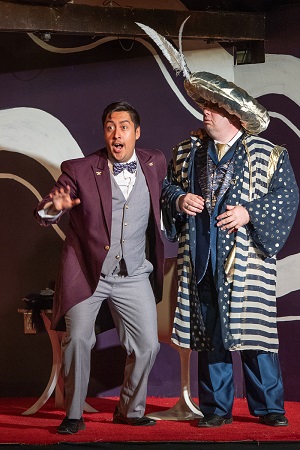 Armando Contreras (Phillipo) and E. Scott Levin (Don Pompoonio). Photo credit: Martha Benedict.
Armando Contreras (Phillipo) and E. Scott Levin (Don Pompoonio). Photo credit: Martha Benedict.
Don Pomponio’s entrance aria was one notably well-crafted solo piece, and E. Scott Levin made the most of the vocal opportunity. Mr. Levin has a sturdy, malleable bass-baritone, and he wields it with precision and authority. He has just the right look for this rich buffo role, although the requisite blustery musical temperament took a bit of time to catch up. After a somewhat “controlled” beginning, he capably eased into more abandoned comic effects, both visual and vocal.
Another memorable moment was Alberto’s plangent Act Two aria, which was suavely, tenderly delivered by tenor Kyle Patterson. Mr. Patterson’s earnest, boyish presence also characterized his exceedingly pleasant singing, complete with accurate, rapid-fire coloratura, which whizzed about effortlessly throughout the range. If Kyle slightly veils his very top notes, they were nevertheless delivered with enough panache to elicit one of the evening’s most enthusiastic ovations.
Messrs. Levin and Patterson also contributed notably to a flashy, rhythmically complex, stuttering trio, ably joined by Armando Contreras (Phillipo). Mr. Contreras is possessed of a strapping baritone, which he deploys with unerring musicianship and fine dramatic understanding. Armando’s complete command of copious, Dandini-esque melismatic passages was commendable for its fiery accuracy and conviction. This same trio also ignited a goofy charisma between the three performers who brought the house down with uninhibited hip bumps, daftly synchronized semaphoric gestures, and flat out unrestrained good singing.
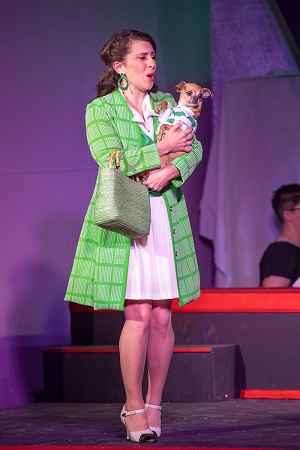 Rachel Policar (Lisetta). Photo credit: Martha Benedict.
Rachel Policar (Lisetta). Photo credit: Martha Benedict.
On the distaff side, Rachel Policar scored a considerable success as the complicated, conflicted daughter-for-sale, Lisetta. Ms. Policar cuts a petite, slender figure on the stage, and her silvery soprano is in the very light lyric Fach. But don’t underestimate her power to communicate spitfire moments, as she zings out roulades and acuti with effortless aplomb. In her main aria, she manages not only a bravura display of florid singing, but does it all while being toted and hoisted around by four chorus boys, at one point being held aloft in a full-flying split. Do not try this at home!
Molly Clementz displayed a plummy mezzo as the man-hunting Doralice. Ms. Clementz has a wonderfully rich tone, gleaming top notes, and a vibrant lower register. While she is not yet quite wholly immersed in the specific Rossinian tradition of presentation, hers is still already an enjoyable role traversal. As Doralice’s manipulative father Anselmo, veteran Phil Meyer’s commanding bass rolled forth with domineering, characterful results.
Mezzo-soprano Jessie Shulman and baritone Scott Ziemann perhaps did all they could in the (for me) extraneous throwaway roles of Madama La Rose and Monsu Traversen, respectively. In these under-written parts, Ms. Shulman nevertheless had effective moments above the staff when she mustered some real oomph to propel her distinctive, diffuse vocal quality. For all Mr. Ziemann’s animated mincing and limp-wristed tic’s, his singing did not match his physical commitment. What I heard was attractive, but I did not always hear him.
The industrious chorus of eight was called upon to do the work of eighty, and man, did they deliver the goods! Whether singing with full-throated abandon, or executing Amy Lawrence’s relentless choreography, or quick-changing costumes numerous times, this energetic group never flagged in their coordinated concentration.
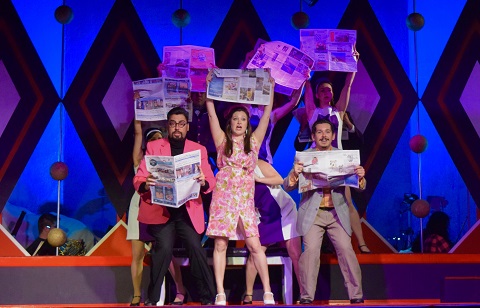 Photo credit: Scott Ziemann (Monsu Traversen), Jessie Shulman (Madama La Rose), and Kyle Patterson (Alberto). Photo credit: Martha Benedict.
Photo credit: Scott Ziemann (Monsu Traversen), Jessie Shulman (Madama La Rose), and Kyle Patterson (Alberto). Photo credit: Martha Benedict.
Director Josh Shaw has invested the proceedings with enough good comic ideas for at least three productions. Designer Josh Shaw has set the show in 1960’s Paris, with eye-popping set elements and brilliant uses of color which add to the manic feel. The hotel lobby is on the main stage with an up center platform backed by four large cutout diamonds, with the check-in desk looming down stage left. The action spills over to house right, onto a platform dressed as the hotel bar.
As visually appealing as is the total look, it felt more like Retro Vegas than 60’s Paris Chic. That said, Maggie Green’s witty profusion of costumes added immeasurably to ground the concept. By the ending tableau with everyone cavorting in glitzy, sparkling, faux Turkish floor show attire, okay, okay, I might just stretch to imagine we could indeed be reveling in the Lido or Moulin Rouge “in the day.”
One promising design element was the well-intended lighting. The prolific and effective use of color did not quite compensate for the recurring dark spots, or infrequent delayed cues. In the bar, there were five stools used for the beautifully performed, rediscovered quintet, but one of the characters was in the dark for the whole segment. Perhaps an instrument was out? This should be an easy adjustment to make for future performances.
Mr. Shaw has fashioned a take-no-prisoners approach to the staging, which was rife with clever touches. The use of revolving chairs was a recurring theme, likewise a kick line or ten. Unison gestures were repeated, inverted, subtracted, added and inverted again. While all of this was meticulously executed, I felt there could have been moments of stillness that would have added variety. During a particularly unrelenting frenzied passage I found myself wanting to say: “Don’t just do something, stand there!” I got my wish in Act II when the material lent itself to a more measured presentation.
Brooke deRosa conducted with stylistic acumen, in a reduced orchestration of her own creation. In spite of the sprawling playing space and the supreme challenge of the musical complexities, Maestra deRosa commanded her forces with admirable precision. While the ten instrumentalists displayed good individual talent and a conscientious approach, at the premiere they experienced a few scrappy ensemble moments. Too, they sometimes ran out of aural steam in musical playoffs. Perhaps reordering their placement behind the set, putting the strings forward and the winds in the rear would even out the sound a bit more.
To the cheering, capacity audience, none of this nitpicking mattered, of course. The crowd was fully engaged from first to last. In addition to the charming performance, the opera-going experience included table seating, a charcuterie platter, and a bottle of wine. Pacific Opera Project has evidently hit on a winning formula for a night out, serving up food, drink and an operatic discovery in equal measure.
POP will be broadcasting the final performance (Saturday, July 7 at 8:00 pm PDT) on Facebook Live.
James Sohre
Rossini: La Gazzetta
Don Pomponio: E. Scott Levin; Lisetta: Rachel Policar; Phillipo: Armando Contreras; Alberto: Kyle Patterson; Doralice: Molly Clementz; Madama La Rose: Jessie Shulman; Monsu Traversen: Scott Ziemann; Anselmo: Phil Meyer; Conductor: Brooke deRosa; Director and Designer: Josh Shaw; Choreographer: Amy Lawrence; Costume Designer: Maggie Green; Continuo: Zach Neufeld
Image=http://www.operatoday.com/Rachel%20Policar%20%28Lisetta%29%2C%20E.%20Scott%20Levin%20%28Don%20Pomponio%29%2C%20Kyle%20Patterson%20%28Alberto%29%2C%20Armando%20Contreras%20%28Fillipo%29%2C%20Molly%20Clementz%20%28Doralice%29.jpg
image_description=La Gazetta, Pacific Opera Project
product=yes
product_title=La Gazetta, Pacific Opera Project
product_by=A review by James Sohre
product_id= Above: Rachel Policar (Lisetta), E. Scott Levin (Don Pomponio), Kyle Patterson (Alberto), Armando Contreras (Fillipo), Molly Clementz (Doralice)
Photo credit: Martha Benedict
Dangerous Liasions : Music and dance in the French Baroque
More than 40 extracts, primarily from Lully and Rameau, were chosen to form a highly original compilation, unfolding in thematic sequence : Idyllic Delight, Seduction, a Ballet des Fleurs, Vexation, Loss and Despair, Frolics and Mischief, with Reconciliation, the happy ending. It's quite an achievement to put together more than 40 disparate extracts so they flow together naturally, yet with much variety. Like Le Concert Royal de la Nuit, (more here) this cohered well, an excellent summary of style and content. Much admiration is due to the OAE's Principal Flute Lisa Beznosiuk, who curated this with the support of an OAE team and Hubert Hazebroucq, who choreographed the dancing in period style. This was also an exercise in French declamatory song style, with period (not modern) pronunciation, so credit is due, too, to soloists Anna Dennis and Nick Pritchard. Conducted by John Butt, the OAE were in vivacious form : a delightful two and a half hours which passed all too quickly.
Like a prologue to a drama, the OAE began with Lully's Overture from Le Triomphe de L'Amour, followed by six miniatures, four from Lully's Thésée (1675) "Aimons tout nous y convie, on aime ici sans danger". Notice the archaic language, which did mater, since it complemented the stylised, idealised sentiments in the text, and in this context reminded us that the world of the baroque needs to be understood on its own terms. Thus the dancing, very different to what we take for granted today. Like the art of fencing, dance prepared young noblemen with skills much needed in Court circles : physical fitness, mental discipline, alertness to strategy and form and an awareness of elegant presentation. Thus the stances - hands and feet held at angles, foot positions which would have developed formidable muscles, enabling the dancer to control his position until he was ready to execute swift, decisive changes. The formal patterns of dance also reflected concepts of social and cosmic order, the individual functioning as part of an ensemble.
Hazebroucq's choreography is based on extensive archival research but also on the relationship between dance and music, so fundamental to the baroque aesthetic. Lully didn't conduct with a staff for nothing : he was (literally) beating time, creating a percussive foundation for music that was made to be moved to. Hence the vigorous rhythms and exuberance, at times reminiscent of military marches and fanfares. Period instruments pack an earthy punch, horns and percussion evoking instruments from even more archaic times, complementing the baroque fascination with classical antiquity. The stringed instruments, plucked or bowed, added variety and character, sometimes providing continuo, or embarking on flights of inventiveness. Seeing the dancers move in close relation to the music enhanced understanding of the musical logic.
Thoughtfully, this Liaisons Dangereuses (like the novel that is told in letters, not narrative), interleaved an extract from Lully's Les Noces de Village (1663),between the pieces from Lully's Thésée. Philinte and Climene are idealised shepherd and shepherdess, more personable than the more stylised, abstract evocations of love in Thésée. This also served to show that court dance, even when inspired by pastoral fantasy, was not folk dance but far more sophisticated. The second section, "Seduction", combined extracts from André Campra's L'Europe Galante (1697) and Lully's Le Bourgeois Genthilhomme (1670),, the vaguely "Spanish" allusions adding exotic spice, to the dancing as much as to the music. In the Interlude, a "Ballet des Fleurs" , the dancers enacted an allegory in which three figures interact as lovers and rivals, eventually finding reconciliation. This is an allegory in music, too, combining Gavottes and Airs sourced from Rameau's Les Indes Galantes and Lully's Atys (1676), allowing the dancers ample room for elegant, intricate patterns of movement. The section "Vexation" was based on Lully's Armide (1686), where the sorceress Armide tries to seduce Renaud. Anna Dennis was particularly impressive in this splendid role with Nick Pritchard her foil, dancers in black, the orchestra conjuring up a storm..
The section "Loss and Despair" began with the Prelude from Charpentier's Orphée descendant aux enfers (1684) setting the scene. An extract from Lully's Ballet royal de la Naissance de Venus (1665) prepared the way for Orpheus "Tu ne la pendras point, hélas, pour me le rendre" and Proserpine's "Courage Orphée, étale ici les plus grands charmes", also from Charpentier's La descent d'Orphee aux Enfers depict the Underworld. But love itself does not die. Venus (Anna Dennis) sang "Amiable Vainqueur" from Campra's Hésione (1700), neatly connecting the Orpheus legend with a tragédie en musique with characters from other parts of classical mythology. "Love that is strong enough can "Désarmer le Dieu de la Guerre: le Dieu de la Tonnere" evoked by the wind machines, crashes of percussion and baleful brass in the orchestra. After the tumult, fantasy and fun. From Rameau's Platée (1745) a satire, and a parody from Jean-Joseph Mouret's Les Amours de Ragonde (1714) In the former, the gods squabble, causing invertebrates and mortals to fall in unrequited love. In the latter, couples end up mismatched. Colin, who ends up wed to his would be mother in law sings mock peasant dialect "Je ne songeons qu'uà bien aimer, je rougirions d'être volage". Warped humour, the opposite of idealised courtly love, but an opportunity to see the dancers imitate folksy jigs and "exotic" dances. But all is resolved in the final tableau, Reconciliation. Eglé and Mercury sort out their differences in a dialogue from Rameau's Les Fêtes d'Hébé (1739) and Calatée, Mercure, Zoroaster and Amelite sort out theirs in Rameau's Zoroastre (1739).
Anne Ozorio
image=https://upload.wikimedia.org/wikipedia/commons/thumb/f/f6/Armide_Lully_by_Saint-Aubin.jpg/512px-Armide_Lully_by_Saint-Aubin.jpg
image_description=
product=yes
title=
product_by=Dangerous Liasions : The Orchestra of the Age of Enlightenment, Anna Dennis, Nick Pritchard, Les Corps Éloquents (Hubert Hazebrouq, choreographer), Queen Elizabeth hall, London. 26th June 2018. A review by Anne Ozorio
product_id=Above: -Armide_Lully_by_Saint-Aubin
June 27, 2018
Lessons in Love and Violence at the Holland Festival: Impressive in parts
Dutch National Opera, one of the work’s seven (!) co-producers, is hosting the production. Benjamin’s new opus impresses with its orchestral texture and the production boasts deluxe visuals and top-drawer performances. But Crimp’s dialogue renders the characters elusive and the score loses theatrical momentum after a strong first half.
Lessons is loosely based on Christopher Marlowe’s historical play Edward II. The plot’s motor is the King’s politically disastrous relationship with his despised favorite, Piers Gaveston. Crimp distills the drama around four main characters: the King, Queen Isabel, Gaveston and the rebel lord Mortimer. After masterminding Gaveston’s death, Mortimer teams up with Isabel to depose the King in favor of his son. The boy king then brutally repays Mortimer for his lessons in ruthless statesmanship. Split into seven scenes, the plot explores the conflict between personal relationships and the responsibilities of power. The libretto specifies different locations, but director Katie Mitchell stages every scene in the King’s bedroom. The handsome set, decorated with Francis Bacon paintings, a reference to Edward’s patronage of the arts, and a tropical aquarium, shifts to reveal different angles of the room. It looks wonderful, but anchoring the plot in a single space has an alienating effect. Mitchell creates further emotional distance between the stage and the public by casting the royal children as constant observers, although this could be Crimp’s directive. Sleek-voiced tenor Samuel Boden as the Boy and Ocean Barrington-Cook, eloquent in the silent role of the Girl, are privy to the most intimate and lacerating interactions between their parents, Gaveston and Mortimer. Seeing them observe and absorb their dubious lessons turns us spectators into clinical observers.
Crimp’s conversations also seem designed to discourage emotional involvement. His pairs of questions and answers sound like wisps of Socratic dialogue. Feelings are hinted at, personalities remain undeveloped. Stéphane Degout’s baritone flowed like dark honey but his words never conveyed who the King really is. He is in thrall to his controlling lover Gaveston, but why? That Isabel emerges as the most clearly delineated character is certainly thanks to Barbara Hannigan’s consummate artistry, but also because her high-lying music, tailored to Hannigan’s strengths, has a distinctive imprint. One of the opera’s best scenes is the nocturnal duet between Isabel and the King. Gaveston has been killed and their relationship has reached its breaking point. Hannigan’s penetrant soprano twisting up into florid hysteria above Degout’s mellifluous misery presented a striking contrast to the prevalent bas-relief of singing imitating speech rhythms. Benjamin gives most of the big, dissonant climaxes to the orchestra. Several of these come, predictably after a while, in the interludes that facilitate scene changes. A most welcome exception was the tautly constructed vocal ensemble as Mortimer has Gaveston seized at a private entertainment. The mix of high and low voices within the orchestral cyclone was the dramatic high point of the performance.
Another big ensemble would have made the suffering of the population more palpable. Instead, two soloists emerge from a crowd of actors and plead with Isabel, who responds by provokingly dissolving a pearl in vinegar, à la Cleopatra. However fierce their interventions, soprano Jennifer France and mezzo-soprano Krisztina Szabó could not, on their own, convey nation-wide unrest. Since the whole plot hinges on the political consequences of what goes on in the King’s bed, those bedroom walls cried to be knocked down by a huge chorus. While the singing only sporadically reflects the savagery of the violence, and the little love in evidence, the writing for the orchestra is highly dramatic. Benjamin stirs up an atmosphere doused in cold sweat, with threatening strings and rumbling brass. Low instruments predominate, resonating in a deep, multilevel darkness, with the occasional flute darting about in short neurotic figures. Only the composer can say if the Netherlands Radio Philharmonic produced the sounds he had in mind, but they seemed concentrated and responsive to his conducting. The orchestral fabric sounded rich and vibrant throughout, from the bare eeriness of the cimbalom and harp to the density of the looming string figures.
Since the best scenes occur in the first half, the rest suffers by comparison. In spite of accomplished performances, especially from the excellent Peter Hoare as Mortimer, the appearance of an insane pretender to the throne made little impact. The Madman, bass-baritone Andri Björn Róbertsson, and everyone else, seemed to be repeating the same vocal patterns used earlier. Two short monologues slow things down without adding any insight. First Gaveston, sung by Gyula Orendt, appears to the King looking like himself, although he is, in fact, Death, and summarizes the events we’ve just witnessed. Orendt’s slim baritone did not project enough foreboding to justify this exposition. In the final scene the Boy does the same thing all over again. After several big orchestral crescendos, the ending is a musical anticlimax – a surprising musical device, but also something of a dramatic comedown. There are many fine elements in Lessons in Love and Violence. It feels unfair that the whole does not equal the best of its parts.
Jenny Camilleri
George Benjamin: Lessons in Love and Violence
King - Stéphane Degout; Isabel - Barbara Hannigan; Gaveston/Stranger - Gyula Orendt; Mortimer - Peter Hoare; Boy/Young King - Samuel Boden; Girl - Ocean Barrington-Cook; Witness 1/Singer 1/ Woman 1 - Jennifer France; Witness 2/Singer 2/ Woman 2 - Krisztina Szabó; Witness 3/Madman - Andri Björn Róbertsson. Director - Katie Mitchell; Set and Costume Designer - Vicki Mortimer; Lighting Designer - James Farncombe; Movement - Joseph Alford. Conductor - George Benjamin. Netherlands Radio Philharmonic Orchestra. Seen at Dutch National Opera & Ballet, Amsterdam, on Monday, 25th of June, 2018.
image=http://www.operatoday.com/Lessons-in-Love-and-Violence.png image_description=Scene from Lessons in Love and Violence [Photo © Hans van den Bogaard] product=yes product_title=Lessons in Love and Violence at the Holland Festival: Impressive in parts product_by=A review by Jenny Camilleri product_id=Above: Scene from Lessons in Love and Violence [Photo © Hans van den Bogaard]June 26, 2018
The Turn of the Screw: ENO at Regent's Park Theatre
The spiky shards and rusting scaffold of the attic of designer Soutra Gilmour’s gothic summer-house point their confrontational fingers towards the thick green tree-tops and ever-darkening sky above the ‘woodland auditorium’. The house is a potent symbol of the neglect of which the children’s guardian is guilty, and of the moral danger to which this ethical irresponsibility exposes his two charges. Indeed, there’s physical danger too, for the set is formed of twisting ladders, roof-top perches and planked pathways which skirt and lead down to the tangled canes beside the imagined lake - bringing to my mind the reed beds of Snape Maltings, though beside the River Alde the whispering swoosh of the wind and the cool cry of the curlew have none of the aura of decay and peril that the rustling leaves and fleeting bird-song conjure here.
Director Timothy Sheader, the artistic director of Regent’s Park Theatre, leaves us in no doubt of the presence of evil and menace - the dilapidated piano and lop-sided chalk-board embedded in the undergrowth seem to undermine the notion that the children are to receive any ethical or educational instruction at Bly - but he might perhaps have been wise to have paid more heed to Henry James’s own words, ‘Make [the reader] think the evil, make him think it for himself, and you are released from weak specifications’ (‘Preface’ to the Turn of the Screw).
For, it’s the withholding of knowledge and certainty, the prevalence of secrets, the refusal to elucidate ‘meaning’ which makes James’s novella so chillingly disconcerting. It’s true that Britten does ‘fill in’ some of James’s gaps, particularly in determining that the ghosts should sing (and surely they should, if they are to be a driving musico-dramatic force and not simply Freudian intimations or projections of the Governess’s psycho-neurosis). While James was concerned with ‘causing the situation to reek with the air of Evil’ rather than with ‘having my apparitions correct’, according to Lord Harewood, Britten was adamant that the haunting should be ‘real’ rather than a product of the Governess’s paranoia. But, it’s hard to believe that the composer imagined that his ghosts would walk amongst the seated audience, undeniably corporeal.
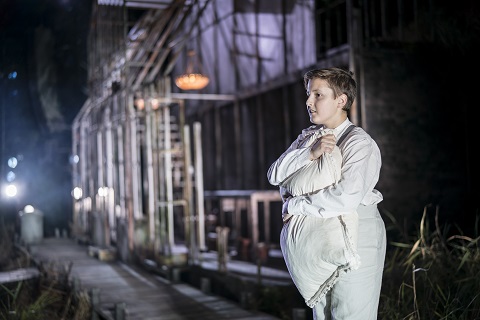 . Daniel Alexander Sidhom as Miles. Photo credit: Johan Persson.
. Daniel Alexander Sidhom as Miles. Photo credit: Johan Persson.
Sheader risks inciting the criticism which The Times made of the 1954 premiere in Venice: that the ghosts were ‘two too solid stage villains’. This Quint is a solid physical presence whose rugged vulgarity is emphasised by an ugly red wig and beard. Moreover, his first calls to Miles, which emanate from the top-rear of the auditorium, are too firm and present - a consequence of the amplification of this production which frequently shatters the music’s inherent intimations and subtleties and upsets the balance between singers and instrumentalists. I missed the unearthly beauty of Quint’s vocal arabesques, as audience heads swivelled and strained to see from whence the strong voice arose: the point is, surely, that it springs unbidden but welcome from an unexplained shadow world - its presence heralded by the ornamental gestures, pentatonic sweeps and exotic colourings of the scene’s instrumental preface. It doesn’t help that a scene titled ‘At Night’ takes place in sun-drenched daylight (despite the shifting of the original start time to achieve a more ambient coincidence of narrative and setting). I began to reflect on Deborah Warner’s ROH production, twenty years ago now, when Ian Bostridge’s creepy, even ghastly, Quint emerged from the dense, mist-ensconced thickets, and it was hard to know what was real or imagined, inside or outside.
Miss Jessel was similarly corporeal - and, heavily pregnant, presumably by Quint (as is hinted in James’s tale when Mrs Grose tells the Governess that despite their difference in rank and position, there was ‘everything’ between them, and that, after that ‘She couldn’t have stayed. Fancy it here - for a Governess!’). Heavily made up, with gothic eye-shadows, draped in heavy green and purple which seems stained with pond-weed, her hands mud-streaked, this former governess looked as if she had been dredged up from lake in which she might have drowned.
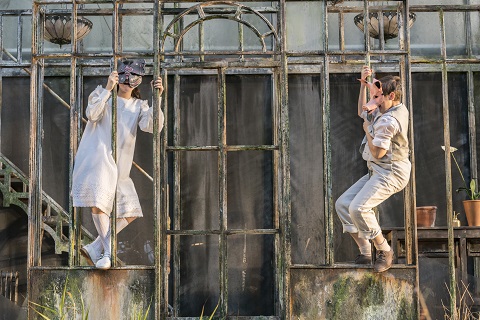 . Elen Willmer and Daniel Alexander Sidhom as Flora and Miles. Photo credit: Johan Persson.
. Elen Willmer and Daniel Alexander Sidhom as Flora and Miles. Photo credit: Johan Persson.
Some of Sheader’s ‘realism’ is effective, mostly that which pertains to the characterisation and relationship of the two children, Miles and Flora. Mischievous and boisterously fun-loving, they prepare for their new ward’s arrival by exuberantly practising their bows of greeting - and emptying flower-pots on their heads and drawing on the misty window panes. Gradually their games become ‘darker’, as they taunt each other with worms, race about and venture into the night with a confident abandon that might easily escalate into the violence of Lord of the Flies.
Sheader establishes their strong identification with the two ghosts: Miles puffs nonchalantly on a toy pipe; Flora plays with her long plait that imitates Miss Jessel’s fairy-tale, knee-length rope of hair. Wiping away the Latin conjugations which his Governess wishes him to practise, Miles draws two smiling stick-men, one large, one small, a none too subtle suggestion of allegiance.
When the letter arrives informing her that Miles has been dismissed from his school - a ‘shocking’, ‘unclean’ place, James’s Governess infers - she burns it; later, Miles carries out his own nocturnal immolation - what ‘shameful’ items does he incinerate? - and it is at this point that Quint calls to him, prompting young Miles to whip off his clean white suit and don a scruffy shirt, presumably once belonging to Quint. As Quint joins him on the lake-side platform, Miles hugs his chest, leaps and swirls, and grins with glee: certainly, freedom, discovery and fulfilment are what Quint offers - “In me secrets and half-formed desires meet. […] I am the hidden life that stirs when the candle is out.” - but Sheader seems to state with no ambiguity that it is sexual initiation that Miles is proffered and covets.
The earliest critics did not like this scene: Colin Mason, writing in The Guardian (15th Septembherer 1954), decried the expansion of the ‘episode with Miles on the lawn at night’ into ‘a quartet in which the relationship between the children and the ghosts is made crudely explicit’. In fact, here, Elen Willmer’s Flora shows great discipline in avoiding catching Miss Jessel’s eye as her former governess lunges towards her, coming centimetres within touching distance (librettist Myfanwy Piper’s stage directions indicate that Flora should ‘silently and deliberately turns around to face the audience away from Miss Jessel’). And, more successfully, in Act 2 Scene 6, ‘The Piano’, Quint arrogantly places a music-score on the piano and then reclines against the instrument, only raising himself to turn to a new page in the music, as Miles performs his parodic recital - leaving us in no doubt whose tune Miles is singing, whose song he imitates.
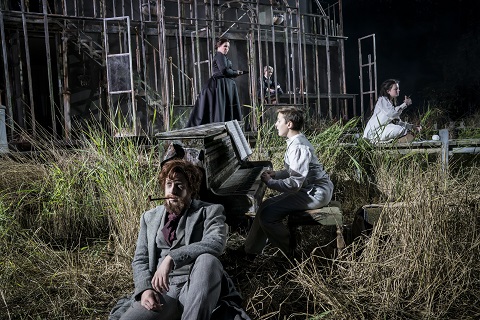 . Elgan Llŷr Thomas as Peter Quint and Anita Watson as The Governess, with Daniel Alexander Sidhom and Elen Willmer as Miles and Flora. Photo credit: Johan Persson.
. Elgan Llŷr Thomas as Peter Quint and Anita Watson as The Governess, with Daniel Alexander Sidhom and Elen Willmer as Miles and Flora. Photo credit: Johan Persson.
Just as the relationships between the children and ghosts seem unequivocally real and intense, so the suggestiveness of the instrumental parts is lost owing to the amplification of the musicians. Seated within the ruined glass-house, there is an opportunity for the musicians to serve as ghostly presences, intimated by elusive, often erotic, lyricism; but, the over-amplification sends percussive thumps, the horn’s statement of the ‘screw theme’, and the delicate traceries of harp and celeste in ‘At Night’, booming around the auditorium. And, as dusk finally falls, two hanging lights within the glass-house illuminate the players with all too clear definition.
There are two casts for the nine performances. It is common to assign a single tenor to perform the Prologue and the role of Peter Quint - Peter Pears took both roles at the first performance - which has the advantage of further increasing the ambiguity of James’s tale. Here, William Morgan and Elgan Llŷr Thomas sing both parts but take only one each in any one performance, switching roles with the changing casts. On this occasion, Morgan opened proceedings, delivering the Prologue in casual modern dress from amid the audience stalls, and extending a relaxed invitation into the narrative, though one that seemed too detached from the piano accompaniment which articulates the motifs of the ensuing musical narrative. Notwithstanding the aforementioned over-emphatic presence that results from the amplification, Llŷr Thomas’s muscular, firmly defined tenor captured Quint’s viciousness and angry resentment; he was similarly imposing physically - no wonder Miles was idolatrous and intimidated in equal measure. Elin Pritchard’s Miss Jessel was more other-worldly, and the luxurious richness of her soprano hinted at forbidden, transgressive passions; the scene in which she intrudes into the schoolroom and places herself at the Governess’s desk was frighteningly threatening.
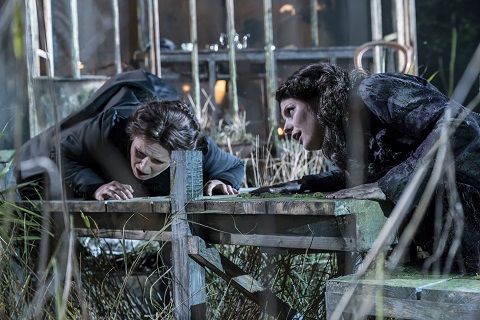 . Anita Watson and Elin Pritchard as The Governess and Miss Jessel. Photo credit: Johan Persson.
. Anita Watson and Elin Pritchard as The Governess and Miss Jessel. Photo credit: Johan Persson.
As the Governess, Anita Watson sang with a beautifully sweet tone and finely, entrancingly nuanced phrasing; her words - there were no surtitles though copies of the libretto were supplied - were as crystalline as her conception of her own ‘mission’. But, while there was a strong sense of the Governess’s growing fear, I did not feel that this deluded ‘innocent’ was aware of her own culpability in the ensuing tragedy - this surely necessary if her final line, “What have we done between us?”, is to make sense? She should be firmly centred in a morally ambiguous middle-ground, but here seemed rather too sympathetic, against the obvious malevolence of the ghosts. And, Mrs Grose, sung with impressive musical composure and dramatic credibility by Janis Kelly, seemed to share this sympathy with the potential hysterical Governess, appearing never to challenge her even when it is implied that it is the Governess who terrifies Flora, not Miss Jessel at all, as the young girl begs Mrs Grose, “Cruel, horrible, hateful, nasty! We don’t want you! Take me away, take me away from her!”
Daniel Alexander Sidhom and Elen Willmer were tremendous as Miles and Flora; their expressive faces and utterly natural acting made the children believably and worryingly unpredictable and ‘uncontrollable’, beneath the veneer of polite conventions and mores, and their vocal lines were confidently and persuasively delivered.
Perhaps this review hasn’t fully conveyed the strong narrative propulsion of this production: while it may lack the suggestive inference of the most subtle and ghostly readings of the score, it is sincere, attentive to detail and tells the tale clearly. The singing is superb and one sensed that every member of the capacity audience was spellbound if not spooked. I just wish that Sheader had avoided some of James’s ‘weak specifications’ and trusted in the equivocal erotic suggestiveness of Britten’s music.
Claire Seymour
Britten: The Turn of the Screw
Prologue - William Morgan, Peter Quint - Elgan Llŷr Thomas, Governess - Anita Watson, Mrs Grose - Janis Kelly, Miss Jessel - Elin Pritchard, Miles - Daniel Sidhom, Flora - Elen Willmer; Director - Timothy Sheader, Conductor - Toby Purser, Designer - Soutra Gilmour, Movement Director - Jenny Ogilvie, Lighting Designer - Jon Clark, Sound Designer - Nick Lidster for Autograph, Season Associate Director (Voice) - Barbara Houseman, Fight Director - Paul Benzing, Orchestra of English National Opera.
Regent’s Park Theatre, London; Monday 25th June 2018.
image=http://www.operatoday.com/AW%20Gov.jpg image_description=The Turn of the Screw: ENO & Regent’s Park Theatre product=yes product_title=The Turn of the Screw: ENO & Regent’s Park Theatre product_by=A review by Claire Seymour product_id=Above: Anita Watson (The Governess)Photo credit: Johan Persson
June 25, 2018
Die Entführung aus dem Serail at The Grange
Kiandra Howarth sang as fine a Konstanze as I have heard, Christine Schäfer included, coloratura clear and meaningful, line finely spun. Humanity breathed into her character was Mozart’s - yet hers too. Daisy Brown’s spirited Blonde offered virtues similar yet far from identical; there was no difficulty in distinguishing the two soprano roles, style and delivery complementary yet distinctive. Much the same might be said of the two tenors, Ed Lyon and Paul Curievici. Lyon’s dignified, yet heartfelt Belmonte and Curievici’s quicksilver Pedrillo offered complementary nobilities, alert to distinctions of social order whilst also suggesting that they - we too - should not be bound by them. And so, in the case of duets and ensembles, indeed of questions and responses, the vocal ingredients were prepared, ready to blend, yet also to retain their individual flavours: which they did. Jonathan Lemalu’s Osmin offered similar virtues from ‘outside’ the charmed European circle, as it were: more contrast, than complement. All handled dialogue well - even if it suffered, as still more did the rest, from a ‘translation’ into English, often very loose indeed, by David Parry: a translation apparently more concerned to draw attention to itself with ‘amusing’ rhymes than to permit the drama to unfold.
Alas, there was little to cheer in the rest. The strange decision to translate - there were English titles - was one thing; more seriously, John Copley’s new (?!) production seemed stuck in a misremembered 1950s. An Entführung, sorry Abduction, for Brexit? There was certainly little in the way of diversity amongst the audience. More bizarrely, it registered not a jot that this is an Orientalist opera concerned with a purported clash between European and Ottoman civilisations; such was neither portrayed nor deconstructed. Nor, however, was anything put in place of that admittedly problematical clash. We saw neither an exploration of what human ‘love’ might or might not mean, as in Calixto Bieito’s Berlin staging or Stefan Herheim’s exhilarating total reinvention of the work - minus the Pasha - for Salzburg, nor any sense of the dark sadomasochism (‘Martern aller Arten…’) both directors and others have explored. I am not sure I could imagine anything less erotic if I tried - and I certainly do not intend to try.
It was as if this were just a terribly unfunny comedy chosen for an end-of-term school play: nothing to scare away the parents, yet nothing to attract them either. The æsthetic, such as it was, seemed very much ‘school play’ - unironically so. It was not so much that Copley had no concept, nor a question of ‘traditionalism’ or otherwise; it was about a fruitless search for drama ending in watching some people in vaguely ‘exotic’ costumes walk around a stage. Even David McVicar’s determinedly anodyne production for Glyndebourne seemed deep by comparison. One at least had the sense that McVicar might, for the sake of ‘entertainment’, have been knowingly evading the issues rather than remaining blissfully unaware of them. This might have been directed by Andrea Leadsom, although not #asamother.
Jean-Luc Tingaud’s conducting proved no more revealing. Mostly hard-driven, with occasional arbitrary slowing (presumably for ‘expression’), it again had one wondering what the fuss might all be about when it came to the operas of Mozart. (My companion, a highly experienced and reflective opera-goer, commented that, had this been her first encounter, it would most likely also have been her last.) On the occasions that the woodwind of the Bournemouth Symphony Orchestra managed to break a little free, they sounded delectable. Again, however, the drama remained entirely vocal.
Mark Berry
Mozart: Die Entführung aus dem Serail, KV 384
Pasha Selim: Alexander Andreou; Konstanze: Kiandra Howarth; Blonde: Daisy Brown; Belmonte: Ed Lyon; Pedrillo: Paul Curievici; Osmin: Jonathan Lemalu. Director: John Copley; Designs: Tim Reed; Lighting: Kevin Treacy. Grange Festival Chorus (chorus master: Tom Primrose)/Bournemouth Symphony Orchestra/Jean-Luc Tingaud (conductor).
The Grange, Northington, Hampshire, 24 June 2018
Image=http://www.operatoday.com/Alexander%20Andreou%20%28Pasha%20Selim%29_The%20Abduction%20from%20the%20Seraglio_The%20Grange%20Festival%202018%20%C2%A9Simon%20Annand%20%281%29.jpg image_description=Die Entführung aus dem Serail:The Grange Festival 2018 product=yes product_title=Die Entführung aus dem Serail:The Grange Festival 2018 product_by=A review by Mark Berry product_id= Above: Alexander Andreou (Pasha Selim)Photo credit: Simon Annand
June 24, 2018
Cave: a new opera by Tansy Davies and Nick Drake
Does the nature of a venue shape one’s experience of a work, or is it inconsequential? Obviously, there are practical factors that may influence one’s response - the acoustic, sight-lines, distance between audience and performers, even the degree of physical comfort or discomfort - and external atmosphere can certainly seep and diffuse into one’s inner experience. Lowering skies over a whipped up North Sea, the bite of a brisk breeze and the salty tang of the ocean might melt away the years between a present-day fishing town and George Crabbe’s early nineteenth-century Borough.
I mention these matters because Cave, a new opera by Tansy Davies, with a libretto by Nick Drake, produced by the London Sinfonietta in association with The Royal Opera, led me to reflect on issues relating to site-specific performances, such as the relationship between musical and architectural form, the dialogue between form and function, the potential longevity of works designed for specific places.
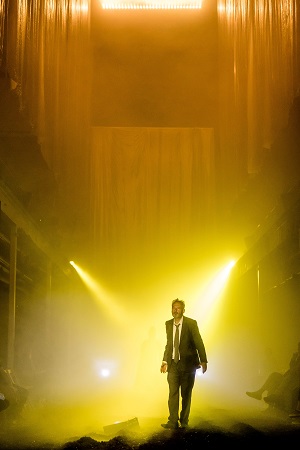 Mark Padmore as Man. Photo credit: Manuel Harlan.
Mark Padmore as Man. Photo credit: Manuel Harlan.
It’s hard to imagine a more fitting venue in which to present Cave than Printworks, the former south-east London home of a newspaper printing-press which has been transformed into an events venue comprising six cavernous spaces, arranged over multiple levels connected by a corridor-maze. It was once Western Europe’s largest print facility, spread over 119,200 square feet, and entering into its vastness - the cathedral-like ceilings arch up into infinite darkness, strange slippery echoes take one unawares, lights starkly challenge and shadows flicker hauntingly - was slightly disorientating. The walls had been hung with shifting white fabric and a river of floor-lights guided us through the darkness into this immersive twilight zone, the very fabric of which seemed woven into Cave, a near-future dystopia of post-apocalypse barrenness and loneliness.
Drake’s libretto - or perhaps poem would be a better term - is set in a world devastated by climate change and communicates the grief of a father who enters an underground spirit world in a quest to connect with his daughter, Hannah, who is ‘lost’. Dead or simply missing, it’s not clear. Indeed, uncertainty seems the only certainty in this half-world. As Davies explained in a recentinterview, “ Cave is about Skin. The skin between life and death, the skin between humans and animals, the relationship between father and daughter. The cave goes through several phases of being imagined by the father whose lost his daughter and he’s remembering her. There’s a sense of things being apparently there, but not there. Half-there you might say.”
Subsumed into the darkness of the cave, the father reminisces on the world’s tragic tipping-point and mourns ‘the extinction of colour’. His dreams of re-birth, of enchanted forests, are severed by the roar of war-planes. Shadows tower threateningly as he is engulfed by a hysterical fear which destroys language, until one shadow transforms into a tree which provides peace and shelter. And, it is here, through memory, that he re-connects with Hannah, whose tattooed arm attests to her ‘courage’ as clearly as her words convey the certainty of her faith in regeneration. When she departs, a storm breaks, literally and in his heart, but the water is restorative and forms a running river which bears him into the future, to “begin again/ With your voice/ In mine -”
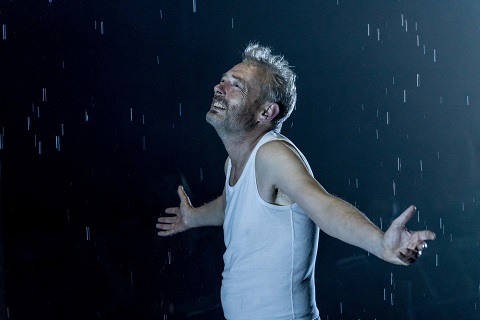 Mark Padmore as Man. Photo credit: Manuel Harlan.
Mark Padmore as Man. Photo credit: Manuel Harlan.
Cave was inspired by visits which the composer and librettist made to the Cave of Niaux in Southern France, on the floor of which is a dry river bed, which led them to explore the historic significance of caves for humans, as ritual and communal spaces for sharing culture and knowledge. If there is no ‘plot’ in a traditional sense, and equivocation and liminality are at the opera’s core, then there is certainly a clear ‘message’, that nature is a healing force in the face of human suffering and despair. Davies comments, “Cave is also about the relationship we have with nature. The performance isn’t just about grief and loss. It’s about gaining through wisdom.”
It’s a message that was communicated too in Davies and Drake’s first collaboration, Between Worlds (premiered at the Barbican in 2015), a similarly poetic drama which placed the events of 9/11 within human experience and suffering. Occasionally, though, Drake’s ecological evangelism is expressed with a little too much blunt ideological fervour. Hannah avows, “I want to do something/ About the disaster we’ve made”, just as Davies declares that she and Drake “both want to try and achieve a better world”, genuinely worthy sentiments which might seem naively idealistic, just as Hannah’s condemnation of “This insane exploitation/ Of people and Nature -/ For what? So we can have 4x4s?/ And holidays in the sun/ And peaches in winter?” and her ‘solution’, “We have to imagine/ A humbler way to belong together -”, seems simplistic in the face of the depth and complexity of modern-day challenges.
Despite this, director Lucy Bailey’s presentation of this one-hour opera was as compelling as Davies’ score, which crept delicately and hauntingly above and around the audience, was hypnotically beautiful. Designer Mike Britton placed the audience on tiers which stretched along an extended central galley, a mulchy undergrowth of chippings and mud, the ends of which were bathed in lighting designer Jack Knowles’ mood-changing colours. Shadows shifted and loomed, before slipping into the surrounding darkness.
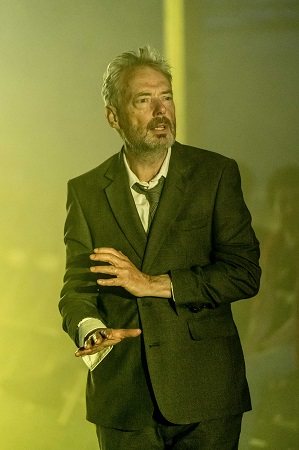 Mark Padmore as Man. Photo credit: Manuel Harlan.
Mark Padmore as Man. Photo credit: Manuel Harlan.
Conductor Geoffrey Paterson and six members of the London Sinfonietta were assembled at one end, from which floated Davies’ delicately embroidered sound-scape. As the low resonations of the bass clarinet and contra-bassoon swirled around the harp’s high pure intonations, embraced by electronic stutterings and swoons, it was as if Printworks had become a repository of a primordial language which was both intuitive and imaginative, brutal and beautiful. I’m not sure that the music ‘articulated’ the words in any direct way but it powerfully evoked another world, beyond words, as Davies herself described: “In Cave we discover a portal into an ancient belief-system where humans understood life through interacting with nature much more.”
More than the music’s drama and delicacy, though, it was the performance of tenor Mark Padmore as the questing protagonist which made Cave so gripping. Padmore’s commitment, vocal and physical, was astonishingly intense and unwavering, from his first dishevelled entrance, clutching a briefcase which he would later set alight, to the transfiguration of his departure via the lost river. Whether lyricising or crooning, speaking or howling, clapping or whistling, every utterance was delivered with care and sensitivity; and, the purity of his voice was immensely touching, creating credibility and empathy for a character whose situation and intent might seem distanced from our own experiences. One could only admire the stamina and focus required to sustain this throughout the man’s soul-changing experiences - which included stripping off his tatty suit, being drenched by the storm, and curling up in the damp compost.
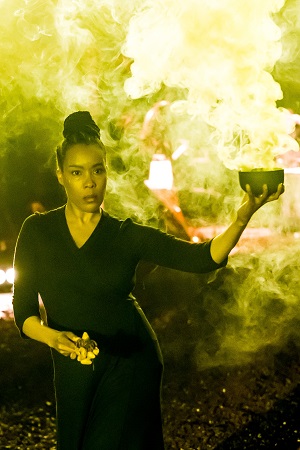 Elaine Mitchener as Hannah. Photo credit: Manuel Harlan.
Elaine Mitchener as Hannah. Photo credit: Manuel Harlan.
As Hannah and the ‘Voice’ which echoes through the cave and in the man’s memory, mezzo-soprano Elaine Mitchener demonstrated vocal versatility, smoothly stretching across registral leaps, her enunciation of the short, often speech-like melodic fragments fluent and natural. Akilah Mantock danced gracefully as the young Hannah who runs through the man’s memories.
Emerging from the enveloping intimacy of this performance and stepping onto the mundane streets of Canada Water, still sunlit in the early evening, was as unsettling as entering Printworks’ vast cavern had been one hour earlier. Davies describes her creative engagement with the venue as being like ‘playing a duet with the space’; site and sound had truly communicated as one.
Claire Seymour
Tansy Davies: Cave (with a libretto by Nick Drake)
Mark Padmore (tenor), Elaine Mitchener (mezzo-soprano), Akilah Mantock (young Hannah); Lucy Bailey (director), Geoffrey Paterson (conductor), Mike Britton (designer), Jack Knowles (lighting designer), Sarah Dowling (movement director), Sound Intermedia (sound design), London Sinfonietta (Timothy Lines - clarinet/bass clarinet, John Orford - contra-bassoon, Michael Thompson - horn, Jonathan Morton - violin, Enno Senft - double bass, Helen Tunstall - harp).
Printworks, London; Wednesday 20th June 2018.
image=http://www.operatoday.com/Cave%20production%20image%20%28C%29%20London%20Sinfonietta%20and%20ROH.%20Photo%20by%20Manuel%20Harlan.jpg image_description=Cave: London Sinfonietta & The Royal Opera House product=yes product_title=Cave: London Sinfonietta & The Royal Opera House product_by=A review by Claire Seymour product_id=Above: Cave at PrintworksPhoto credit: Manuel Harlan
June 23, 2018
Götterdämmerung in San Francisco
The Zambello Ring is big, and particularly Götterdämmerung is huge. There is a lot of video — Wagner’s musical interludes are always fully illustrated. Some of this surprisingly successful video was newly created for this revival by S. Katy Tucker, earlier created videos were by Jan Hartley.
There is a lot of architecture — abandoned warehouse buildings of some post-industrial era, monumental civic structures, crumbling elevated cement roadways, there are tons of plastic bottles that litter a dried up river bed. In this re-mounting of the 2011 San Francisco Ring the sets designed by Michael Yeargan have become fully absorbed into the telling of the saga, and fully achieve Wagnerian Gesamtkunstwert where words and music are one with sight, an achievement to be savored as it is indeed rare.
The Donald Runnicles Ring is big, well exploiting the full resources of the eighty-nine players of the admirable San Francisco Opera Orchestra. Seated on the left side of the theater the magnitude of sound flowed gloriously across the expanse of the theater to fully absorb me into its myriad of leitmotivic detail and massive ensemble. The Wagnerian Rhine, its reality and its myth, was fully present in the Runnicles reading.
The signature image of the Götterdämmerung is the massive computer mother board and the three norns who plug and replug cables until one snaps in the famous orchestral clap and we enter the pitiful world of the Gibichungs (FYI fourth century Burgandians) whose leader is the unmarried Gunter, his sister Gutrune is also unmarried. Alberich’s son Hagen manipulates these two weak creatures into disastrous marriages to further his goal of becoming lord of the ring and possessor of the massive hoard of gold.
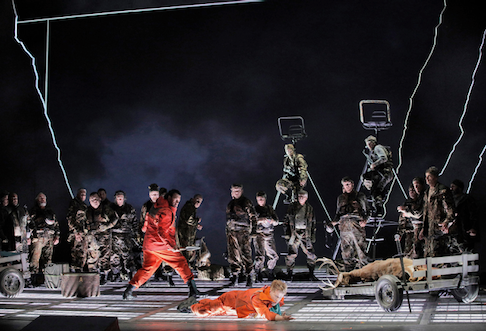 Hagen kills Siegfried. The Ring production costume designer is Catherine Zuber.
Hagen kills Siegfried. The Ring production costume designer is Catherine Zuber.
San Francisco Opera’s house bass Andrea Silvestrelli sang Hagen. Mr. Silvestrelli’s extraordinary height plus his dark, rough and powerful voice gave a strong presence to this cunning personnage who cruelly orchestrates the marital disasters. Though you might wish for more elegance of sound and subtlety of character, Mr. Silverstrelli certainly did the job, playing the role to the hilt.
San Francisco Opera house baritone Brian Mulligan sang Gunter. Mr. Mulligan possesses a very beautiful, Italianate voice without supplying a persuasive presence. This worked for establishing a certain character for Gunter though you might have wished for a less lyric voice and a more forward personality. Mr. Mulligan did succeed in making Gunter pathetic, evoking my reluctant sympathies for such a weakness.
We first encountered mezzo soprano Jamie Barton as a contemptuous Fricka. In Götterdämmerung she sings Waltraute, Brünnhilde’s valkyrie sister who comes to Brünnhilde to beg her to return the ring to the Rhine, to break its curse and perhaps save the gods. It is our last reference to Wotan before his annihilation in the opera’s last moments. Unfortunately Mlle. Barton was unable to achieve the angst and the gravitas that might have moved Brünnhilde to save her father. The complexity of the pathos of this scene were lost in its pallid reading.
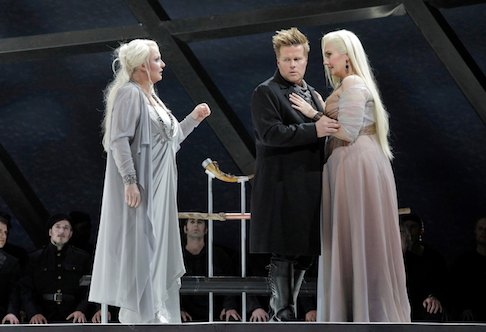 Siegfried and his two brides. Gutrune (right) sung by Melissa Citro
Siegfried and his two brides. Gutrune (right) sung by Melissa Citro
Soprano Iréne Theorin perservered through it all. In firm Brünnhilde character she ferociously denounced her marriage to Gunter, and together with Hagan and Gunter she swore revenge on Siegfried, this spectacular marriage scene set in the monumental architecture of the Gibichung Hall. She remained in equal vocal radiance for her immolation. Tenor Daniel Brenna’s Siegfried perservered through it all to make, finally, his scene with the Rhine maidens one of the memorable moments of the entire Ring. Maestro Runnicles brought earth shattering pathos to Siegfried’s death, freezing for eternity the complex emotions of this climactic moment.
After much sublime poetry over sixteen or so hours of one of the finest Rings I have ever seen, the immolation of Brünnhilde and the gods of Valhalla was strangely prosaic. Inexplicably, or maybe as victimized sisters Gutrune, Siegfried’s wife, stood by Brünnhilde’s during the valkerie's invocation to the ravens (unseen) to fly to Valhalla. The female chorus joined the Rhine maidens and Gutrune on stage for Brünnhilde’s horseless immolation. The radiant calm of the Ring’s final music was captured by the Rhine maidens energetically swirling great swathes of gold cloth.
Michael Milenski
Cast and production information:
Brunnhilde: Irene Thorin; Siegfried: Daniel Brenna; Gunther: Brian Mulligan; Hagen: Andrea Silvestrelli; Waltraute: Jamie Barton; Gutrune: Melissa Citro; Alberich: Falk Struckmann; First Norn: Ronnita Miller; Second Norn: Jamie Barton; Third Norn: Sarah Cambidge; Woglinde: Stacey Tappan; Wellgunde: Lauren McNeese; Flosshilde: Renée Tatum. Chorus and orchestra of the San Francisco Opera. Conductor: Donald Runnicles; Production/Stage Director: Francesca Zambello; Associate Director: Laurie Feldman; Choreographer: Denni Sayers; Set Designer: Michael Yeargan; Costume Designer: Catherine Zuber; Lighting Designer: Mark McCullough; Projections: Jan Hartley. War Memorial Opera House, San Francisco, June 17, 2018..
image=http://www.operatoday.com/Gotterdammerung_SF1.png
product=yes
product_title=Gotterdammerung in San Francisco
product_by=A review by Michael Milenski
product_id=Above: Alberich appearing to Hagen in a dream [All photos copyright Cory Weaver, courtesy of San Francisco Opera]
Siegfried in San Francisco
Though dubbed the “American” Ring there is nothing specifically American about this Siegfried except maybe the Siegfried — Wisconsin born Daniel Brenna, a veteran of the Washington D.C. Ring who has sung Siegfried in Budapest, Karlsruhe and Dijon as well.
In this Ring we relate to Wagner’s greedy dwarfs Alberich and his brother Mime perhaps as gypsies more than anything else, though for San Franciscans they might also be the classic, wily homeless (not unlike some of those on my block). They were Wagner’s Jews.
Mime’s dilapidated caravan (a gypsy image) is in a truly desolate setting, thus we know Mime is a loner, all the better to protect Siegfried, his ticket to the gold he covets. The Mime of American tenor David Cangelosi is slinking, garrulous and bubbling over with deceit — just perfect.
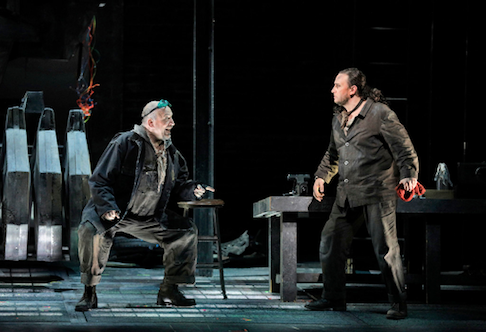 Falk Struckmann as Alberich, David Cangelosi as Mime
Falk Struckmann as Alberich, David Cangelosi as Mime
Mime’s bleak landscape is the only nature in the Zambello Ring beyond a few video references. There are no horses, there are no ravens, no forest bird, but there is Siegfried’s bear who playfully gallops onstage chased by his playmate Siegfried. The two creatures epitomize Wagner’s vision of unspoiled nature, and for Zambello tenor Brenner embodies a perfect portrait of wide and bright-eyed American innocence.
Of youthful visage and fine young voice tenor Brenna well embodied Wagner’s ideal of pure and indeed powerful nature. This innocence served him well through his almost joyful murders of Fafner and Mime and prepared him for his monumentally guileless encounters with the god Wotan and Wotan's once immortal daughter Brünnhilde.
Bass baritone Greer Grimsley’s heroic Wotan wanders through Siegfried’s industrially littered world in search of its and his destiny, the outcome he himself has willed to Siegfried. He encounters Siegfried’s protector Mime, and he encounters his arch rival Alberich, known to us since the initial moments of Das Rheingold in the personnage of Falk Struckmann, an imposing German bass baritone who is also known as a Wotan. As Alberich Mr. Struckmann's currency is gold, Wotan’s contracts forgotten.
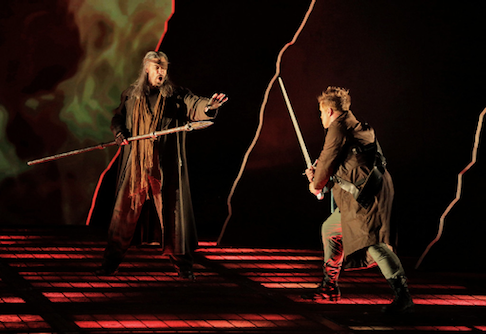 Greer Grimsley as the Wanderer, Daniel Brenna as Siegfried
Greer Grimsley as the Wanderer, Daniel Brenna as Siegfried
Wotan encounters Brunnhilde’s mother Erde in a scene where he completely loses his cool, and finally Wotan encounters Siegfried who shatters his creator's spear into which is imbued all social order. In all these encounters Grimsley’s Wotan exploits a humanity that is profoundly tragic and richly heroic, knowing finally that he himself has willed his destruction. And tenor Brenna musters the magnitude of innocent force to equal Grimsley’s resigned humanity in this spellbinding scene created by these two gifted actors.
The Forest Bird is no bird but rather a simple human creature who normally might have been Siegfried’s first love. Destiny however leads Siegfried to Brünnhilde. This final scene of the opera is spellbinding as well, playing on the youthful and direct voice of Siegfried in contrast to the powerful, mature voice of Wotan’s fallen daughter Brünnhilde, Swedish soprano Iréne Theorin. If at first the disparity of vocal production in this climactic scene is musically jarring, upon reflection it brilliantly sets up the tensions that will obsess us for the last, lengthy installment of the Ring.
A Ring given truly rich life by conductor Donald Runnicles and the San Francisco Opera Orchestra.
Michael Milenski
Cast and production information:
Mime: David Cangelosi; Siegfried: Daniel Brenna; Brünnhilde: Iréne Theorin; Wotan: Greer Grimsley; Alberich: Falk Struckmann; Fafner: Raymond Aceto; Forest Bird: Stacey Tap;pan; Erda: Ronnita Miller. San Francisco Opera Orchestra. Conductor: Donald Runnicles; Production/Stage Director: Francesca Zambello; Associate Director: Laurie Feldman; Choreographer: Denni Sayers; Set Designer: Michael Yeargan; Costume Designer: Catherine Zuber; Lighting Designer: Mark McCullough; Projections: Jan Hartley. War Memorial Opera House, San Francisco, June 15, 2018.
image=http://www.operatoday.com/Siegfried_SF1.png
product=yes
product_title=Siegfried in San Francisco
product_by=A review by Michael Milenski
product_id=Above: Daniel Brenna as Siegfried [All photos copyright Cory Weaver, courtesy of San Francisco Opera]
Boris Godunov in San Francisco
Though the Symphony billed the program as semi-staged for all intents and purposes it is fully staged. There is scenery or what purports to be in this digital age (this also happens across the street). There are lights and costumes and make-up. There is a stage on two levels. Reduced San Francisco Symphony forces (the string count [and personnel] is not specified in the program booklet — maybe 12/10/8/6/5) were stuffed in between in a sort of pit.
More accurate billing would have defined the production as a compromised staging, given that nothing functioned very well, sacrificing the contributions of the pit players of a major symphony orchestra and the imposing presence of imported Russian singers among the generally high-level cast.
Perhaps the four towers that support a lighting-grid circle are recycled from staged production to staged production at the Symphony thus alleviating what must be the breath-taking cost of trying to mount an opera production in a symphony hall. Lighting, rather lack of effective lighting was the most problematic technical issue of the evening.
There was a huge cyclorama — a semi-architectural, jagged backdrop — behind the orchestra and stage platforms onto which unrelenting video images were projected. There were cutouts to reveal the San Francisco Symphony Chorus seated in the stage terrace (amphitheater) behind the orchestra platform, the voices of the Russian populace. The projections onto the huge backdrop attempted grandeur — sometimes nature, sometimes specific colorful Russian architecture, sometimes interpretive color blotches, sometimes black shadows on blank white.
Stage director James Darrah employed six ninja-like action facilitators who were often, but not always, carefully choreographed. These six were sometimes joined by another 12 or so supers to constitute more specific though soundless Russian souls. The ninja’s participation was sometimes abstract and sometimes descriptive, like the lengthy, bloody downstage center brutalizations of a captured boyar (aristocrat) and two Jesuits.
It was complex staging that attempted to adapt Mussorgsky’s sprawling drama to an essentially non theatrical space.
The event was certainly envisioned to be magnificent, and it was in spite of itself. After all it is magnificent music, and San Francisco Symphony music director Michael Tilson Thomas of course made the most of it. Two loge boxes were conscripted to hold ranks of Russian bells that rang forth gloriously when called upon. A solo trumpet sounded an imposing fanfare from the first tier. These moments of unleashed sonic grandeur encased Mussorgsky’s grand choruses as well as the vaguely connected scenes of private discussions and of Boris’ raving. The extended intimacy of these solo voice scenes required that the SF Symphony’s virtuoso players become accompanists. And that they did, like an overly careful sometimes precious accompanist at a lieder recital.
There were two genuine Russian basses, the Boris of Stanislav Trofimov of St. Petersburg’s Marinsky Theater and the Pimen of Maxim Kuzmin-Karavaev of the Novaya Opera Theatre Moscow. Mussorgsky’s Boris Godunov is about words, about the Russian language and about the Russian soul. The Russian bass epitomizes these qualifications as no other voice. Both Mr. Trofimov and Mr. Kuzmin-Karavaev are excellent specimens.
There were three genuine Russian tenors, the intense Grigory (the Pretender) of Sergei Skorokhodov of the Marinsky Theatre and the harsh, very harsh Shuisky of Yevgeny Akimov, a veteran of the Marinsky and all of the world’s major stages, and the very sweetly sung Holy Fool of Stanislav Mostovoy of the Bolshoi Theatre.
The home team included San Francisco Opera’s Catherine Cook and Philip Skinner as the Innkeeper and Nikitich (a police officer) respectively who well held their own amidst the Russians. Of particular note was the Shchelkalov of American baritone Aleksey Bogdanov who made the opera’s momentous announcements in convincingly Russian voice.
It is always said that the protagonist of Boris Godunov is its chorus of suffering Russians. The San Francisco Symphony Chorus brought true beauty of style and edge of tone to its cultured and earnest concert choir voice, well defining its role as a musical protagonist. Though of course the real protagonists of the drama are Russian basses — the suffering czar Boris and the hermit Pimen, the chronicler of his reign.
Conductor Michael Tilson Thomas held all of this together with great aplomb and with obvious understanding, respect and affection for this great monument of Russian art.
Michael Milenski
Cast and production information:
Stanislav Trofimovbass (Boris Godunov), Eliza Bonet Mezzo-soprano (Fyodor), Jennifer Zetlan Soprano (Xenia), Silvie Jensen Mezzo-soprano (Nurse), Yevgeny Akimov Tenor (Prince Shuisky), Aleksey Bogdanov Baritone (Andrei Shchelkalov), Maxim Kuzmin-Karavaev Bass (Pimen), Sergei Skorokhodov Tenor (Grigory), Vyacheslav Pochapsk yBass (Varlaam), Ben Jones Tenor (Missail), Catherine Cook Mezzo-soprano (Innkeeper), Stanislav Mostovoy Tenor (Holy Fool), Philip Skinner Bass (Nikititsch), Chung-Wai Soong Bass (Mityukha). Pacific Boychoir, Andrew Brown, Director; San Francisco Symphony Chorus, Ragnar Bohlin Director; San Francisco Symphony, Michael Tilson Thomas Conductor. Stage Director: James Darrah, Lighting Design: Pablo Santiago; Video: Adam Larsen; Scenic and Costume Design: cameron Jaye Mock. Davis Hall, San Francisco, June 14, 2018)
image=http://www.operatoday.com/Boris_SFS1.png image_description=Photo by Christian Dresse courtesy of the Opéra de Marseille product=yes product_title=Boris Godunov in San Francisco product_by=A review by Michael Milenski product_id=Above: Stanislav Trofimovbass as Boris GodunovPhotos by Cory Weaver, courtesy of San Francisco Symphony.
June 19, 2018
Garsington Opera transfers Falstaff from Elizabeth pomp to Edwardian pompousness
Setting Verdi’s opera in the era of the suffragettes’ campaigning and Edward Elgar’s paean to ‘Englishness’ - the composer’s symphonic study Falstaff Op.68 was premiered in 1913 - neatly promotes pertinent ‘issues’ but also dilutes, a little, the immediate comic impact of the out-size peer of the realm, Sir John Falstaff.
Designer Giles Cadle has been eager, it seems, and unlike the opera’s eponymous protagonist, to stick within his budget. While Falstaff is pestered in his attic garret by a gothic, disembodied hand which thrusts an unpaid bill - for “Six chickens: six shillings. Thirty bottles of sherry: two pounds. Three turkeys ... Two pheasants. An anchovy ...” - through the floor boards, Cadle presents us with a cardboard cut-out set which allows us to take in a long and short perspective of Windsor’s castle and forest, and to enter some interior dwellings.
We begin in Sir John’s sparse abode above the Garter Inn. The pseudo-grand double-arch proscenium frame (a nod in the direction of William Tite’s multi-arched entrance to Windsor & Eton Riverside Railways Station, perhaps) and the sharp perspective retreat of the central raised, square platform seems to mock the pretentions of the Knight’s former glories, as embodied by the portrait of a slightly more svelte Falstaff in Hussar uniform which leans against the military hut from which the aging knight bursts with vitality and vulgarity.
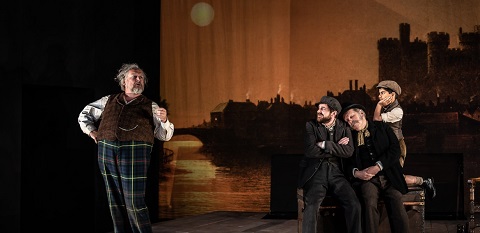 Henry Waddington (Falstaff) Nicholas Crawley (Pistola) Adrian Thompson (Bardolfo) Ansh Shetty (Page). Photo credit: Clive Barda.
Henry Waddington (Falstaff) Nicholas Crawley (Pistola) Adrian Thompson (Bardolfo) Ansh Shetty (Page). Photo credit: Clive Barda.
This is a world in which feudalism has given way to the top hats sported by the worthy professionals of the nineteenth-century middle classes, such as Dr Caius, who is unceremoniously duped and turned on his head - literally, in the opening scene - and the bowler hats of the up-and-coming lower orders, such as Pistola and Bardolpho, who hedge their bets with regard to where their allegiances and labours are best bestowed. The only servant upon whom Falstaff can depend for loyalty is the young urchin who’s happy to share a tankard and to do his ‘aristocratic’ master’s bidding - and to dress up as a somewhat ‘benign’ Grim Reaper in the final scene.
Cadle utilises a rolling backdrop to set the scene. First, we have a vista which takes in the Thames (in which Falstaff will take an unanticipated dip, courtesy of the ladies whom he courts) and the castle of Windsor (loosely based on Turner’s Windsor Castle from the Thames c.1805). Next, we are whisked to Tite’s spacious railway concourse, the platforms of which retreat graciously and extensively under elegant arching ceilings.
Here, the female members of the Temperate Society gather, bearing banners - ‘Lips that have touched liquor shall not touch ours’ - while Suffragettes reminds us that only ‘Convicts, Lunatics and Women! Have No Vote for Parliament!’ The political activity does not seem to bother the inscrutable ticket officer ensconced in his tiny office; in fact, the dramatic focus seems to be on the charms of the steam locomotive that will chug and puff its way across the stage, raising a chuckle or two - and the only dramatic function of this locale seems to be that it provides a little Brief Encounter sentimentalism for the romantic embraces of Nannetta and Fenton.
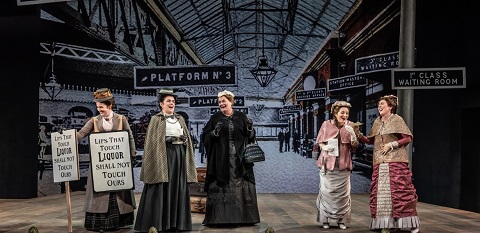 Hollie-Anne Bangham (chorus) Victoria Simmonds (Meg) Yvonne Howard (Mistress Quickly) Soraya Mafi (Nannetta) Mary Dunleavy (Alice Ford). Photo credit: Clive Barda.
Hollie-Anne Bangham (chorus) Victoria Simmonds (Meg) Yvonne Howard (Mistress Quickly) Soraya Mafi (Nannetta) Mary Dunleavy (Alice Ford). Photo credit: Clive Barda.
When Falstaff is duped into paying a call to Alice Ford, he finds himself amid Victorian flock wallpaper and screens, and faux foliage. The allusions to the detective fiction of the 19th century -the clumsy detonation of the screens by Ford and his accomplices, à la Holmes’ fictional foil, the police inspector Mr Athelney Jones - feel rather perfunctory, just as Falstaff’s secreting of his bulk in the laundry basket seems a bit laboured, especially as on this occasion he appeared to get ‘stuck‘ as he slides unceremoniously into the murk of the Thames. The result is laughs of the glibbest kind, such as those derived from the assault on Meg’s ‘innocence’ when the Knight, who has gleefully divested himself of his underwear when donning his tartan and sporran in anticipation of sexual high jinks, flashes his nether regions at a delighted/disconcerted Meg.
Cadle’s design reaches its apotheosis in the final Act: the menacing foliage which creeps in right and left threatens to swallow the evening forest tryst - à la Richard Dadd - and Falstaff himself is hoisted aloft, as a sort of Maypole exhibit, an image which is both cruel and comic.
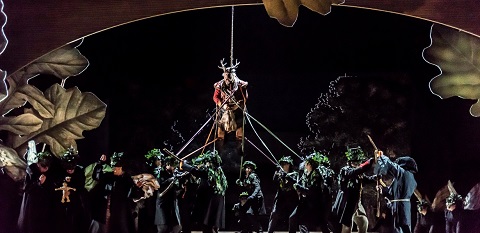 Henry Waddington (Falstaff) and GPO Chorus. Photo credit: Clive Barda.
Henry Waddington (Falstaff) and GPO Chorus. Photo credit: Clive Barda.
But, set and design and aside, most of the enjoyment comes, as it should, from the singers and players. The Philharmonia Orchestra serve up tip-toeing instrumental delicacies and brash quasi-vulgarities with equal splendour, under the baton of Richard Farnes. If the coloristic orchestral onslaught is not always sensitive to the needs of the singers and there are moments when the vocal lines struggle to fight for space to be heard, then Farnes is ultra-alert to the ever-changing moods and tempi.
At the centre of the music-drama is Henry Waddington’s Falstaff: a figure who is wide of girth, proud and assured of his ‘entitlement’, but also surprisingly sensitive of spirit and judicious of vocal articulation of his self-worth. Falstaff’s ‘honour’ aria was eloquently delivered - how pleasing it was to have time to take in the words and their sentiment, particularly when they are so thoughtfully delivered with expressive nuance - and perceptively accompanied, and it made its mark. In contrast, the Knight’s lamentations about the sorry state of the world at the start of Act 3 did not quite have sufficient space within the accompanying instrumental medium to penetrate with sufficient pointedness. But, this was a Falstaff who wanted us to think, rather than guffaw, and that’s no bad thing.
 Richard Burkhard (Ford). Photo credit: Clive Barda.
Richard Burkhard (Ford). Photo credit: Clive Barda.
Richard Burkhard’s Ford was a compelling figure of rage and revenge, and his vendetta aria, ‘È sogno o realtà?’, conjured real threat and menace. I, for one, wouldn’t want to cross him. As his wife, Alice, Mary Dunleavy was a bright star, evincing smile-inducing guile and girlishness, complemented by intelligence and ingenuity - all conveyed with vocal assurance and plushness of sound.
Victoria Simmonds’ Meg Page was fittingly uptight, with an undercurrent of mischievousness; Soraya Mafi’s Nanetta and Oliver Johnson’s Fenton reminded us that there are real human emotions and lives at stake.
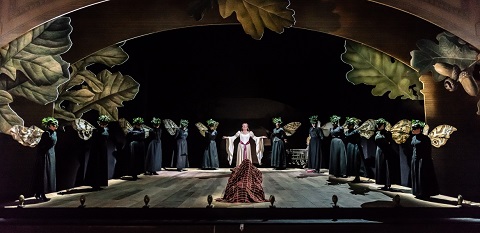 Soraya Mafi (Nannetta). Photo credit: Clive Barda.
Soraya Mafi (Nannetta). Photo credit: Clive Barda.
The only downside of this direct and compelling production was the unanticipated and unwelcome intrusion of the hedonist thumping and twanging of a nearby pop concert, carried by the brisk wind from outside the Wormsley estate to the opera pavilion, which, in particular, marred the magic of Soraya Mafi’s nocturnal serenade. Goodness knows what the Fat Knight would make of such a discourtesy.
Claire Seymour
Verdi: Falstaff
Sir John Falstaff - Henry Waddington, Alice Ford - Mary Dunleavy, Ford - Richard Burkhard, Meg Page - Victoria Simmonds, Mistress Quickly - Yvonne Howard, Nannetta - Soraya Mafi, Fenton - Oliver Johnston, Dr. Caius - Colin Judson, Bardolfo - Adrian Thompson, Pistola - Nicholas Crawley, Page (silent) - Ansh Shetty; Director - Bruno Ravella, Conductor - Richard Farnes, Designer - Giles Cadle, Lighting Designer - Malcolm Rippeth, Movement Director - Tim Claydon, Philharmonia Orchestra & Garsington Opera Chorus.
Garsington Opera Festival, Worsley; Saturday 16th June 2018.
image=http://www.operatoday.com/Falstaff%20in%20Alice%27s%20basket.jpg image_description=Falstaff, Garsington Opera product=yes product_title=Falstaff, Garsington Opera product_by=A review by Claire Seymour product_id=Above: Yvonne Howard (Mistress Quickly) Henry Waddington (Falstaff) Victoria Simmonds (Meg)Photo credit: Clive Barda
June 18, 2018
Mascagni's Isabeau at Opera Holland Park: in conversation with David Butt Philip
But, that’s the gauntlet thrown down by Pietro Mascagni and librettist Luigi Illica, in their 1910 opera, Isabeau - and one that must be picked up Martin Lloyd-Evans when Opera Holland Park presents Mascagni’s medieval melodrama next month. Illica’s libretto is a variant on the Lady Godiva legend, which transmutes the naked progress from self-sacrifice to punishment - when Isabeau refuses all of the suitors whom her father, King Raimondo, has gathered to compete for her hand in a tournament of love - and swaps the voyeuristic Peeping Tom (who disobeys Godiva’s plea for all the townspeople to stay indoors and avert their gaze) for an innocent country lad, Folco, who is imprisoned for his visual trespass. Though he wins the chaste princess’s heart, when she visits him in his prison cell, her pleas to her father for clemency come up against the cunning machinations of the Chancellor, Cornelius. It’s not a romance that is destined for a happy ending.
An American premiere was originally planned for Isabeau, with soprano Bessie Abott as the eponymous princess, but financial support was not forthcoming, and the opera was eventually first performed in Buenos Aires, at the Teatro Coliseo in June 1911, conducted by Mascagni and with Maria Farneti and Antonio Saludas as the doomed lovers. Performances at La Scala and La Fenice the following year were well-received, and the opera stayed in the repertory of many Italian houses before gradually fading after a couple of decades into near oblivion. Critical opinion has proved, on the whole, negative: William Ashbrook dismissed the opera as ‘trite bombast’, while Michele Girardi’s Grove article, complains that ‘the opera depends too much on 19th-century devices whose forced rhetoric is often evident; similarly, the attempts at musical sophistication in the work fail to conceal its essential conservatism.’
But, in an interview, Mascagni professed that, ‘With Isabeau I attempted a return to that romanticism which inspired so much Italian opera. It seemed to me that in the lyric theatre, verismo, of which I myself was a fervent follower, had had its day’. He looked upon the opera as ‘something entirely new’, and this was the question I posed to tenor David Butt Philip, who takes the role of Folco in OHP’s forthcoming production: is Isabeau hackneyed, histrionic verismo or is it something fresh and new?
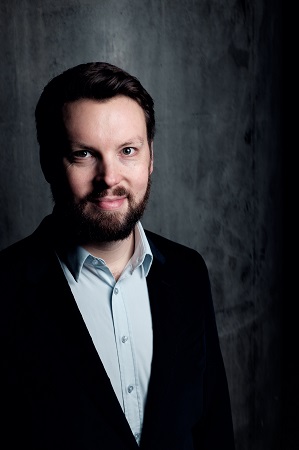 David Butt Philip. Photo credit: Andrew Staples.
David Butt Philip. Photo credit: Andrew Staples.
David Butt Philip explains that, far from being clichéd convention, the harmonic language of Isabeau suggests that this was a composer who had heard Salome and the early music of Strauss, and who was beginning to explore new paths and idioms of a distinctly ‘modernist’ bent. The opera by Puccini which it most readily brings to mind is Turandot, composed more than ten years later, and particularly the third act which was ‘completed’ by Franco Alfano.
It’s not so much the vocal lines which seem innovative, rather the orchestral language, which prompts me to ask David about the challenges of singing a role which so often, as he observes, lies consistently just above the break in the voice, even if it does not rise to stratospheric peaks. Indeed, it has been suggested that it’s the difficulty in casting two singers who are capable of sustaining the soaring lines of the arduous leading roles that has contributed to the opera’s languishing. In fact, explains David, Mascagni helps the singers to pace themselves: the warm-ups to the most muscular bursts of vocal activity are skilfully structured, and, at least until the demanding final Act with its extensive duets, there are ‘rest breaks’, so to speak. But, the tenor does feel that this is perhaps why Isabeau doesn’t appear often in the repertory, as smaller houses and festivals may find the casting demands prohibitive; and, the tenor thinks that he himself would be reluctant to sing the role of Folco in one of the larger houses. So, the opportunity to participate in the OHP production is greatly welcome; the verismo repertory clearly feels ‘entirely natural’ to David, who in 2016 sang Luigi in Opera North’s Il Tabarro.
Alongside the Intermezzo (Mascagni termed it a ‘hymn to the sun’) depicting Isabeau’s naked ride, the musical peaks of the opera are the two arias for each of the principals and the final duet. Is the opera rather ‘static’, dramatically, I wonder? David admits that there are some dramaturgical challenges: there are sections where there is little action - such as at the start of Act 2, as Isabeau prepares for her ride - which need careful consideration in the theatre, but also passages where the plot moves along very quickly, in ways that are not always presented through explicit action or text. For example, there are minor characters, such as the anonymous knight, who are not fully delineated but who play a vital part in the plot, and who intimate a back-story of which the audience are unaware. We might well be familiar with the ‘back-story’ of Figaro after more than 200 years, but Lloyd-Evans and the cast are having to reflect upon how to ensure that essential points of detail are communicated even if they are only briefly or implicitly articulated in text or score.
David’s enthusiasm for, and conviction in, Isabeau is compelling: it’s an opera, he tells me, not concerned with mythology or philosophy, but about real human beings with tangible, credible emotions. Rather different, then, from the literary starting-point of Brett Dean’s Hamlet which David performed (as Laertes) at Glyndebourne Festival Opera last summer, taking the title role during the Glyndebourne Tour subsequently. As David concurs, even selecting just 25% of Shakespeare’s four hours’ worth of dramatic text, would have proved too lengthy and unwieldy, so Dean and his librettist Matthew Jocelyn took an early decision to fragment the original text and largely remove it from its philosophical context. The result was an opera that must have confounded the expectations of many opera-goers, who thought that they ‘knew’ Hamlet, by presenting them with an opera which subverted Shakespeare’s drama from its very opening phrase - a fragment of the play’s most famous line, which is only heard in its entirety when uttered ironically by one of the Players - and forcing them to take the opera on its own terms.
David admits that the directorial team and cast were slightly anxious going into the dress rehearsal: ‘We had no idea if it was any good!’ They thought it was, had worked so hard, had the faith of the Glyndebourne management behind them … but what would the Glyndebourne audience, many of whom may not be regular opera-goers, make of it? Fortunately, “they immediately got it!” And, David was surprised that it was often those who were less experienced opera-goers who responded so strongly to the theatricality of the work. Certainly, that was my own experience of hearing a tour performance in Canterbury. I’m often a little hesitant when approaching an opera based on an existing literary work which I know well, but on this occasion, although the excision of Hamlet’s soliloquies did alter our conception of his psychological development as a character, Jocelyn and Dean created a Hamlet of immediate and escalating intensity, and the result was dramatically compelling - a view clearly shared by the Canterbury audience-members around me, who may well have chosen to attend the opera because it was ‘Hamlet’ but who evident enjoyed being served up a performance that ‘wasn’t’.
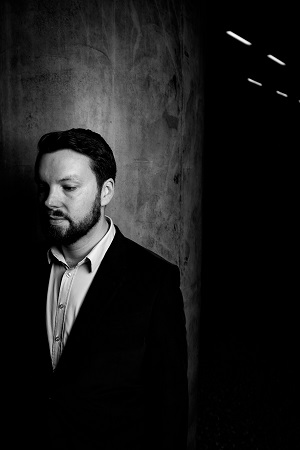 David Butt Philip. Photo credit: Andrew Staples.
David Butt Philip. Photo credit: Andrew Staples.
Inevitably, I ask David about the challenges of swapping roles between the Festival and Tour. He responds that singing Hamlet on tour was not difficult - after all, he knew the opera and production well by then; rather, it was performing the role of Laertes during the Festival, while simultaneously under-studying Hamlet, which gave him ‘a few sleepless nights’. Having received the score a little later than anticipated, and while he was making his debut in the role of Erik in Der fliegende Holländer at Opéra de Lille, David had to learn the role of Laertes in the single month after the Lille performances had finished and before Glyndebourne rehearsals began, and then get to grips with Hamlet ‘on the job’, as it were. Rehearsing as Laertes in the mornings and then returning in the evening to sing Hamlet’s music was exhausting; and the pressure was increased as the role of Laertes turned out to be larger than he, or probably Brett, anticipated. He obviously immensely enjoys the ‘theatricality’ of Brett’s music though, and in March this year joined Allison Bell and the Radio Symphony Orchestra Berlin under the baton of Vladimir Jurowski to sing Dean’s From Melodious Lay, an orchestral poem which explores the relationship between Hamlet and Ophelia, and which was re-worked in to the score of Dean’s opera. Though Dean’s music is not so obviously vocally satisfying as Mascagni, for example, David admires the dramatic interest with which Dean injects his vocal writing and his skill in producing precise and exciting effects for the voice.
Our conversation moves on to future plans, one of the most interesting of which is ENO Artistic Director Daniel Kramer’s staging of Britten’s War Requiem in November. David has “no idea what to expect!”, but the score is inherently and intensely dramatic, and Wilfred Owens’ texts offer copious, often disturbing, visual imagery. Designed by Turner Prize-winning artist and designer Wolfgang Tillmans, this is going to be one of the ‘not to be missed’ cultural events in the capital this autumn. David has ‘warmed up’ with performances of the Requiem with Orquestra Sinfonica Portuguesa and Opéra Orchestre National Montpellier this year. At ENO he will perform alongside Roderick Williams and Emma Bell; and, interestingly, the conductor will be Martyn Brabbins, under whose leadership a young David Philip Butt performed the Requiem as a chorus member in his student days, an experience which clearly initiated a growing passion for Britten’s dramatic music - one which was nurtured this year in Madrid, where David sang the role of the Earl of Essex in Sir David McVicar’s new production of Gloriana. It’s an opera I feel is woefully under-rated, and David agrees: it’s a more ‘angular’ work, and the libretto presents challenges to an audience - the characters, particularly the Queen, can seem distanced and difficult to engage with. But, the two scenes for Essex and Gloriana are stunning - as, I suggest, is the musico-dramatic structure of the final Act, to which David adds the impact of the trumpeters in the opening scene. Having appeared in just a single scene, as the Master-of-Ceremonies, in Richard Jones’s Covent Garden production - during his time as a Jette Parker Young Artist at the Royal Opera House, David clearly relished being involved in McVicar’s production, which he describes as a ‘real revelation’.
Looking ahead, David will sing Verdi’s Requiem with the Royal Philharmonic Orchestra under conductor Jac van Steen at the Royal Albert Hall in November, and then take the role of Froh in Das Rheingold at the Teatro Real in Madrid in January 2019 - a role he performed at the Tanglewood Festival in July 2017. As for his ‘wish-list’, perhaps first ports of call might be Cavaradossi or Lohengrin. But, it’s clear that, further ahead, Britten is where the heart lies: namely, Grimes and Vere. Let’s hope the casting directors are taking note.
Isabeau is being performed at Opera Holland Park from 14th-28th July.
Claire Seymour
image=http://www.operatoday.com/Allegorical%20watercolor%20depicting%20Isabeau%2C%20opera%20by%20Pietro%20Mascagni.jpg image_description=Isabeau product=yes product_title=Isabeau at Grange Park Opera: in conversation with David Butt Philip product_by=An interview by Claire Seymour product_id=Above: Allegorical watercolor depicting Isabeau, opera by Pietro Mascagni (1863-1945), given to composer by Buenos Aires musicians on September 2, 1911Photo credit: De Agostini Picture Library, A. Dagli Orti, The Bridgeman Art Library
Grange Park Opera travels to America
Medcalf and Vartan resurrect their set for last year’s Die Walküre at the start and present us with a colonnaded state-room over-looked by a balcony approached by two graciously curving stairways, the sombre gravitas of slate-grey alleviated by the proud red, white and blue of six Stars and Stripes. Vicenzo Costanzo’s Riccardo makes an imposing entrance and takes his place at a central lectern to hear the petitions of his people, acceding to their pleas with patrician benevolence.
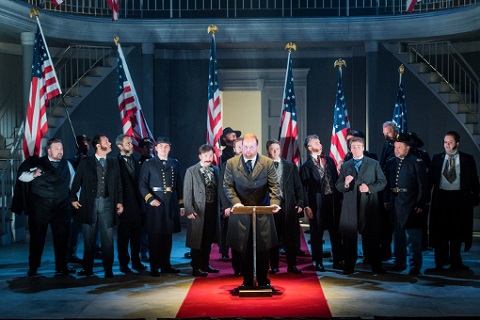 Roland Wood (Renato - centre) and GPO Chorus. Photo credit: Robert Workman.
Roland Wood (Renato - centre) and GPO Chorus. Photo credit: Robert Workman.
Although the Riccardo of the libretto possesses little of this stateliness and stature, it’s a credible setting which allows Medcalf to juxtapose loyalty and treachery in the form of, respectively, the Bostonian populace and Riccardo’s arch enemies, Sam and Tom, who are plotting his downfall. The problem is that it serves less effectively for the subsequent locales. The transition to the fortune-teller’s Ulrica’s hut is slickly effected, as David Plater’s lighting translates us to a scene of nocturnal witchery and the hut slides to the centre of the state room, but the subsequent gothic ghoulishness - top-hatted skulls perched crookedly on Ulrica’s ‘altar’; she decapitates a chicken and smears her hand-maidens with its blood; flames shoot violently from the roof of her hut - seems out of place within the realist frame of state office. When the women start twitching and writhing hysterically it’s as if the confessions of Miller’s The Crucible are taking place in the White House.
Realism and romance further collide when Riccardo enters, disguised as a sailor, and utilises a skull as a ventriloquist’s dummy when begging Ulrica to tell him his fortune - though perhaps it’s a fitting symbol for the fatal future she reveals: that he will die soon, slain by a friend.
The scene of Amelia’s gallows-tree tryst is similarly awkward scenically. In Rigoletto, though the eponymous jester ignores the fatal shadow that hangs over him, we are intermittently reminded of Monterone’s curse by Verdi’s spine-tingling motivic repetitions of the parole sceniche. Riccardo is similarly blasé about his fate, but here symbols of death are more prevalent. As Amelia searches (on the balcony?) for the herbs which will cure her of her forbidden desire, nooses fall from the ceiling, dangling provocatively through the lovers’ declarations of love and their subsequent interruption by Amelia’s husband Renato.
And, symbols of death are not absent from the scene in Renato’s study. A platform furnished with chair, desk and a painting of former US governor who stares sternly from the frame, is pushed to the fore-stage, and it is here that Renato challenges and condemns his wife, holding a knife to her throat before allowing her a final farewell to her young son. The boy’s playful jesting with his father’s gun is ominous.
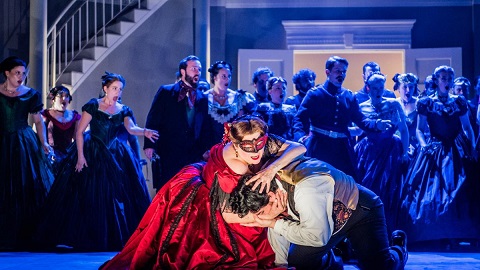 Claire Rutter (Amelia) and Vincenzo Costanzo (Riccardo). Photo credit: Robert Workman.
Claire Rutter (Amelia) and Vincenzo Costanzo (Riccardo). Photo credit: Robert Workman.
If the settings jar a little, musically it’s smooth sailing, thanks in no small part to the superb playing of the Orchestra of English National Opera - in residence for the season - under the assured guidance of conductor Gianluca Marciano. Marciano wrings every ounce of drama from the score, from the quietest motivic and coloristic gestures to the most terrifying monumental climaxes, and he paces the drama discerningly; the dramatic sweep from Amelia’s drawing of the name of the conspirator who will be Riccardo’s assassin to the final tragic moments was compelling.
Some of the blocking of the Chorus feels a little stiff initially, and in the first Act the principals, too, often stand and sing straight to the house. However, the Grange Park Chorus were in final voice, both collectively and when stepping forward as individuals: Trevor Bowes was particularly fine as the drunken ‘sailor’, Silvano. The masked ball itself, though, is persuasively choreographed: Plater uses the vivid lighting design to ‘freeze’ the whirling dancers, creating a sense of an unstoppable tragic momentum escalating beyond the flowing intimacy of the ballroom, and, together with the richly coloured fabrics of the ladies’ ball-gowns, this injects a vibrancy and tension that had previously been lacking at times.
Claire Rutter’s dresses were rather ‘plain Jane’, but the soprano was in gloriously lustrous voice, rising to the top with both ease and beauty in Act 2’s ‘Ma dall'arido stelo divulsa’, as she foraged for the curative herbs, and in ‘Morrò, ma prima in grazia’, when she pleaded for one last chance to hold her son. Rutter persuasively responded to dramatic situation, altering her tone, which was both pure and powerful, accordingly. This Amelia out-sung her Riccardo, both in eloquence and passion, but if Costanzo’s tenor was disappointingly tight initially, the phrasing a little rigid and the intonation not always firm of focus, Riccardo’s Act 3 vow to renounce his love and resume his stately duties to his people, ‘Ma se m'è forza perderti’ had more conviction, both vocally and psychologically.
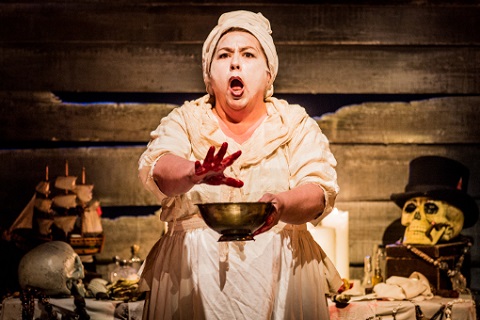 Elisabetta Fiorillo (Ulrica). Photo credit: Robert Workman.
Elisabetta Fiorillo (Ulrica). Photo credit: Robert Workman.
One problem was that there was little sense of romantic rapport between Riccardo and Amelia, but if the lovers seemed somewhat detached, the male bonding was heated with genuine passion and fire, thanks to a tremendous performance by Roland Wood as Renato. The impulsive force of Renato’s emotions was evident from the first, and as his rage was stoked by betrayal and intrigue, so his menace grew ever more disturbing and fearsome. In Act 3, Renato’s ‘Eri tu che macchiavi quell’anima’ - in which he realises that it is Riccardo and not his wife who should pay for his disloyalty and decries the loss of his former paradise of love and friendship - held the house spell-bound; Wood shaped every phrase with acumen and elegance, and, his head fallen onto his desk in the agony of betrayal and grief, sustained the final note with an impressive display of control and contour. The baritone had massive reserves of power, and did not tire, if anything growing stronger as the tragedy swept to its bitter conclusion.
Elisabetta Fiorillo’s employed a rather wide vibrato but was an ebony-toned Ulrica and had the power to sustain the fortune-teller’s slow-paced invocation, even as it plunged to the lowest depths. Bass-baritone Matthew Buswell and bass Matthew Stiff were a convincing pair of assassins.
The role of Oscar was sung with punch and brightness by Tereza Gevorgyan, but I found the soprano’s acting a bit heavy-handed: the ‘boys will be boys’ back-slapping and bottle-swigging didn’t really ring true - but perhaps the problem was that Oscar, dressed inexplicably as a cowboy, was a mis-fit among the men of state.
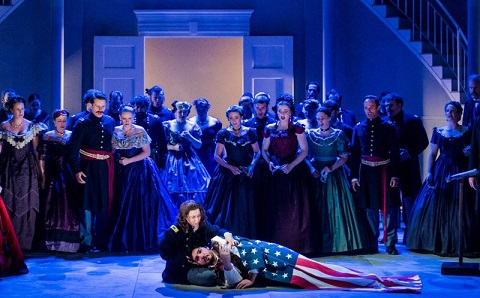 Tereza Gevorgyan (Oscar) and Vincenzo Costanzo (Riccardo). Photo credit: Robert Workman.
Tereza Gevorgyan (Oscar) and Vincenzo Costanzo (Riccardo). Photo credit: Robert Workman.
If Oscar seemed a little out of place amid the patricians of 19 th-century Boston, then he’d surely have felt at home on the prairies of 1930s Oklahoma the following evening, where the triangular frontier romances threatened to have similarly tragic outcomes but where the sunshine eventually drove the storm clouds far away.
Jo Davies’ production of Rogers & Hammerstein’s 1943 hit, Oklahoma!, skilfully balances freedom and optimism with danger and darkness, just as the streaks which pierce the pink sunrise which is lauded by Dex Lee’s golden-toned Curly McLain in the show’s wonderful opening paean to the land and the limitless opportunities of the frontier, ‘Oh, What a Beautiful Mornin’’, hint at the evening thunder to come.
When the corrugated barn doors slide lethargically aside, designer Francis O’Connor’s expansive rural vista invites us to cross the threshold and journey to a different time, place and culture where, as the matriarchal Aunt Eller commands, the ‘Territory folks’ should stick together - “Cowboys, dance with the farmers’ daughters! Farmers, dance with the ranchers’ gals” - but where community cohesion is threatened by individual desire and will.
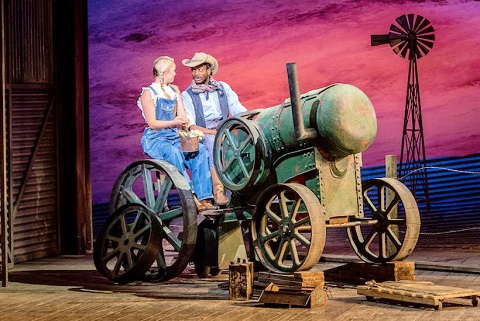 Katie Hall (Laurey) and Dex Lee (Curly). Photo credit: Robert Workman.
Katie Hall (Laurey) and Dex Lee (Curly). Photo credit: Robert Workman.
As the bright orange of dawn transmutes to the gentle grey of dusk, and the indigo of night overpowers the cornflower blue of day, Bruno Poet’s evocative lighting carries us through the slowly unfolding days. There’s an assuring sense of unity, despite the surface tensions. A wind pump spins lazily in the prairie breeze, a tree-sculpture of hoes etches a sharp silhouette against the sunlit sky and Claire Moore’s Aunt Eller emerges from beneath the steam engine she’s fixing, clutching a spanner and wiping her oily hands on her denim dungarees - gestures which seem to symbolise her disciplinarian role when cracks appear in the community.
The set and props are incorporated into the action with naturalism, enhancing the realism and dramatic fluency. Hay bales serve as tables and beds, ropes and hoes articulate the drama of the dances, the belching steam engine metamorphoses into a bunting-bedecked wedding coach. Davies’ stage direction, the set transitions and Andrew Wright’s choreography are equally slick and accomplished - and share an impressive eye for telling detail.
As the farm workers hoist ropes and harnesses in the barn, we’re taken by surprise when the boards are winched aloft to form the low, lowering ceiling of Jud Fry’s rat-infested smoke-house. And, when the cow-girls who arrange the scowling outcast’s hay-bale bed linger for a few moments, they seem a teasing embodiment of the pornographic postcards which are tacked on the walls, reminding us of the danger posed by Jud’s barely suppressed sexuality - just as the kaleidoscope of ‘pitchers’ that he purchases from the ‘Persian’ pedlar Ali Hakim is more than it seems: “Y’see it’s got a little jigger onto it, and you tetch it and out springs a sharp blade.” No wonder the wedding feast is disrupted by a downpour - a figurative deluge of the destruction which springs from Jud’s isolation and pain.
 Louis Gaunt (Will Parker - centre) and Chorus. Photo credit: Robert Workman.
Louis Gaunt (Will Parker - centre) and Chorus. Photo credit: Robert Workman.
Wright’s dances have a beautiful balletic quality which emphasises the essential fantasy of the dreams that these frontier folks indulge. This climaxes in the end-of-Act 1 dream sequence, when the ‘The Elixir of Egypt’ which farmer Laurey Williams drinks - she’s purchased it from Ali who has promied that it will help her to “see everything clear” - transports her from twilight reflections to an ugly nightmare. The balletic grace of her innocent fantasy of courtship and marriage with Curly contrasts disconcertingly with the terrifying reality of Jud’s fearsome sexuality which is explicitly represented by the vulgar sexuality of the seamy can-can dancers. I can’t imagine this dream sequence better done.
The light amplification of the singing is not intrusive, and the cast wear their cowboy boots and Stetsons with flair. As Curly, Dex Lee dances with an easy muscularity which is matched by the beguiling warmth of his voice, and it’s a real plus that there is such a strong and convincing romantic frisson between Lee and Katie Hall’s Laurey - a tension which persuasively sustains the dramatic development and resolution. Hall can do sweetness and sulkiness with equal charm but, more than that, she uses her voice - which expands at the top with a compelling bloom - to convey subtleties of emotion and a sensibility and sensitivity which the communal unanimity is designed to subdue.
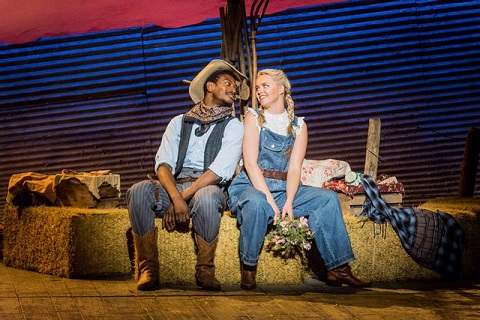 Dex Lee (Curly) and Katie Hall (Laurey). Photo credit: Robert Workman.
Dex Lee (Curly) and Katie Hall (Laurey). Photo credit: Robert Workman.
Louis Gaunt is delightful as the naïve nincompoop, Will Parker, who woos his beloved Ado Annie with optimistic, indestructible enthusiasm. When he returns from Kansas City proudly and gleefully clutching the $50 which will, he believes, win him his promised bride, the utopian dynamism of his wondrous celebration - ‘ev’rythin’s up to date in Kansas City’ - sweeps all around him into an intoxicating dance in homage to progress and the power and potential of modern American.
At times the American accents border on hyperbole: I couldn’t count the number of syllables that Natasha Cottriall managed to find in the “cain’t” of her confession, ‘I Cain’t Say No’ - and in this number Cottriall forced her voice a little too hard, occasionally at the expense of the pitch. But, elsewhere this Ado Annie was not just enchantingly ditzy but also expressed believable frustration at the choices before her, and her relationships with Will, Ali and with her over-bearing but good-intentioned father, Andrew Carnes - played with a brisk, no-nonsense presence by Nicolas Colicos - were layered and real.
One of the musical highlights was Phillip Rhodes’s heart-touching rendition of Jud Fry’s ‘Lonely Room’. Rhodes brooded stormily and captured all of Jud’s menacing repression and injured soul. In this aria, his baritone swelled with inner rage and suffering, descending darkly and with a powerful focus which seemed to pin one to one’s seat, forcing one to reflect on the perceived, and perhaps real, injustice and isolation which he suffers. This was an ‘operatic’ soliloquy of gripping tragic depth.
Neither Steven Serlin as Ali Hakim nor Claire Moore as Aunt Eller indulged in hammy caricature and the result was a compelling dramatic credibility. Serlin, as he deftly transformed his suitcase into a table of wares, slickly conveyed Ali’s flirtatious superficiality and his suave patter seduced the ladies as quickly as it separated them from their dimes. Claire Moore’s Aunt Eller kept order with the authoritative efficiency of both her tongue and her rifle, and Moore’s convincing establishment of Eller’s role as community leader made her command of the trial scene - a dramatically awkward moment - more believable.
The big numbers all come in the first Act, and Act 2 can sometimes seem a little wordy, but Davies kept things moving along through scenes such as the auction, and the dances flowed seamlessly from the dialogue. The fluency was greatly aided by the superb playing of the BBC Concert Orchestra under conductor Richard Balcombe who achieved a terrific balance between punchy pizzazz and delicate sentimentality, from the piping birdsong which heralds the dawn to the barn-storming hoe-downs and show-downs of the dramatic climaxes.
There is some inherent tension in Oklahoma! between the realism of the theatrical tale and the escapism of the musical numbers - it’s discomforting that Jud has to die so that wedding day celebrations can reach their triumphant conclusion - and Davies did not fully resolve this unease. But, if at the close she couldn’t quite overcome our questioning of the rapid banishment of the threatening ‘other’ and the assimilation of all within the larger community - as both Curly and the immigrant Ali declare, ‘We Know We Belong to the Land! - then perhaps we should simply remember Aunt Eller’s pragmatism: ‘Well, le’s not break the law. Le’s just bend it a little.’
Grange Park Opera’s 2018 festival continues until 7th July.
Claire Seymour
Un ballo in maschera
Amelia - Claire Rutter, Riccardo - Vincenzo Costanzo, Ulrica - Elisabetta
Fiorillo, Renato - Roland Wood, Oscar - Tereza Gevorgyan, Sam - Matthew
Buswell, Tom - Matthew Stiff; Director - Stephen Medcalf, Conductor -
Gianluca Marciano, Designer: Jamie Vartan, Costume Designer - Nicky Shaw,
Lighting Designer - David Plater, Choreographer - Lynne Hockney, Orchestra
of English National Opera.
Grange Park Opera, West Horsley; Thursday 14th June 2018.
Oklahoma!
Curly - Dex Lee, Laurey - Katie Hall, Aunt Eller - Claire Moore, Will
Parker - Louis Gaunt, Ado Annie - Natasha Cottriall, Jud Fry - Phillip
Rhodes, Ali Hakim - Steven Serlin, Andrew Carnes - Nicolas Colicos, Gertie
Cummings - Lauren Hood, Ike Skidmore - Lee Ormsby, Kate - Natasha
Hoeberigs, Cord Elam - Dermot Canavan; Director - Jo Davies, Conductor -
Richard Balcombe, Choreographer - Andrew Wright, Set Design - Francis
O'Connor, Costume Designer - Gabrielle Dalton, Lighting Designer - Bruno
Poet, Sound Designer - Tom Marshall, BBC Concert Orchestra.
Grange Park Opera, West Horsley; Friday 15th June 2018.
Photo credit: Robert Workman
June 17, 2018
Puccini’s La bohème at The Royal Opera House
Fast forward six months, and what a world of difference! Vocally, this La bohème is a triumph, musically it’s conducted and played with incredible attention to detail, dramatically it’s the right side of Bohemian.
In an age of austerity, this opera, more than most, is oddly relevant to wider social issues, though a more Marxist-inclined director than Richard Jones - perhaps Calixto Bieito - would probably make those distinctions even more unpalatable. Jones doesn’t delve much deeper than the narrative allows, so interior and exterior lives are as far as it is permitted to go: a barren, threadbare garret, with filthy linen full of holes, a single stove kept alive by the embers of discarded poetry, graffiti painted beams and unaffordable medicines versus the opulence of the Café Momus, with its crystal glassware, plush furnishings, and unaffordable bills. Only the Zeffirelli-inspired touches of romantic snowfall, blazing lights, stuccoed ceilings and palaces of expensive shopping malls give a nod towards a world that sits in uneasy alliance with the commonwealth of economic hardship.
The poverty, and the hand-to-mouth existence, of Bohemianism is quite skilfully captured in this production - at least on the surface. The artist’s paint-spattered trousers, reams of unfinished manuscripts, fossilised bread and copious amounts of opened wine bottles are symptomatic of Paris in the 1840s as they were of London in the 1980s; Café Momus could mirror the Colony Room. The ghosts of Rimbaud and Verlaine are like spiritual forefathers hovering over this staging. One senses that Richard Jones’s Bohemianism is a lived experience. But just as we are voyeurs on the pitiful poverty of Rodolfo, Marcello and Mimì so they are voyeurs on the café society they can’t afford. The choices they make are fraught with narrowness, of the moment and without complexity. Perhaps Jones doesn’t do enough to reveal how depraved an opera La bohème really is; it seems to me this is less a tragic love story, and much more an opera about perverted priorities. Given a choice between paying Benoît his rent arrears or plying him with drink and flattery to trick him into indiscretion, the latter is chosen and a night on the Quartier Latin follows. When the moral compass of Rodolfo, Marcello and Musetta is finally engaged towards the true extent of Mimì’s fate it is beyond redemption. Bohemianism is a life without responsibility.
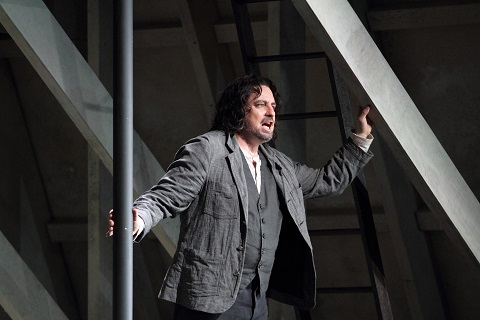 Matthew Polezani as Rodolfo. Photo credit: Catherine Ashmore.
Matthew Polezani as Rodolfo. Photo credit: Catherine Ashmore.
There is, I think, a yawning gap between the romance of Rodolfo and Mimì and the “bromance” of the boys in this production. Rodolfo and Marcello, in particular, had the kind of metrosexual relationship that one felt was constantly pushing boundaries. The symmetry of them both climbing the rafters in the garret and pumping their groins against it had the ritual, and ballet, of insects mating. In contrast, Rodolfo and Mimì often felt awkward together - and relied exclusively on their singing to push their romance. I’m not sure it helped one bit that Mimì looked exceptionally dour - I think if I had been Rodolfo I wouldn’t have bothered to light her candle, and I’d have thrown away her lost key. She looked positively Dickensian. Marcello and Musetta, however, were almost flagrant in their sexuality during her drunken waltz scene in Act II but by Act III this relationship has come to an explosive end as Marcello throws Musetta and her belongings out of the Tavern into the snow. If the one relationship is awkward this one is anything but: it’s passionate, intense and inflames the stage with emotion. It was almost unbearable to watch.
But Danielle de Niese, as Musetta, is nearly in danger of overwhelming this production. She is magnificent. Her voice is an incredibly powerful instrument, riding over the orchestra with shattering high notes. Her “ Quando m’en vo” was unforgettable, sensual, flirtatious and beautifully even of tone. Riveting to watch, she brings complexity to the character of Musetta: in Act II she exudes all the humour of a table-top dancer, in Act III you begin to feel this is a woman with depth of emotion as she trudges through the snow, and by Act IV her pathos has come full circle as she thinks only of selling her ear-rings to rescue Mimì from impending death. Musetta is clearly on a journey in this production - and Richard Jones and the costume designer, Stewart Laing, spare no effort in pointing this out quite explicitly: her dresses change throughout the production from fiery red, to a purified yellow, and finally a neutral dark.
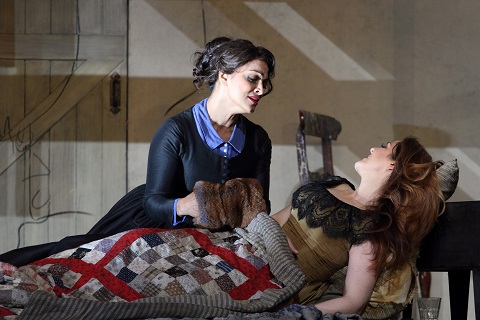 Danielle de Niese as Musetta and Maria Agresta as Mimì. Photo credit: Catherine Ashmore.
Danielle de Niese as Musetta and Maria Agresta as Mimì. Photo credit: Catherine Ashmore.
Our Bohemian “boys” experience no such epiphany, but again the singing is first rate. Matthew Polenzani’s Rodolfo might be too light for my tastes - I probably prefer a tenor who is darker, more plaintive and haunting (such as Sandor Konya, or even Domingo). Having said that, the lyricism of this tenor was unquestionably superb on opening night - and he was nowhere better than in “Che gelida manina” which, although being so cruelly exposed for the tenor, was brought off with considerable beauty and breath-taking poise (no need to transpose the high C down here). As I’ve hinted at earlier in this review, the Rodolfo and Mimì in this production conveyed much of their passion through their singing rather than the chemistry of their acting - which is somewhat against convention since by no stretch of the imagination could the role of Rodolfo really be considered a dramatic tenor part. That Polenzani manages to do that is a formidable achievement. If, ultimately, he lacks the hybrid of honeyed and Italianate warmth (this is a particularly Anglo-Saxon sung performance at times) he’s nevertheless entirely credible as both a lover and a Bohemian poet; the voice is entirely focussed at full stretch and his diction is clear. It was also a plus to hear a singer in this house finally sing some Puccini as the composer wrote it in his score - the soto voce markings are there if one bothers to sing them.
Maria Agresta’s Mimì - despite looking a drudge and anaemic for much of the opera, but I guess that comes with this most unglamorous of roles - achieves something quite rare in the part: she makes Mimì sound like Mimì and not like any other Puccini tragi-heroine. Every word had meaning, an expressive range that extended from her emotions of love through to despair. If de Niese’s Musetta had been an instrument of power, almost like steel in its ability to soar over an orchestra, Agresta’s voice is darker, richer - more like an iron fist wrapped in a velvet glove. The voices are entirely complementary. If Agresta’s Mimì isn’t the most moving I’ve heard, it’s entirely involving with enough vocal colour to avoid giving the impression that Mimì has been dying since Act I (some singers, believe it or not, sometimes make you feel this is the longest death scene in opera).
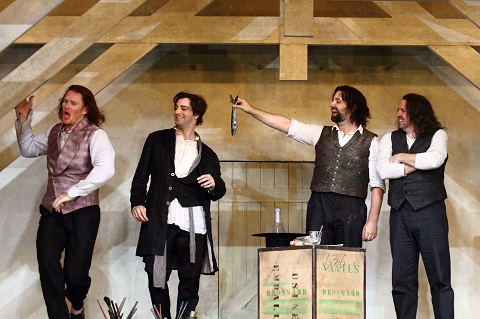 Duncan Rock as Schaunard, Fernando Radó as Colline, Etienne Dupuis and Matthew Polezani as Rodolfo. Photo credit: Catherine Ashmore.
Duncan Rock as Schaunard, Fernando Radó as Colline, Etienne Dupuis and Matthew Polezani as Rodolfo. Photo credit: Catherine Ashmore.
The rest of the cast is also very strong. Etienne Dupuis, as Marcello, has a beautifully defined baritone voice; I found him entirely compelling to watch and listen to, as I also did Duncan Rock as Schaunard. Both Dupuis and Rock have different kinds of baritone voices (a notable feature of this production is the very careful vocal casting of the major roles): Rock’s is darker, Dupuis’s slightly higher in range, often making me wonder whether the role of Rodolfo might one day be within his grasp (even if he does have to transpose down to a B flat some of those high notes). Fernando Radó was an exemplary Colline.
After the orchestra’s lacklustre playing back in January I had almost despaired hearing them play Puccini again. However, under the Italian Nicola Luisotti they were often inspired. Perhaps being sat in the fifth row from the stage, to the right of the orchestra pit, I was perhaps prone to a slightly more brass-heavy sound than usual - but the playing was transparent (the harp, for example, was entirely clear to me) and I can’t recall this orchestra playing Puccini with such lush, beautifully passionate playing. Luisotti neither lingered over the score, nor lost a grip on the drama and he supported his singers beautifully.
I’ve often come away from a performance of La bohème recalling Benjamin Britten’s thoughts on the opera: “After four or five performances I never wanted to hear La bohème again. In spite of its neatness, I became sickened by the cheapness and emptiness of the music.” The Royal Opera’s La bohème, especially when it’s this superbly well cast and played, does make me rather want to stick with the work.
Performances through to 20th July 2018, with cast changes.
Marc Bridle
Puccini: La bohème
Mimì - Maria Agresta, Rodolfo - Matthew Polenzani, Marcello - Etienne Dupuis, Musetta - Danielle de Niese, Schaunard - Duncan Rock, Colline - Fernando Radó, Benoît - Jeremy White; Director - Richard Jones, Conductor - Nicola Luisotti, Sets and Costume - Stewart Laing, Lighting - Mimì Jordan Sherin, Movement - Sarah Fahie, Orchestra of the Royal Opera House.
Royal Opera House, Covent Garden, London; 16th June 2018.
Image=http://www.operatoday.com/Musetta%202.jpg image_description=La bohème, ROH, Covent Garden product=yes product_title=La bohème, ROH, Covent Garden product_by=A review by Marc Bridle product_id= Above: Danielle de Niese as MusettaPhoto credit: Catherine Ashmore
June 16, 2018
Na’ama Zisser's Mamzer Bastard (world premiere)
Even though the journey is now a bit of a pain for me, it is always a joy to visit the Hackney Empire, infinitely preferable to the other of Frank Matcham’s London theatres that is sometimes used for opera. The quality is often very high, the location seemingly inciting visiting companies to their best; I am not sure I have ever seen a better Marriage of Figaro than that from the Royal Academy a couple of years ago . Not only bringing opera to Hackney but also taking it out of the West End is a very good thing; it genuinely seemed to have attracted a new, highly appreciative audience, half of which offered a standing ovation (something even Bernard Haitink receives less often in London than he does). The idea of an opera set in the Hasidic Jewish community was enticing too. I had no idea what to expect from any part of it, which always adds to the anticipation. Moreover, performances from all concerned were excellent, the Aurora Orchestra under Jessica Cottis perhaps the greatest stars of all. One had little doubt that one was hearing what one was supposed to hear. Gundula Hintz, too, shone as the mother, Esther: clearly moved and capable of moving.
Then, alas, comes the matter of the opera itself: so tedious that I genuinely feared - hoped? - I might fall asleep. I suspect something could have been made of some of the material (if not necessarily the musical material), given a few years’ hard work, rethinking, and experience. Director Jay Scheib wrote in the programme of the libretto, by Samantha Newton and Rachel C. Zisser, having been ‘written in the form of a screenplay. Transitions took the form of jump cuts,’ and so on. Would that it had come across with any such focus or direction. It jumps around with much confusion: not dramatic confusion, more ‘let’s say a bit about the Holocaust here … let’s stop for a while and have a “meaningful” pause,’ etc., etc.
The lack of focus in the libretto is redolent more of an initial pub sketch
of ideas for an opera than anything more thought out. It is not
fragmentary; it is certainly not challenging; it is barely a drama. Sub-
(very sub-)Katie Mitchell filming - sometimes with an awkward time-lag -
did little to help, and perhaps a little to hinder. In Scheib’s words,
‘Cameras have afforded us access to a dynamic vocabulary normally reserved
for the visual world of the cinema.’ Quite apart from the ignorance and
arrogance of the claim - have you seen any German theatre recently, even
ventured so far as the Royal Court? - little is revealed other than
occasional, clichéd flashes of blinding light: appearing, aptly enough,
long after lightning is supposed to have struck.
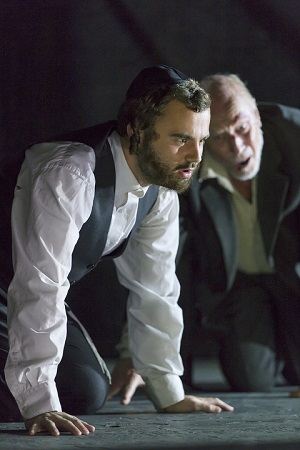 Collin Shay as Yoel, Steven Page as Stranger. Photo credit: Stephen Cummiskey.
Collin Shay as Yoel, Steven Page as Stranger. Photo credit: Stephen Cummiskey.
Much, though not all, of the music stands on the verge of embarrassing:
swathes of vague electronic noise, sound effects, interspersed with
cantorial and other trivial melodies, the marriage of word and text in the
latter quickly heading for the divorce courts. (As for the former, it is
good, perhaps, to learn that the Church of England holds no monopoly on
banal liturgical music.) Attempts to define what is and is not opera are
most likely bound to fail. That said, surely the idea that it should in
some way or other be more than a play with music, that its music itself
should be dramatic, seems a reasonable assumption. There are, at the close,
a few signs of such a dawning realisation on Na’ama Zisser’s part. Some
simple musical figures start to add up to something a little more than
themselves, musically and dramatically. For me, however, it was all too
late. As I said, a period of revision would have been in order; such
progress might then have been read back into what had gone before, far too
much of which came across as something akin to a school project: fine for
those involved and their proud parents, but for the wider world? Would you
want your sixteen-year-old essays on the meaning of life, the universe, and
everything published and distributed?
‘Eine Oper ist ein absurdes Ding,’ Strauss’s Capriccio Count tells his sister. In many ways, yes, although not always. It nevertheless takes a great deal of effort and experience to be properly absurd. The artifice in both Capriccio and Ariadne auf Naxos tell a story, moreover, quite different from that which a superficial reading of their synopses might suggest. Mozart was different, Apollo et Hyacinthus a superior work to half of those in the benighted working ‘repertoire’ of many opera houses. Perhaps if one is not Mozart, one might wait at least a little longer before testing the operatic waters. It has worked - magnificently - for George Benjamin. And yes, this doubtless rests on a view of works, masterpieces, the rest, considered hopelessly outmoded by some. I am not, however, even claiming that a work should necessarily be forever. (Let us leave posterity for another time, as it were.) However, if a work is not for now, or at least not yet ready, then someone ought to have asked questions more searching than the self-congratulatory discussion published in the programme.
Mark Berry
Younger Yoel: Edward Hyde; Yoel: Collin Shay; Stranger: Steven Page; Esther: Gundula Hintz; Menashe: Robert Burt; David: Netanel Hershtik. Director: Jay Scheib; Designer: Madeleine Boyd; Lighting: D.M. Wood; Video: Paulina Jurzec; Soundtrack designer: Yair Elazar Glotman. Aurora Orchestra/Jessica Cottis. Hackney Empire Theatre, London, Thursday 14 June 2018.
Image=http://www.operatoday.com/Robert%20Burt%20as%20Menashe%2C%20Gundula%20Hintz%20as%20Esther%20Stephen%20Cummiskey.jpg image_description=Na'ama Zisser's Mamzer Bastard (world premiere), ROH/Hackney Empire product=yes product_title=Na'ama Zisser's Mamzer Bastard (world premiere), ROH/Hackney Empire product_by=A review by Mark Berry product_id= Above:Robert Burt as Menashe, Gundula Hintz as Esther
Photo credit: Stephen Cummiskey
June 14, 2018
Les Arts Florissants : An English Garden, Barbican London
The term "garden" here refers to two of Sir William Christie's passions, music and gardens, and to the concept of baroque gardening, bridging nature and art. Baroque gardens turned landscape into theatre, combining art and nature for maximum impact.
Les Arts Florissants has for several seasons created "gardens" where music and song are arranged, like bouquets, to delight the senses. This "garden" brought together the beauties of the English baroque, with highlights from Purcell, Locke, Gibbons, Handel, Arne, Ward and Dowland.
Like a formal themed garden the programe was set out in two distinct parts, "The Mystery of Music" and "A Night of Revels". The scene was set by The Curtain Tune, an instrumental prologue to Matthew Locke's The Tempest (1674) an early English semi-opera adapting the spirit of Lully and Moliere to British theatrical tradition. This Tempest was loosely based on The Tempest of William Shakespeare, where Nature, magic and art come together in glorious mayhem. As the orchestra played, the singers entered the hall, hidden in darkness, their voices ringing out clearly. Placing the two parts of Orlando Gibbons The Cries of London at the start and end of this "garden" gave it structure, but the choice was inspired. Gibbons depicts the sounds of London, market traders calling out their wares "Hot apple pies, hot, Hot pippin pies, hot. Fine pomegranates, fine....buy a rope,,,white cabbage, white young cabbage". Each brief cry follows its own rhythm and the interplay between these simple calls creates intricate polyphony. "Low " society transformed into "high" art. Thence to Handel "O the pleasures of the plains" from Handel's Acis and Galatea , Purcell's If music be the food of love Z379 and Thomas Tomkins' Music Divine.
Lest all be gracious artifice, Thomas Arne's The Singing Club, a nod to the English taste for communal singing. It's humorous - a good singer singing about a singer who can't sing too well. Then a return to fantasy, with Handel and Purcell songs about music and the muse St Cecilia. The songs also showcased individual instrumental colour - flutes, lutes, pipes and violins, paired with complementary voices. From Thomas Arne's The Fairy Prince, "Now all the air shall ring" came the rousing final chorus "God Save the King!" Though Arne gave us our national anthem, the king in this case wasn't George III but the king of Fairyland, since Arne's masque is an adaptation of Ben Jonson's Oberon, itself an adaptation of Shakespeare. One singer waved the Union Flag . I closed my eyes for a moment to concentrate on the music, but suddenly the whole audience burst out in a roar of spontaneous applause. The singers were also waving the flag of the European Union, and the audience loved it ! British culture connects to Europe. Were it not for Handel, Mendelssohn and many others, where would British music be ? And the flags were perfectly appropriate, since the kings of Arnes's time came from Hanover.
Pealing bells ushered in the "Night of Revels" with "O let the merry bells ring round" from Handel's L'Allegro, Il Penseroso ed il Moderato. Two Purcell songs about Night and dreams "See, even night herself is here" and "One Charming Night" from The Fairy Queen Z629 and John Ward's Come, sable night. Sophie Daneman's semi-staging created great atmosphere. A singer herself, she's worked with Les Arts Florissants for some years, creating sensitive semi staging. Here she had the singers carry lights in the darkness, so we could see as well as hear the patterns of interaction. Night, though, isn't just for sleep. Thus the group of songs for merriment, starting with "In these delightful,pleasure groves" from Purcell's The Libertine, or the Libertine destroyed Z600, followed by "Welcome black night" and later "Cease these false spirits" from John Dowland's A Pilgrim's Solace which is about, to put it coyly, married love. Two Bacchanals from Purcell (Z627 and Z360) release unruly spirits. Men are pitted against women in Purcell's 'Tis women makes us love Z281. "Tis women makes us love, 'tis love that makes us sad. 'Tis sadness makes us drink, and drinking makes us mad!" Delivered, of course, with great panache. Then the famous "Fairest Isle, all isles excelling" from Purcell's King Arthur, or the British Worthy Z628, soothing and graceful. Night leads to morning and three songs of dawn from Handel and Purcell Then, back we were to London at the break of day, with the bustle of market traders and callers in Part 2 of Gibbon's The Cries of London.
This well-planned Garden of Delights came to life with Paul Agnew leading Les Arts Florissants. Part of the Les Arts Flo mission is the nurturing of youthful talent : hence Le Jardin de Voix, the academy for young singers, whose soloists gave vivacious performances. Some are very promising and deserve a good future. Their names - Natasha Schnur, Natalie Pérez, Eva Zaïcik, James Way, Josep-Ramon Olivé and Padraic Rowan.
Anne Ozorio
image=https://upload.wikimedia.org/wikipedia/commons/thumb/5/53/Henry_Purcell.jpg/302px-Henry_Purcell.jpg
image_description=
product=yes
title=
product_by= An English Garden : Les Arts Florissants, Le Jardin de Voix, conductor Paul Agnew, Barbican Hall, London. 8th june 2018 A review by Anne Ozorio
product_id=Above: Henry Purcell
Die Walküre in San Francisco
This was an evening of almost unbearable tension, the age old torment of love vs. duty taken to the summit of nineteenth century operatic accomplishment — and into the higher reaches of twenty-first century staging accomplishment, from the fleeting video image of a wolf to Hunding’s Appalachian cabin, from Valhalla’s sweeping vista of a crumbling black and white world to its monumental cementic bowels, and finally to the Zambello Walküre’s signature image, the valkyries parachute arrival onto a mountain peak, a peak that then burst into a circle of actual, live flame.
Far more than about its timely concepts (the “American” Ring, American environmental destruction, the abuse and subjugation of women), last night’s Walküre was about opera. It fully exposed the current artistic and technical resources that allow twenty-first century opera to transcend mere theater and operatic tradition itself to transport us to ever rarer states and durations of artistic understanding.
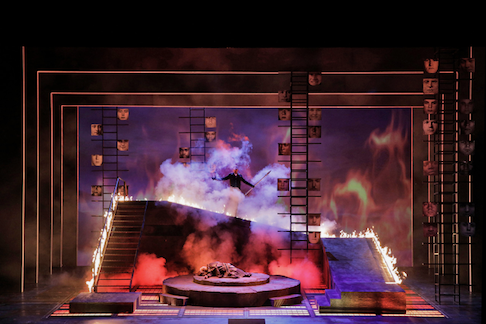 Wotan and Brünnhilde
Wotan and Brünnhilde
American bass-baritone Greer Grimsley’s Wotan, no longer the confident deal maker of Das Rheingold, was the sleek executive whose world began disintegrating when he took on its administration. Mr. Grimsley had hugely difficult encounters — with his wife Fricka, with his daughter Brünnhilde, and with himself when he learns that is daughter is, in fact, an extension of himself. Mr. Grimsley survived each encounter in magnificent voice, articulately humbling himself step-by-step to his very human and quite understandable and inescapable torment.
Swedish soprano Iréne Theorin, the valkyrie Brünnhilde burst onto the stage in a torrent of magnificent sounds that put to rest any regrets we may have harbored about the cast change (Evelyn Herlitzius cancelled at the last minute). Mme. Theorin brought the fiercely thrilling high notes of an Amazon warrior together with a richly warm, very feminine lower voice. With her significant use of piano and pianissimo tones this richness distilled her determined devotion to her father. But never far away were the forte’s of an emotional strength to be reckoned with.
The Fricka of American mezzo-soprano Jamie Barton eschewed the dignity that becomes the protector of basic family law not to mention protector of basic dynastic rights. Mlle. Barton continued her contemptuous, comedic Das Rheingold Fricka, thereby eviscerating the sanctity and solidity of the social contracts that bedevil Die Walküre’s Wotan. There is no question that Mlle. Barton is a fine singer, that she created a significant Die Walküre Fricka is another question.
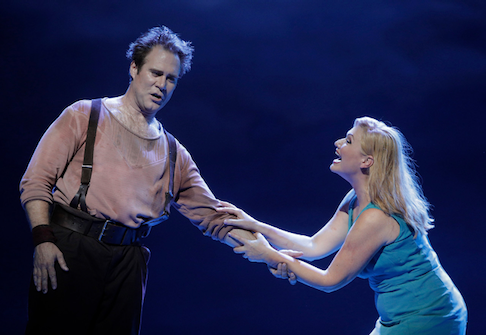 Siegmund and Sieglinde
Siegmund and Sieglinde
There is no question that Finnish soprano Karita Mattila created a Sieglinde of requisite magnitude for the Zambello Walküre. The magnetic presence of this esteemed artist found the youth and the postures of an abused woman, her marital guilts and finally her pride as the wife of her brother and the mother of his child. It was a portrayal teetering on the edge of, somehow not surpassing, credibility — no small task for her adultery and incest. That Mme. Mattila could vocally create Sieglinde is another question.
American tenor Brandon Jovanovich brought perfection to his Siegmund, finding and exploiting the subtleties of the Wagnerian vocal line that gave immense, and new pleasures. Siegmund is a romantic hero with stories to tell. Jovanovich has the purity of voice to exploit the emotional innocence of Siegmund's adventures, and to fall victim to his hopeless love and to die for this love. With conductor Runnicles, Jovanovich and la Mattila brought the Act 1 love duet to its intended magical conclusion.
American bass Raymond Aceto created the Hollywood male predator, oozing masculinity and brute force, and doing all this in beautiful, intelligent voice while groping his wife Sieglinde. Entirely absent was a sympathy one might extend to this husband whose wife elopes with a stranger who stops by for the night.
Finally though this evening belonged to the San Francisco Opera Orchestra and its conductor Donald Runnicles whose presence was acutely and profoundly felt through the often exquisite performances on stage, and the staging itself which was expectedly masterful.
Michael Milenski
Cast and production information:
Brünnhilde: Iréne Theorin; Wotan: Greer Grimsley; Sieglinde: Karita Mattila; Siegmund: Brandon Jovanovich; Fricka: Jamie Barton; Hunding; Raymond Aceto; Siegrune: Laura Krumm; Grimgerde: Renée Rapier; Ortlinde: Sarah Cambidge; Gerhilde: Julie Adams; Rossweisse: Lauren McNeese; Schwertleite: Nicole Birkland; Helmwige: Melissa Citro; Waltraute: Renée Tatum. San Francisco Opera Orchestra. Conductor: Donald Runnicles; Production/Stage Director: Francesca Zambello; Associate Director: Laurie Feldman; Choreographer: Denni Sayers; Set Designer: Michael Yeargan; Costume Designer: Catherine Zuber; Lighting Designer: Mark McCullough; Projections: Jan Hartley. War Memorial Opera House, San Francisco, June 13, 2018.
image=http://www.operatoday.com/Walkure_SFO1.png
image_description=
product=yes
product_title=Die Walküre in San Francisco
product_by=A review by Michael Milenski
product_id=Above: Greer Grimsley as Wotan, Iréne Thoerin as Brünnhilde [All photos by Cory Weaver, courtesy of San Francisco Opera].
June 13, 2018
Das Rheingold in San Francisco
Ring fever was high in the rather-more-than-usual well-dressed, quite excited crowds (standees three deep) present for the first part of the famous tetralogy of three operas plus satyr play (that’s Das Rheingold).
Though first, Rheingold was the last of the tetralogy composed, thus Wagner had already forged the means to taunt us with the magic fire music that will protect us and finally consume us this Sunday, fire that issued full force from the mighty forces of the superb San Francisco Opera Orchestra of ninety players — curious ears were cocked for four Wagnerian tubas. Conductor Donald Runnicles, of the 2011 San Francisco Ring again sustained a convincing Wagnerian continuum.
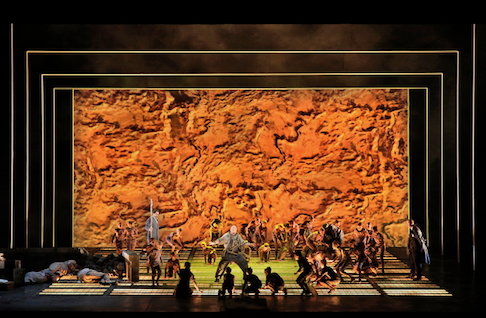 A moment in the Nibelungen workshop
A moment in the Nibelungen workshop
Back in 2008 when Francesca Zambello’s 2006 Rheingold was unveiled here in San Francisco the chorus of anvils (last night six off-site players hammered 15 tuned anvils) was prelude to a surprising, indeed stunning vision of the Nibelungen workshop with its multitude of child workers (this was the Industrial Revolution after all). For many of us this was the third time for this revelation, hopefully it once again thrilled those new to this production.
In pre-opening press events care was taken to stress important modifications to the original production, specifically the recasting of many of the proscenium wide videos that now impose video designer S. Katy Tucker’s take on Richard Wagner’s gloriously imposing soundscapes, beginning with the visual play of vastly magnified water molecules intended to introduce the theme of environmental destruction, an important element of the Zambello production.
As well digital technology in more recent years has added stage floor video and lighting possibilities to scenography. This was present in the checkerboard of video screens that was now the stage floor pavement offering the intrusion of ever greater color interpretation. Perhaps an unintended theme to Mme. Zambello’s production will be the tyranny of technology.
The most significant addition to the production is the splendid cast that was introduced to us last night starting with the elegant and cocky shyster Wotan of bass baritone Greer Grimsley. Mr. Grimsley’s well-focused voice promises us an unusually articulate Wotan who has a lot of tough stuff to come to grips with in the next two operas. Of startling effect was the Alberich of German bass baritone Falk Struckmann in his role debut. Mr. Struckmann, once a formidable Wotan himself, was of well-voiced, sufficiently evil stature to forge an amazing weapon of destruction (the ring) and impose its use (his curse).
Dominating the proceedings was the Loge of Czech tenor Stefan Margita (a veteran of the 2008 production in his role debut) — oh so charming, impertinent, supercilious and oh so profoundly cynical. Mr. Margita’s Rheingold Loge was of masterpiece status.
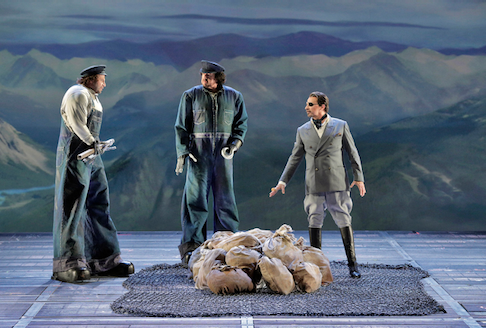 Fafner, Fasolt and Wotan
Fafner, Fasolt and Wotan
The Zambello Rheingold coup de théâtre is of course the builders of Valhalla, the giants (literally) Fasolt and Fafner. Fasolt, sung by baritone Raymond Aceto (tonight’s Hunding) is smoother and a bit smarter than Fafner, sung by bass Andrea Silvestrelli in a rough and dumb voice. Directorially his mutual infatuation with Freia, beautifully sung by the aspiring dramatic soprano Julie Adams, was ostentatiously overstated. Tenor Brandon Jovanovich (tonight’s Siegmund) added fun, empty-headed personality to Wagner’s conceited gods as Froh, and baritone Brian Mulligan redeemed his pallid Donner with a splendidly delivered command of the storm that clears the skies for a vision of Valhalla (unseen).
Mezzo soprano Jamie Barton as Wotan’s wife Fricka has yet to prove herself. That she may do tonight in Die Walküre. Plus we will find out on Friday much more about the Mime of David Cangelosi.
Some of the locales of this first installment of the “American” Ring seemed less specific. Huge billows of stage fog obliterated what I remembered as a gold prospector’s gully, and now the Rhine maidens were burdened with cumbersome, self conscious choreography. As the Rhine valley the Gilded Age ambience of the Newport R.I. was fully intact.
Mme. Zambello did not take a bow.
Michael Milenski
Cast and production information:
Wotan: Greer Grimsley; Alberich: Falk Struckmann; Loge: Stefan Margita; Mime: David Cangelosi; Froh: Brandon Jovanovich; Donner Brian Mulligan; Fasolt: Andrea Silvestrelli; Fafner: Raymond Aceto; Fricka: Jamie Barton; Freia: Julie Adams; Erda: Ronnita Miller; Woglinde: Stacey Tappan; Wellgunde: Lauren McNeese; Flosshilde: Renée Tatum. San Francisco Opera Orchestra. Conductor: Donald Runnicles; Production/Stage Director: Francesca Zambello; Associate Director and Choreographer: Denni Sayers; Set Designer: Michael Yearden; Costume Designer: Catherine Zuber; Lighting Designer: Mark McCullough; Original Projections: Jan Hartley; Additional Projections: S. Katy Tucker. War Memorial Opera House, San Francisco, June 12, 2018,
image=http://www.operatoday.com/Rheingold_SFO1.png
image_description=Photo by Cory Weaver, courtesy of San Francisco Opera
product=yes
product_title=Das Rheingold in San Francisco
product_by=A review by Michael Milenski
product_id=Above: Falk Struckmann as Alberich, Greer Grimsley as Wotan
Photos by Cory Weaver, courtesy of San Francisco Opera
ENO's Acis and Galatea at Lilian Baylis House
There’s nothing very pastoral, though, about ENO’s Acis and Galatea which, as the Coliseum is hosting a series of summer revenue raisers ( Opera North’s Kiss Me, Kate arrives next week), is being performed at ENO’s rehearsal space, Lilian Baylis House. The only ‘greenery’ in director Sarah Tipple’s hyper-active production, is the astro turf beneath the feet of the orchestra, seated to one side in a mirror-clad grotto which does its best to hint at leafy groves and trickling streams.
Designer Justin Nardella’s set presents a panoply of party-props - a livid yellow fancy-dress box (though the merry-makers’ Hawaiian shirts, wellies, out-size spectacles and outlandish head-gear are surely ‘fancy’ enough), beach balls, plastic dinosaurs, inflatable unicorns, and the like. And, should the ‘hedonism’ over-heat, the party-planner - a nerdy type, who wanders in from time to time, checking his itinerary on an i-Pad - has ensured that they have a convenient cool-drinks dispenser at their disposal.
The revellers are social media techies, and these self-regarding selfie-takers are kept doubly entertained as they watch their own carousing and cavorting unfold via four corner-stationed, huge i-Phones. During the party-games, Galatea is ‘crowned’ Queen and draped in ermine. As she and Acis canoodle, ‘O happy we!’ the members of the ENO Chorus sing, in hearty and joyful voice, as they swig beer, dance with unselfconscious abandon, and flop on bean-bags for a time-out. Indeed, perhaps they’d swigged a few too many bottles for the choric cries of glee drifted a bit behind conductor Nicholas Ansdell-Evans’ swift beat.
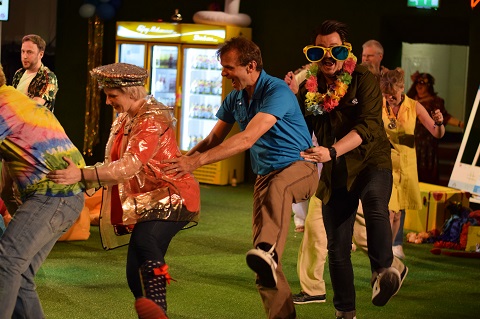 Ella Kirkpatrick, Michael Burke, Adam-Sullivan and ENO Chorus. Photo credit: Dani Harvey.
Ella Kirkpatrick, Michael Burke, Adam-Sullivan and ENO Chorus. Photo credit: Dani Harvey.
There’s nothing wrong at all with Sarah Tipple’s decision to eschew Ovid’s pastoral paradise and John Gay’s satirical lampooning, and to present the mythical romance as a slight tale of modern-day merry- and mischief-making. After all, Acis and Galatea began life as an entertainment for a private party, commissioned c. 1718-20 by James Brydges, Earl of Carnavon and later Duke of Chandos, to amuse the guests at Cannons, the stately home on his grand Middlesex estate. And, in contrast to Martin Parr’s production of the opera at St John’s Smith Square, during this year’s London Handel Festival, at least this time the balloons stayed firmed affixed to the walls and ceiling, sparing us an explosive accompaniment.
But, as I noted in my review of the LHF performance, while there is ‘much irony in Gay’s text, with its parodic echoes of nonsensical Arcadian conceits and interplay of ‘high’ and ‘low’ […] the challenge is to distinguish between, and marry, textual levity and musical earnestness’. And, it’s this unity and balance between partying and pathos that Tipple doesn’t succeed in achieving.
When the party ends in the inevitable punch-up, and the Chorus laments the death of Acis, the party-planner rushes in, puts Acis in the recovery position and hastily commences CPR while the stunned revellers prove not sufficiently shocked to refrain from recording the victim’s last breaths for their Facebook page. Though it was a welcome moment of tender stillness after all the manic agitation, the opera’s ‘high-point’, the choric lament ‘Mourn all ye muses’, which is sung over the body of the slain Acis, lacked gravitas and true sentiment; the poignant simplicity of “The gentle Acis is no more” seemed merely glib.
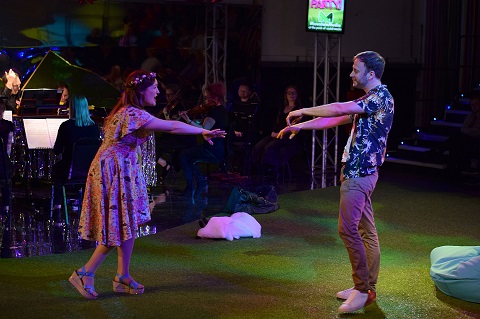 Lucy Hall (Galatea) and Alexander Sprague (Acis). Photo credit: Dani Harvey.
Lucy Hall (Galatea) and Alexander Sprague (Acis). Photo credit: Dani Harvey.
There was some fine playing and singing, though, not least from the ENO Chorus, though the traverse set-up made it hard for the choral and instrumental groups to blend. Alexander Sprague, as Acis, had plenty of spring and slice in his pleasing tenor, perfect for this confident charmer dressed in glitter-red sneakers and cool shades who was prone to showing off his press-up prowess mid-aria. Indeed, perhaps this Acis was a bit too self-regarding for at times it was hard to believe in the sincerity of his love - a distrust which was exacerbated when the cynical Damon rolled a cigarette during Acis’s avowal of love.
Lucy Hall’s soprano is vibrant, full of rippling colours, relaxes and blossoms as it rises. She was terrific as the flirtatious Galatea, whose cocked eyebrows suggested was she was quite tempted by Polyphemus’ ardent attentions.
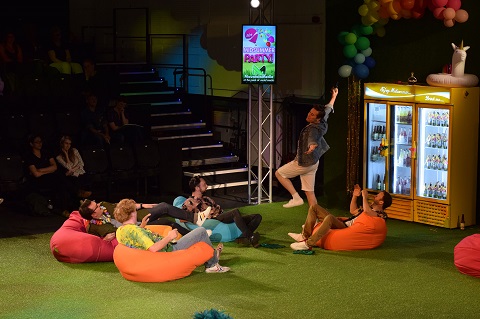 Bradley Smith (Damon). Photo credit: Dani Harvey.
Bradley Smith (Damon). Photo credit: Dani Harvey.
Bradley Smith was a good foil to Sprague. His tenor has a softer edge, just right for party-pooper Damon, demure in denim, though his singing was not always sufficiently agile in the coloratura passages to keep up with the terrifically bright and brisk playing of the instrumentalists from the ENO orchestra, who were whipped through their paces with gleeful lightness by Ansdell-Evans.
Though this Polyphemus was no monstrous Cyclops, Matthew Durkan injected some beguiling darkness into his baritone. It was a shame that the vocal menace was rather undercut by the petulant antics that Tipple had him perform. When Galatea rejected his regal advances, he tore off his cloak in a fit of pique and stamped like a three-year-old on his plastic crown. Worn out by his toddler tantrum, Polythemus threw himself down on a pink pillow and promptly fell asleep, affording Acis and Damon the opportunity to creep back in, paint his face with marker pen and lipstick, and strap him into a lurid green bra.
Tipple thus denied this Polyphemus any dignity, and we did not feel the immensity of his burning love, only his peevish anger. She also struggled to squeeze the opera’s ending into her concept. For, in Ovid’s tale, when the jealous Polyphemus has crushed Acis to death under a boulder, the distraught Galatea fortuitously recalls her divine powers and transforms the dead Acis into a stream, thus granting him immortality. Clearly there could be no such transfiguration by water of this dead party-goer. The solution? A stream of ‘pictures of a life’ on Galatea’s Instagram account and a flowing conga-chain of dancers. With the prone body of Acis before us, this lieto fine left slightly a nasty taste.
Claire Seymour
Acis - Alexander Sprague, Galatea - Lucy Hall, Polyphemus - Matthew Durkan, Damon - Bradley Smith; Director - Sarah Tipple, Conductor - Nicholas Ansdell-Evans, Designer - Justin Nardella, Associate costume designer - Sarah Hamza, Lighting designer - Jennifer Rose, Movement director- Gemma Payne, Members of ENO Orchestra and Chorus.
Lilian Baylis House, London; Monday 11th June 2018.
Image=http://www.operatoday.com/Acis-and-Galatea-c-Dani-Harvey.jpg image_description=Acis and Galatea, ENO, Lilian Baylis House product=yes product_title=Acis and Galatea, ENO, Lilian Baylis House product_by=A review by Claire Seymour product_id= Above: ENO, Acis and GalateaPhoto credit: Dani Harvey
June 12, 2018
Lohengrin at the Royal Opera House
If Barrie Kosky’s Carmen proved something of a flop, there has been much to ponder and indeed to inspire from Krzysztof Warlikowski’s From the House of the Dead , superlatively conducted by Mark Wigglesworth, and most recently, George Benjamin’s new operatic masterpiece, Lessons in Love and Violence . David Alden is perhaps not the most obvious directorial choice for Wagner, though his ENO Tristan - the first I saw - certainly had its merits. He pretty much had the field to himself, though, given that Covent Garden’s previous staging was the lamentable fancy-dress pageant served up by Elijah Moshinsky, its final reheating coming as late as 2009 . On the face of it, Alden’s move to the 1930s must have come to a shock to the more reactionary elements always present in a Wagner audience. That it does not seem to have done so suggests either a welcome opening of minds or something - at least, according to one reading, like Lohengrin - rather less substantial than one might have initially presumed.
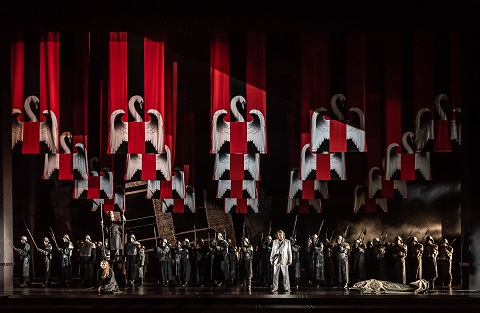 Photo credit: Clive Barda.
Photo credit: Clive Barda.
I wish it had been the former but Alden’s production ultimately proved conventional, all too conventional: more a potential shell for something more interesting than a remotely finished - even ready - production in itself. Designs and some stage direction, notably that of the chorus, are suggestive, but where is the dramatic grit? To offer a Lohengrin come as redeemer to a society broken by war is of course to follow Wagner precisely; to shift the actual war to something closer to our modern concerns is no bad thing at all. He unifies a people in disarray through his charismatic authority, yet ultimately cannot fulfil his duty and rejects his people.
Nazi parallels, or rather premonitions - like Marx, Wagner is often at his very strongest in pointing to where the twentieth and twenty-first centuries would go wrong - are obvious, yet none the worse for that. Even that level of critique will, after all, stand as a rebuke to those who follow that disingenuous old Nazi, Curt von Westernhagen, railing against the fresh theatrical wind of the 1970s: ‘Directors who deem themselves progressive when they transform the Ring back into a drama with a “message” have no idea how regressive this approach is in relation to the genesis of the work itself.’ Westernhagen’s scholarly methods are now as discredited as his ideology. Disciples remain, though, and few things get them so hot under the collar as Nazis on stage. Clue: they like it, really .
That said, simply to update is never enough. Indeed, it is to adopt the Westernhagen fraternity’s strange delusion that a production more or less is its designs (here, handsome indeed, for which great credit should be accorded to Paul Steinberg in particular). In many ways, when and where something is set, or is not, is the least interesting thing of all; at best, it is a starting-point. Save for that arresting, almost cinematic (Riefenstahl at a push) direction of crowd movement, its dramatic import obvious yet undeniably powerful, there is not much to get one’s teeth into. If the setting remains largely undeveloped, too much also seems awkwardly reminiscent of other productions. Had you never seen a German Lohengrin, you might remain, often literally, in the dark; Wagner and indeed many in his audiences surely deserve greater credit than that.
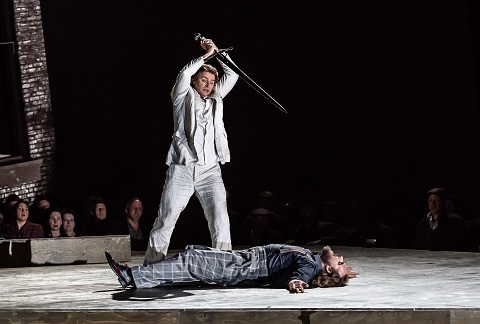 Klaus Florian Vogt as Lohengrin, Thomas J. Mayer as Friedrich von Telramund. Photo credit: Clive Barda.
Klaus Florian Vogt as Lohengrin, Thomas J. Mayer as Friedrich von Telramund. Photo credit: Clive Barda.
A King Henry whose hunched body language was a little too close to comfort to that of Hans Neuenfels’s Bayreuth production is one thing, but a falling of banners for war that aped the close of the second act of Stefan Herheim’s Parsifal is another again. If some point had been made about Wagner, the Nazis, and Bayreuth, it might have worked, I suppose; here, it seemed gratuitous and frankly derivative. What the point of describing the pages as ‘four women at the wedding’ may have been I do not know: if you like that sort of thing, then that will doubtless be the sort of thing you like. A sudden design apparition from Neuschwanstein seems merely a change of scene. Again, one can see why such an image might have a point in a fascist, even Nazi, setting, but it needs at some level to be made, not merely assumed. Dramatic motivation, then, largely eluded me. Such irritations pointed to a greater problem: a conceptual weakness at the heart. I suspect it can be remedied: if a shell, it is a fine shell. It will not, however, remedy itself.
Perhaps the same once had been true of Moshinsky. At any rate, this evening shared something else important with that final outing of 2009: musical excellence. Andris Nelsons, who conducted Neuenfels’s production at Bayreuth, was not at his strongest here, especially in the first act. Indeed, there both Nelsons and Alden seemed intent, consciously or otherwise, to underline what can often seem to be its rather static nature rather than to enliven the drama. However, Nelsons drew increasingly lovely playing from the orchestra, lower strings and woodwind in particular, and made often quite extreme second-act rubato - not to be confused with tempo variation - work, rather than seem merely mannered. His command of the architecture in the second and third acts impressed. Still more so did the outstanding singing from the chorus and extra chorus. William Spaulding’s work here is clearly reaping rewards, just as it did at Berlin’s Deutsche Oper .
Klaus Florian Vogt’s Lohengrin is a known quantity: known also, of course, to Nelsons from Bayreuth. I am less enthusiastic than once I was: the purity is less consistently apparent, the blandness more so. (Or maybe I am just tired of it.) However, it remains impressive on its own terms; one’s response to his singing will perhaps be more than usually personal. Replacing the originally advertised Kristine Opolais, Jennifer Davis impressed greatly as Elsa. This was by any standards a high-profile debut. Vocal and dramatic sincerity were matched by a security one had little right to expect. Thomas Johannes Mayer, also of recent Bayreuth fame, more than hinted at a properly complex Telramund, even if his artistry received little help from the staging. Christine Goerke’s Ortrud climaxed in properly blood curdling cries at the close, although again I had the impression a deeper production would have brought out something - well, deeper. Georg Zeppenfeld did what he could with the Neuenfels King-redux; that again was impressive indeed. Only Kostas Smoriginas, as his Herald, disappointed: often uncertain of verbal and musical line alike.
 Christine Goerke as Ortrud, Jennifer Davis as Elsa von Brabant, Klaus Florian Vogt as Lohengrin. Photo credit: Clive Barda.
Christine Goerke as Ortrud, Jennifer Davis as Elsa von Brabant, Klaus Florian Vogt as Lohengrin. Photo credit: Clive Barda.
The audience, part of one’s experience whether we like it or not - unless one happens to be Ludwig II, and even then… - proved something of a trial. Someone’s telephone vibrated throughout the first minute or so of the first-act Prelude, the culprit eventually shouting ‘Yes! I’m going to turn it off’. A friend heard someone else announce upon Lohengrin’s arrival: ‘I prefer it when he wears golden armour.’ Coughing, electronic terrorism, and inanity aside, they seemed to like the production: rarely a good sign. Given what they will boo… Still, there is, I am sure, room for something more to take shape within its framework; perhaps they will do so then. Moreover, there is, I assure you, a genuinely exciting prospect for the new Lohengrin at Bayreuth this year. At least on this occasion, my lips must remain better sealed than Elsa’s. The world, however, is likely to see a worthy successor to Neuenfels from Yuval Sharon, in a production that penetrates more deeply to the work’s essence and grapples with its implications.
Mark Berry
King Henry the Fowler: Georg Zeppenfeld; Lohengrin - Klaus Florian Vogt; Elsa: Jennifer Davis; Friedrich von Telramund: Thomas Johannes Mayer; Ortrud: Christine Goerke; King’s Herald: Kostas Smoriginas; Brabantian Nobles: Konu Kim, Thomas Atkins, Gyula Nagy, Simon Shibambu; Pages: Katy Batho, Deborah Peake-Jones, Dervla Ramsay, Louise Armit; Gottfried: Michael Curtis. Director: David Alden; Set Designs: Paul Steinberg: Costumes: Gideon Davey; Lighting: Adam Silverman; Video: Tal Rosner; Movement: Maxine Braham. Royal Opera Chorus and Extra Chorus (chorus director: William Spaulding)/Orchestra of the Royal Opera House/Andris Nelsons (conductor). Royal Opera House, London, Thursday 7 June 2018.
Image=http://www.operatoday.com/Lohengrin%20production%20image%20Barda.jpg image_description=Lohengrin, Royal Opera House, Covent Garden product=yes product_title=Lohengrin, Royal Opera House, Covent Garden product_by=A review by Mark Berry product_id= Above: ROH, LohengrinPhoto credit: Clive Barda
June 10, 2018
Stéphane Degout and Simon Lepper
Lessons in Love and Violence - and Simon Lepper. We began with Fauré, whose songs alas often leave me cold. (I have little doubt the fault lies with me.) Such was not the case here, however. Perhaps I have at long last found the key to the door: I do hope so. That Degout was fully in command of an often elusive - and not only to non-Francophone artists - idiom might have been expected; that I was put in mind of the mastery, rather than any specifics, of a Gérard Souzay had me realise from the off that these would be no ordinary performances. Lepper, in the opening Aurore, captured just the right sort of 'floating' tone to the piano part too, the composer's harmonic subtleties suspended. Surpassing elegance here and in the following Poème d'un jour did not preclude death (of the stars) at the close but rather proved its agent. Turbulence and torment naturally marked Toujours - the sequence was splendidly programmed - albeit within a similar yet far from identical framework. Lepper was permitted in its final stanza a hint at Lisztian pianism, which he gratefully took - and communicated. Fauré sometimes puts me in mind of Elgar; for me, it was an almost Elgarian dignity that characterised the prelude to Adieu, even though chronologically that was the wrong way around. Automne offered a nice link to Brahms, the music darkening, the crucial role for the piano bass line brought out without exaggeration. A perfect sadness in its final line - Où jadis sourit ma jeunesse! - sounded not un-Wagnerian. Is it fanciful to hope for an Amfortas some day…?
There is certainly no problem with Degout's German: clean and meaningful as his musical line. The dark simplicity of Brahms's O kühler Wald mirrored that forest itself. Darker shadows ('dunklere Schatten') were sought and found in Die Mainacht, providing relief for its premonition of the soprano solo movement in Ein deutsches Requiem. Brief, unmistakeably late, inner tumult characterised Auf dem Kirchhofe, even before its chorale reference: 'O Haupt voll Blut und Wunden'. It is a different, yet not entirely unrelated Einsamkeit - and certainly was in performance - that we heard in Feldeinsamkeit. As ever, Degout's reserves of breath seemed endless. Alte Liebe seemed almost to reminisce about Schubert, retaining consciousness that reminiscence was now all that was possible: old love indeed. Darker, still more Romantic, Nicht mehr zu dir zu gehen seemed almost - whether I am sentimentalising or not - to speak of Brahms's passion for Clara Schumann. And it was a Brahmsian echo of Schubert's Winterreise crow that seemed to hover over Willst du, dass ich geh? It may have ended in the major mode, but it was hardly affirmative. Brahms's 'lateness' spoke for itself, here and elsewhere; it neither needed nor received underlining.
Schumann (Robert, that is) had the second half: his Kerner Lieder, op.35. It was a stormy night indeed with which the set opened, thus picking up tendencies from both Fauré and Brahms, yet also turned us towards new paths - or Neue Bahnen, as someone, I believe, once put it. The ambiguity of its close seemed almost to open a new door for us; there was certainly no reason not to follow its hint. An illumined quality to the following 'Stirb, Lieb' und Freud'!' proved spellbinding, never quite permitting one to put a finger on the source of that light: artistry indeed. Muffled bells sounded not only on the line in question ('Alsbald der Glocken dumpfer Klang'), but subliminally throughout, prefiguring in context the ambiguous swagger of 'Wanderlied'. Schumannesque sadness was captured to a tee in 'Erstes Grün', nowhere more so than in Lepper's piano rubato, although not only there. A forest path took on metaphysical meaning too in 'Sehnsucht nach der Waldgesang', whilst 'Auf das trinkglas eines verstorbenes Freundes' seemed already to revisit past joys: the song of travel heard, as it were, through the aural lens of 'Erstes Grün', prior to the magical moonlight of the final stanza. It seemed as if the question of 'Frage' was posed without ever having arisen. Be that as it may, 'Stille Tränen' quite rightly offered the emotional climax. Relief and repose of a sort, in 'Wer machte dich so krank', again hinted at a hushed awe not so distant from Parsifal, an impression of holy ground furthered in 'Alte Laute'. If only an angel might have woken the narrator ('Und aus dem Traum, dem bangen, weckt mich ein Engel nur'), what if that angel were actually singing? Such perhaps was the thought that made the appreciative audience so reluctant to break rapt silence at its close.
Brahms's Lerchengesang, op.70 no.2, seemed very much to come 'after' Schumann's set. Degout and Lepper offered it as an encore that was beautiful in the very best sense: rare, painful, the opening of a new path to something else, something deeper.
Mark Berry
Programme:
Fauré: Aurore , op.39 no.1; Poème d'un jour, op.2; Automne, op.18 no.3; Brahms: O kühler Wald, op.72 no.3;Die Mainacht, op.43 no.2; Auf dem Kirchhofe, op.105 no.4;Feldeinsamkeit, op.86 no.2; Alte Liebe, op.72 no.1;Nicht mehr zu dir zu gehen, op.32 no.2;Willst du, dass ich geh? op.71 no.4; Schumann: Kerner Lieder, op.35. Wigmore Hall, London, Tuesday 5 June 2018.
image=http://www.operatoday.com/St%2B%C2%AEphane%20Degout_0JB0671-%C2%AEJean-Baptiste%20Millot.png
image_description=Stéphane Degout [Photo © Jean-Baptiste Millot]
product=yes
product_title=Stéphane Degout and Simon Lepper
product_by=A review by Mark Berry
product_id=Above: Stéphane Degout [Photo © Jean-Baptiste Millot]
An excellent La finta semplice from Classical Opera
But, it doesn’t matter if the drama is slight and the characters superficial when there are moments of real musical beauty and insight, and when the singing and playing are as fresh - and the commitment so unwavering - as they were at the Queen Elizabeth Hall where Classical Opera and The Mozartists gave the second of two London performances of La finta semplice (having begun their mini-tour in Birmingham the previous week).
Although Classical Opera’s epic MOZART 250 project has reached 1768, La finta semplice was not actually performed until the following year, in Salzburg, after Leopold Mozart’s plans to promote his son’s genius before the Viennese was scuppered by the resentment of the city’s resident musicians at the royal favour bestowed upon the adolescent upstart. Leopold wrote to Lorenz Hagenauer, a merchant in Salzburg, on 29 June 1768, that his son suffered ‘a full load of all varieties of the most carefully planned calumnies and malicious persecutions […] envy towers above us on all sides’. And, he was so incensed by what he perceived as the duplicity of Giuseppe Afflisio, a Neapolitan, described by Casanova as a mountebank and deceiver and who was the central figure in Viennese theatrical life at the time, that he presented a written complaint against Afflisio during a personal audience with Emperor Joseph II on 21 September 1768 - complaining when he had challenged the impresario about the singers’ repeated requests for alterations to both the libretto and the music, the incessant delays, the lack of financial recompense, Afflisio had declared the opera to be untheatrical and unperformable, and ‘finally he left me with the most shockingly uncharitable utterances: if I insisted on having the boy prostituted, he would have the opera laughed at and whistled off stage’.
Such machinations would not have been unworthy of the opera itself. For, it presents a cat’s-cradle of conspiracies and collusions which see Giacinta and her maid, Ninetta, gain permission to marry their sweethearts - Fracasso, a Hungarian captain, and his sergeant Simone - by convincing both of Giacinta’s two brothers, the women-hating Don Cassandro and women-fearing Don Polidoro, that Fracasso’s sister Rosina, the ‘semplice’ of the title, is in love with them.
All credit to the superb young cast who brought this flimsy fable to live with such vivacity, charm and comic nous. Exquisite costumes were complemented by an eighteenth-century desk and two chairs mounted on square platforms, first left and right of the QEH stage, and then brought together in a central, horizontal aisle after the interval. The stage was atmospherically lit by Mark Doubleday, the tints becoming increasingly nocturnal as the amorous charades and duplicities deepened.
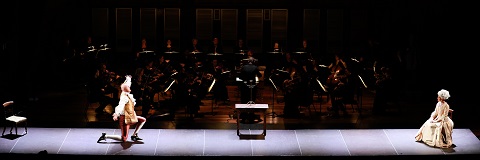 Lukas Jakobski (Cassandro) and Regula Mühlemann (Rosina). Photo credit: Benjamin Ealovega.
Lukas Jakobski (Cassandro) and Regula Mühlemann (Rosina). Photo credit: Benjamin Ealovega.
This minimalism was all that was needed to provide a little context for the engaging comedy which ensued. The singers’ movements were economical but deft and fluent; the musical conversations were convincing as the characters’ betrayed their flaws and foibles. Comic extravagance - as when Cassandro grabbed a violinists’ bow to ward off Fracasso’s sword in a mock-duel, or when Rosina tricked him into ‘singing’ a love-duet entirely in deliberately indecipherable sign language - was indulged but not over-done.
The Mozartists were seated to the rear of the stage and this did cause some ensemble problems, as conductor Ian Page frequently glanced over his shoulder to ‘catch’ singers who were not only some distance away but facing out to the audience, resulting in some slippage between ‘pit’ and stage - though Page invariably recouped neatly and, in any case, perhaps it all added to the dramatic tone of controlled chaos.
But, as Classical Opera return to the QEH twice next year - in January to perform a musical survey, ‘1769: A Year in Music’, and then in June to present a double-bill of Gluck’s Bauci e Filemone and Orfeo - it’s something that they might want to re-consider. Also, and this is in no way a criticism of the company, the surtitles-screen in the QEH hangs low and large, presumably to obscure - but not quite succeeding - the blue light of the digital projector set in the rear wall; the result is that it seems to ‘rest’ rather low above cast and orchestra. Add in the presentation of the text in a super-size font, and the libretto’s banalities loomed rather too large.
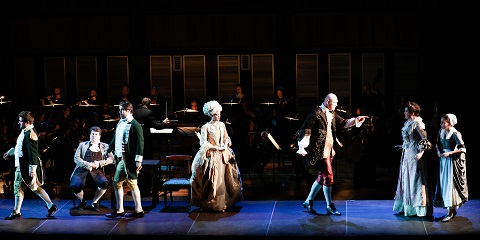 La finta semplice, Classical Opera & The Mozartists. Photo credit: Benjamin Ealovega.
La finta semplice, Classical Opera & The Mozartists. Photo credit: Benjamin Ealovega.
Small logistics aside though, the orchestral playing was excellent. The Mozartists accompanied proceedings with characteristic energy and brightness: strings scurried spiritedly and rhythms were always crisp; there was gleeful punchiness from the horns and both irony and eloquence from the oboes’ decorative commentaries. In this light, the continuo playing of Pawel Siwczak (harpsichord), Alex Rolton (cello) and Cecelia Bruggemeyer (double-bass) was even more impressive: how hard they must have had to listen to ensure that not one of Mozart’s musical punctuations in the recitatives - not always predictable and enlivened by action - missed its mark.
Though the score is fluent rather than phenomenal, the cast ensured that we appreciated each and every moment when one detects the heart-touching musical sensibility of the adult Mozart peeking through the adolescent assurance. Rosina’s soaring Act 2 duet summons to mind the profound serenity which so powerfully suspend time, and comic capering, in the later operas, while in the act-finales one can hear the young composer learning how to increase the dramatic complexity and musical pace of the ensembles by increments and with slickness and skill. Don Polidoro’s affecting serenade resonates with a sincere passion which the twelve-year-old could neither have experienced nor understood. Don Cassandro’s blustering looks ahead to the disgruntled raging and blundering of Dr Bartolo while the wily, worldly Ninetta is surely a prototype Despina. Recalling the Count’s ‘Contessa perdono!’, there is an aria of forgiveness at the close, but this time it’s the ladies who have to apologise and show remorse: and the musical beguilement works its magic - even Don Polidoro who loses both his pride and his bride, is prepared to forgive, so tickled with delight is he by the duping of his brother.
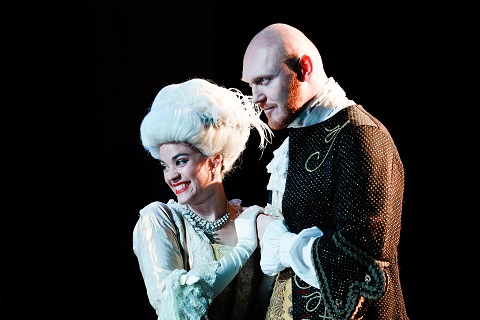 Regula Mühlemann (Rosina) and Lukas Jakobski (Cassandro). Photo credit: Benjamin Ealovega.
Regula Mühlemann (Rosina) and Lukas Jakobski (Cassandro). Photo credit: Benjamin Ealovega.
Regula Mühlemann was utterly enchanting as Rosina: no wonder both Dons were instantly besotted. She was a perfect faux naïf, operating with shrewdness in her duets with her two desperate suitors and relishing Rosina’s sly manipulations. The soaring lines of ‘Amoretti che ascosi qui siete’ bloomed serenely and with shapeliness: a delicate vibrato and the soprano’s silken tone evoked the true sensibility of this supposed ‘simpleton’, while lovely interjection from the violins, violas and bassoons, paired in thirds, added sweetness and colour.
Soprano Chiara Skerath was similarly impressive as Ninetta, ever clear and vivacious of voice, and acting with a combination of wit and composure. Giacinta, whose fear and woe at the hands of her bullying brothers instigates the proceedings, is then rather side-lined until the closing act, but Sophie Rennert used her warm, expertly modulated mezzo-soprano voice to suggest both Giacinta’s anxious timidity and engaging depths of character that plot and text do not even begin to intimate.
Lukas Jakobski enjoyed himself as the self-satisfied and initially reluctant would-be seducer, Don Cassandro. His dark, resonant bass was the perfect fit for Cassandro’s ham-fisted egoism, and if Jakobski occasionally overdid the hamming, his drunken bewilderment and incompetence certainly raised a smile. Alessandro’s gentle tenor beautifully expressed the hapless, hopeless Don Polidoro’s tender but ardent avowal of love, ‘Sposa cara’. As Fracasso and Simone, tenor Thomas Elwin and bass Božidar Smiljanić seemed a little less happy in their military shoes but sang warmly and with engagement.
Classical Opera continue their exploration of the year 1768 at Wigmore Hall, where they will perform Mozart’s Bastien und Bastienne on 18 th September - a performance which ties in with the release of the next recording in the company’s Mozart opera series.
Claire Seymour
Rosina - Regula Mühlemann, Ninetta - Chiara Skerath, Giacinta - Sophie Rennert, Don Polidoro - Alessandro Fisher, Fracasso - Thomas Elwin, Don Cassandro - Lukas Jakobski, Simone - Božidar Smiljanić; Director/Conductor - Ian Page, Assistant Director - Adam Torrance, Lighting Designer - Mark Doubleday, Design Supervisor - Emily Adamson, Lighting Programmer - Paul Halgarth, The Mozartists.
Queen Elizabeth Hall, London; Friday 8th June 2018.
image=http://www.operatoday.com/Ninetta%2C%20Polidoro%2C%20Rosina.jpg image_description=La finta semplice: Classical Opera & The Mozartists, Queen Elizabeth Hall product=yes product_title=La finta semplice: Classical Opera & The Mozartists, Queen Elizabeth Hall product_by=A review by Claire Seymour product_id=Above: Ninetta (Chiara Skerath), Don Polidoro (Alessandro Fisher) and Rosina (Regula MühlemannPhoto credit: Benjamin Ealovega
June 9, 2018
Pan-European Orpheus : Julian Prégardien
Orpheus himself is described in the first set, beginning with a song by Robert Johnson (1583-1633), it begins with strong single chords and bold exclamation : "Orpheus, I am, come from the deeps below, to thee, fond man, the plagues of love to show". Dramatic declamation "Ha-a-a-ark ! how they groan who died despairing". Ma, divertirmi lo voglio from a opera from 1683 by Antonio Draghi (1634-1700), with an extended central section where low timbred strings - violas de gamba and theorbos-sing a grave yet sensuous melody, enchanting the beasts of the wild. The pace picks up more brightly as Orpheus moves on. Maurice Greene (1696-1755), who was Master of The King's Music to George II, set Shakespeare for Orpheus with His Lute, the vocal line elegantly decorated, and accompanied by flute and harpsichord. It is followed, aptly, by Greene's successor, William Byrd's Come woeful Orpheus an instrumental piece for violins and violas de gamba. In contrast, a return to a much earlier sensibility, with Als Orpheus schlug seine Instrument, by Gabriel Voigtländer (1596-1643). The vocal line is pure, with minimal accompaniment, each strophe clearly defined - almost a Minnelied ! Voigtländer, who was part of Wallenstein's army in the Thirty Years War, published a well known collection of songs.
Eurydice is introduced by Antri ch' o miei lamenti by Jacapo Peri (1561-1633), first performed at the Pitti Palace. Accompanied by baroque organ and muted strings, it's a stately piece, the vocal line laudatory. Similar orchestration for Nachtklag, from Johann Erasmus Kindermann (1616-1655) to a texts by Martin Orpitz, the "Father of German Poetry" and contemporary of Shakespeare. Kindermann, who came from Nuremberg and would have known of Hans Sachs as well as Orpitz, so his Opitianischer Orpheus from which several,pieces on this recording are taken, sounds like an interesting work which might be worth hearing in greater depth. Jacopo Peri's lively Al fonte, il prato, and Fransceco Rasi's Filia Mia are followed by Claudio Monteverdi's Vi ricorda o boschi ombrosi, from Orfeo, Orpheus's song of love for Eurydice.
But as we know, Eurydice dies on her wedding day. Mournful pipes (flutes) and organ introduce Luigi Rossi's Les pleurs d'Orphée ayant perdu sa femme from Rossi's opera Orphée, a great success at the Palais Royale in 1647. Two airs by Thomas Campion, Break now, my Heart and Oft have I sigh'd , give vocal expression to Orpheus's grief. From Jacopo Peri's opera L'Euridice, Non plango. where the vocal line is at once plangent and dramatic. From Johann Erasmus Kindermann's Opitianischer Orpheus, the air Jetzund kommt die Nacht herbei Orpheus plans to challenge Death itself. An anonymous Passacaglia for lautenwerk (lute-klavier) strings marks Orpheus's entry into the Underworld. Henry Purcell's Charon the peaceful shade invites invokes Charon who ferries the dead over the River Styx. Domenico Belli's Orfeo dolente was one of the most popular operas of its time(1616), and here is represented by Numi d'Abisso. It's followed by an elegant threnody on baroque harp, Toccata secondo by Giovanni Maria Trabaci (1575-1647) and Monteverdi's Qual Honor also from L'Orfeo.
To signify Orpheus's attempt to lead Eurydice out from the Underworld, another instrumental interlude, Prélude 4 from Antoine Francisque (1570-1605)'s Le Trésor d' Orphée, and another song Ach Liebste, lass uns eilen again from Kindermann's Opitanischer Orpheus. More Jacopo Peri (Giote al vcanto mio) and Johan Steffens (1560-16161) Orpheus die Harfen schlug so fein for salterio (hammered dulcimer). Steffans (1560-1616) was North German, and in this context represents the more understated northern baroque aesthetic. Orpheus could not save Eurydice, and had to return to the world alone. But Kindermann and Orpitz have the last word. "Doch wann du wärest gleich da, wo die Sonn aufgehet, und ich im Abende, wo Hesperus entstehet, so scheidet uns doch nichts" (If you could be where the sun rises and I in the evening, when Hesperus rises, we cannot be torn apart) Eventually Orpheus will die too, ripped apart by furies, but until then he plays his lute and is at one with nature. Thus the finale, an anonymous piece The Indian Nightingale, probably English, for almost the whole ensemble - flutes, violins, salterio, baroque harp and harpsichord - exquisitely pure and Spring like, evoking the song of the nightingale, Nature's equivalent of Orpheus and his lute. Lively, fresh performances from Andreas Küppers, and Teatro del mondo, with Julian Prégardien singing in a range of languages and different styles. His voice is youthful,as Orpheus was, and plaintive when needed. It doesn't matter a bit that his English isn't as perfect as his German or Italian. He's charming and has a lucid voice, which is what counts. Georgian England was full of German musicians. In any case,this excellent recording proves that art transcends nationality.
Anne Ozorio
image=
image_description=
product=yes
product_title=Orpheus : Songs, madrigals and arias from the 17th century - Julian Prégardien, Teatro del Mondo, Andreas Küppers
product_by=A review by Anne Ozorio
product_id= Cpo 5551682[CD]
price=£9.48
product_url=https://www.amazon.co.uk/Orpheus-Julian-Pregardien-Andreas-K%C3%BCppers/dp/B079PDLQSQ/ref=sr_1_1?s=music&ie=UTF8&qid=1528559950&sr=1-1&keywords=pregardien+orpheus
June 8, 2018
Whatever Love Is: The Prince Consort at Wigmore Hall
A quick glance down the list of programmed items revealed an appealingly eclectic selection with Britten alongside Bart, Purcell nudging Vaughan Williams, and Finzi juxtaposed with Frances-Hoad. The musical items were to be interspersed with recitations of diverse poetry - written by Rumi, Shauna Robertson and Rachel Rooney, by Alice Oswald and Ian Duhig, by Rosemary Tonks and Mucha herself - as well as psychological and philosophical reflections drawn by Mucha from her recent research into the question which is, apparently, Google’s most common search: ‘What is love?’
The programme note explained that Mucha has travelled over a quarter of a million miles across every continent to conduct interviews with hundreds of people, from eight-year-olds to nonagenarians: ‘people in airports, shops, markets, cafes, restaurants, bars, hospitals, parks, galleries, libraries, museums, buses, trains, planes and ships … people who were religious, atheist, agnostic, male, female, transgender, bisexual, single, married, divorced, widowed, with children, without children, pregnant, cheating, cheated on, entirely faithful … [speaking] in French, Polish, Spanish and English’ have passed on their words of wisdom about what they understand love to be.
So, ‘Love’s philosophy’ - Roger Quilter’s setting of Percy Bysshe Shelley - seemed a good place to start, with its images of the essential unity, one-ness, of the elements of Nature which human love aspires to replicate, and Hogarth and Staples duly established a flowing momentum redolent of the mingling forces of the natural world - rivers and oceans, mountains and skies.
But, as the programme unfolded I became increasingly unsettled … I should have been alerted by the presence on the Wigmore Hall platform of not only of a lectern for Mucha but also a reel-to-reel sound recorder, to Staples’ left, at the front of the stage. For, the inter-song poetry recitations were supplemented by recorded commentary, with Staples in charge of flicking the on-off switch. There was much to enjoy during the evening, so I will get my gripes done and dispensed with. First, the ‘choreography’ and timing of the interspersed elements were obviously meticulously planned and rehearsed, but I was irritated that some musical items began before the spoken/recorded text had finished. So, the direct sincerity of both Purcell’s ‘Ah, how pleasant ‘tis to love’ (text by Dryden, I think, not ‘anon.’ as the programme declared) and the rhythmic impetuousness of Britten’s ‘As it is, plenty’ were disturbed. Likewise, the potency of Staples’ strong and bitter avowal at the close of Vaughan Williams’ ‘Is my team ploughing?’ - ‘I cheer a dead man’s sweetheart, Never ask me whose.’ - was brutally shattered by the intervention of the tape recorder.
The variety of musical and textual idioms and moods was respected by the performers, but the individual items were never allowed to ‘settle’, as the musical worlds created were brusquely swept aside as the ‘narrative’ charged onwards. And, if I was distracted by the incessant switching on and off of the sound recorder, then Staples surely must have found it hard to focus on the singing in between all the switch-operation. I also felt that Mucha did not have sufficient gravity in her speaking voice to persuade me that this was a ‘serious’ exercise and to compel my attention through the texts recited. Admittedly, there was an inevitable tongue-in-cheek playfulness at times; no more so than when Mucha interrupted Staples’ rendition of Dunhill’s beautiful ‘The cloths of heaven’ to order him to leave the platform. (One audience member heckled and stood, as if about to follow; how ironic that W.B. Yeats’ final line is ‘Tread softly because you tread on my dreams.’) There then followed an unscheduled folk-song, ‘Lass from the Low Country’ which Verity Wingate sang with unaffected shapeliness, but Michael Head’s ‘Nocturne’ from Over the Rim of the Moon was shunted from the end of the first-half to second-part opener. As the audience weren’t alerted about the change of running order - I was subsequently informed that this was a ‘gag’ - I can’t have been the only listener who spent the interval in a state of bafflement as to whether these ruminations on love were intended to be wisely quizzical or wryly quirky, or both.
All that said, there was purely musical recompenses. Staples, in particular, sang with relaxed ease throughout the evening, culminating in an enchanting, sweet rendition of Finzi’s ‘The Sigh’. I was especially struck by the conversational directness of Rebecca Clarke’s ‘The Seal Man’ (1922): the setting of John Masefield’s text is quite Britten-esque and Staples’ enrichment and withdrawal of the vocal line powerfully communicated both the intensity of passion as ‘The moon made a track on the sea, and they walked down it;/ It was like a flame before them’, and the delicacy of desire: ‘She had a little white throat, and little cheeks like flowers.’ Hogarth’s quiet oscillations at the close poignantly evoked the sad lapping of the waves, ‘She was drowned, drowned’, and if I sometimes found the piano tone a little ‘cold’ - as in Britten’s ‘O Waly, Waly’ - or I missed the evocative string-instruments arguments which invigorate On Wenlock Edge, then I welcomed the lack of schmaltz which characterised Bart’s ‘Where is love?’, as well as the jazzy sassiness of Graham Ross’s ‘Fool’s Love’ and the wry inconclusiveness of the piano’s postlude to this song: ‘So I’ll fall out of love/as I’m nobody’s fool.’
In the latter song, Staples’ tenor rang clearly and cleanly, and he made every effort to communicate the nuances of Mucha’s poetry. In contrast, the first persona in ‘Is my team ploughing?’ whispered, like a haunting half-light, and was then assertively answered by the second, strident poetic voice. ‘Down by the Salley Gardens’ was supple and free, and Staples skilfully applied pressure when the speaker reflects, ‘She bid me take love easy’, then retreated regretfully, ‘But I, being young and foolish,/With her would not agree); how sad it was, again, that the poignancy of the final lines, ‘But I was young and foolish,/And now am full of tears’, was not allowed to linger in the fading musical resonance, but was rudely cut off by spoken text.
Wingate’s soprano lacks a little tonal variety, but the pitch and line are focused and clear, and these qualities were put to good use in Stephen Hough’s ‘Kashmiri Song’, the clean brightness of the vocal sound forming an effective complement to the piano’s pentatonicism. Michael Head’s ‘A blackbird singing’ was similarly direct and communicative. The singers paired up for ‘O Waly, Waly’, pleasingly performed without undue sentimentality, and Graham Ross’s ‘Don’t Stop’ (from Fool’s Love) which swayed and lurched with syncopated sophistication.
If the presentation of this interesting and varied programme had sometimes seemed to put words and music at loggerheads rather than in sympathy, then the closing song, Cheryl Frances-Hoad’s ‘Love (of the sort that I’m after)’ (2017) found a perfect balance and counterpoint of verbal and musical expression: the setting of Mucha’s text gave the words room to breathe, while offering delicate inferences in the harmony and piano texture, and unaccompanied lines let the abstractions and florid imagery speak for themselves. This song, perhaps alone of all the items heard, truly captured the spirit of a troubadour’s troubled yet courtly love.
The encore was inevitable, and as Britten’s ‘Tell Me the Truth About Love’ began I wryly recalled an anecdote, related by Britten’s biographer Humphrey Carpenter, about the first performance of this song, by Britten and Heidi Anderson, at a send-off party that the Group Theatre held for W.H. Auden and Christopher Isherwood as they embarked on a journey to the Far East. The song was described by one reveller as the ‘pi èce de résistance’ of the evening, but the party ended in a punch-up, and Britten summed up the event in his diary with the words, ‘Beastly crowd & unpleasant people’. However, there was nothing very riotous about this Cabaret Song which, ironically given the preceding levity, The Prince Consort chose to deliver straight-faced.
Claire Seymour
The Prince Consort: Alisdair Hogarth (director, piano), Verity Wingate (soprano), Andrew Staples (tenor), Laura Mucha (poet)
Quilter - ‘Love's philosophy’ Op.3 No.1, Purcell - ‘Ah! how pleasant 'tis to love’ Z353, Vaughan Williams - ‘Silent Soon’ (from The House of Life), Britten - ‘O Waly, Waly’, ‘As it is, plenty’ (from On This Island Op.11), Graham Ross - ‘Don’t Stop’ (from Fool’s Love: Three Mucha Songs), Michael Anderson - ‘Now sleeps the crimson petal’, Lionel Bart - ‘Where is love?’ (from Oliver!), Where is Love (world première), Thomas Dunhill - ‘The Cloths of Heaven’, anon. - ‘Lass from the Low Country’, Michael Head - ‘Nocturne from Over the Rim of the Moon, Rebecca Clarke - ‘The Seal Man’, Graham Ross - ‘Fool’s Love’ (from Fool’s Love: Three Mucha Songs - world premiere), Stephen Hough - ‘Kashmiri Song’ (from Other Love Songs ), Vaughan Williams - ‘Is my team ploughing?’ (from On Wenlock Edge, Britten - ‘The Salley Gardens’, Michael Head - ‘A blackbird singing’ from (Over the rim of the moon), Finzi - ‘The Sigh’ (from A Young Man’s Exhortation Op.14), Graham Ross - ‘The Land of Blue’ (from Fool’s Love: Three Mucha Songs), Cheryl Frances-Hoad - ‘Love (of the sort that I'm after)’.
Wigmore Hall, London; Wednesday 6th June 2018.
Image=http://www.operatoday.com/Andrew%20Staples.jpg image_description=Whatever Love Is: The Prince Consort at Wigmore Hall product=yes product_title=Whatever Love Is: The Prince Consort at Wigmore Hall product_by=A review by Claire Seymour product_id= Above: Andrew StaplesJune 7, 2018
Bryn Terfel's magnetic Mephisto in Amsterdam
So it was something of an occasion when he returned this week for a concert version of La Damnation de Faust by Hector Berlioz at the Concertgebouw. Terfel was certainly worth the wait, but there was more to enjoy.
La Damnation de Faust is based on Part One of Goethe's Faust, but is not completely faithful to it. For one thing, as betrayed by the title, Faust is damned in the end. He signs off his soul to Méphistophélès, not in exchange for youth and earthly pleasures, but to save Marguerite's soul. She is condemned to death after accidentally killing her mother by giving her too much sleeping draught. Why is Faust damned when he signs off his soul for such an altruistic reason? One could devote hours pondering this eschatological conundrum, time which would be better spent listening to Berlioz, who paints magnificent frescos of heaven and hell, with big slices of human futility and misery in-between. The composer called his creation a "légende dramatique", a vague enough description to cover the different forms it takes: opera, oratorio, symphonic poem. It's a masterpiece of incredible versatility with prominent roles for the orchestra and chorus.
Under their chief conductor Marc Soustrot, the Malmö Symphony Orchestra beautifully brought out the various facets of the score, from the gossamer texture of the ballet music to the blood-curdling tumult of the Ride to the Abyss. There were some slippery pitches during Faust's opening aria, "Le vieil hiver", and some drooping in the sustained accompaniment of his Invocation to Nature. Overall, the playing was more precise in the purely orchestral passages, such as the opera's megahit, the Hungarian March. Perhaps more rehearsal time was needed with the singers for that last bit of polish. Nearer perfection was the MDR Leipzig Radio Choir. A youthful sounding alto section gave an attractive lightness to the mixed choruses. After deftly cavorting through the carousing songs, the men sang a splendid Pandemonium. And in the final scene the women welcomed Marguerite in heaven with soft radiance, tapering their vibrato to make up for the absence of a children's choir. Deservedly, the choir stole a big chunk of the final applause.
Besides the return of Bryn Terfel to Amsterdam, this performance also marked the overdue debut of mezzo-soprano Sophie Koch at the Concertgebouw. She was in great form as Marguerite, her voice warm and graceful and with a lovely sheen to the upper register. The King of Thule aria had poise and simplicity. Taken at a deliberate pace, "D'amour l'ardente flamme" was a poignant duet with the fantastic cor anglais solo. Koch returns to Amsterdam later this year to appear at Dutch National Opera for the first time, singing Jocaste in George Enescu's Oedipe. Paul Groves gave a mixed performance as Faust. The tenor had the necessary heft for the role, but his ascents to the high notes were bumpy, causing strain in the love duet. He seemed most comfortable when singing fairly loudly and sounded best in "Nature immense", which requires broad phrasing and doesn't go above high A. Bass-baritone Edwin Crossley-Mercer was rock solid of pitch and comely of tone as Brander. The student only shows up at the inn to sing the Song of the Rat and the role is far too paltry when it's so well cast.
Berlioz's Méphistophélès makes no studied attempts to insinuate himself into Faust's life. He merely shows up and takes charge; Faust is too exhausted from his ennui to protest. The devil's persona remains the same throughout, but Terfel cannily contoured the character with subtle shifts in temperament. He started off blasé, with an offhand rendition of the absurd Song of the Flea. Then he summoned a vision of Marguerite for the sleeping Faust with a benign, balmy "Voici des roses". While orchestrating Marguerite's seduction, he smirked his way through the mocking serenade "Devant la maison". Mission accomplished, his booming voice took on a menacing edge. By the time Mephisto summons his two horses for the ride to hell, Terfel was a vocal cyclone. Naturally, the voice has lost some of its previous gloss, but the distinctive timbre, dynamic facility and commanding sonority are all still there. Then there were the priceless Terfel touches: meaningfully rolled Rs, suggestive pianos, nasal resonance for dramatic effect. Faced with such force of personality and voice, anyone would sign a pact with the devil without reading the small print.
Jenny Camilleri
Cast and production information:
Faust - Paul Groves, tenor; Marguerite - Sophie Koch, mezzo-soprano; Méphistophélès - Sir Bryn Terfel, bass-baritone; Brander - Edwin Crossley-Mercer, bass-baritone. Conductor - Marc Soustrot. MDR Leipzig Radio Choir. Malmö Symphony Orchestra. Heard at the Concertgebouw, Amsterdam, on Monday, 4th of June, 2018.
image=http://www.operatoday.com/terfel.png image_description=Sir Bryn Terfel [Photo courtesy of Harlequin Agency Limited] product=yes product_title=Bryn Terfel's magnetic Mephisto in Amsterdam product_by=By Jenny Camilleri product_id=Above: Sir Bryn Terfel [Photo courtesy of Harlequin Agency Limited]June 5, 2018
Laci Boldemann’s Opera Black Is White, Said the Emperor
I recently reviewed for OperaToday.com two recordings of Ravel's L'enfant et les sortilèges (which might be freely translated as "The Boy Who Meets Objects and Creatures that Magically Begin to Speak and Dance"). (Click here and here.) I have also reviewed a very engaging Czech opera by Otakar Ostrčil, based on a quasi-folktale by Tolstoy, in which the Devil seeks to seduce three brothers into serving his own destructive ends.
Here is another such tall-tale opera, by a composer whose own life story was full of all-too-real drama. Laci Boldemann (1921-69) was born in Helsinki to a distinguished family that was half-Swedish, half-German. His grandfather Arvid Järnefelt was a well-known Swedish author whose sister Aino was married to the composer Sibelius. Boldemann studied in Germany, then in England and Sweden, but, because of his German father, was conscripted into the Nazi army. He became gravely ill on the eastern front. Later, in Italy, he deserted and was brought to the United States and put in a prison camp. After war's end, he settled in Sweden, where his maternal grandparents lived. He succeeded in having a number of his works performed by major orchestras and opera companies in Germany and Sweden. But he died suddenly from complications after a gallstone surgery in Munich when he was only 48.
Black Is White, Said the Emperor (Svart är vitt, sa kejsaren) is the first of his two full-length operas. The present recording was made at the world-premiere performance, on January 1, 1965, at the Royal Opera in Stockholm. (It can be heard, broken into numerous segments, on YouTube.) The scenario was drafted by Laci's wife Karin. It was fleshed out into a libretto by Lennart Hellsing, a noted author of children's books and nonsense literature. The informative notes are by Marcus Boldemann, presumably Laci and Karin's son.
Boldemann's musical style is very traditional and straightforward, generally shying away from modernist asperity. In Sweden, Boldemann is still known today for some endearing choral songs. Lovers of solo vocal music may know his fourteen-minute song cycle with orchestra: Four Epitaphs , Op. 10, using four poems from Edgar Lee Masters's Spoon River Anthology. (YouTube offers it, sung with rich tone and pointed meaning by Anne Sofie von Otter, conducted by Kent Nagano.)
I will not try to summarize the eventful plot, which takes place in an unnamed "Oriental" walled city, apparently somewhere along the Silk Road. The storybook quality is already apparent in the list (above) of the various characters, all of whom are "types" rather than individuals-somewhat like the characters in Prokofiev's jaundiced fairy-tale opera The Love for Three Oranges. Similarly, the nameless Doctor who examines The Boy, while uttering meaningless pseudo-medical chatter, seems like a less menacing version of the crazed and likewise nameless physician in Wozzeck. But nobody and nothing in this family-friendly opera stays menacing for long.
The work is built out of numerous short scenes, most of which involve quick exchanges between several characters. There are few extended separable numbers that could help advertise the opera, which is perhaps one reason that it has sunk from view. Still, The Boy gets a number of short songs that are quite appealing: often diatonic or folkish-modal and built of easily grasped foursquare phrases. There is also an immensely appealing tune that recurs several times (e.g., CD 1, tracks 8 and 10) and that sounds like something out of a Lehár operetta. The link just given comprises CD 1, track 8, which begins with the Princess singing the tune; her words refer to the handsome Prince who, riding by her window on a white horse, stole her heart. When the Prince and Princess try to sing it together, the hot-headed emperor cuts them short. (They get to sing the whole tune at the end of the opera, and then walk off slowly into a happy future.)
The duet-interruption is typical: the opera is marked by much purposeful discontinuity, and the discontinuity is sometimes emphasized by an unexpected shift to a new harmonic area. The net result of all these tuneful moments and sudden, disorienting surprises is refreshing to the ear. Certain passages reminded me of works as varied as the Mephisto Waltz, Carmen, and Carmina Burana, and Bernstein's Candide. None of these resemblances seem to have been intended as recognizable allusions; rather, I suspect that they are the result of Boldemann's open-mindedness and wide-ranging stylistic curiosity. Similarly, some choral passages made me think-for whatever this is worth-of certain ensembles in Puccini's Turandot, such as the Act 2 trio for Ping, Pang, and Pong. At various points, the music briefly sounds pseudo-Asian (or maybe Middle Eastern), then quickly veers back.
In short, there is always something interesting going on. Three ensembles are particularly effective. The quintet near the end of Act 1 (track 20) seems inspired, to good effect, by the Te Deum finale of Act 1 of Tosca. A rhythmically intriguing trio in Act 2 (CD 2, track 7) is sung largely in unison-sometimes unaccompanied, other times with alert orchestral punctuation. And a trio toward the end (CD 2, track 9), during which the Runner and the Fool prepare to eject the Boy from the city, has the quality of a distorted, possibly sardonic, Viennese waltz. Many sections of the score are strongly continuous (quasi-developmental). In some of these, an orchestral instrument or section of the orchestra expands on a phrase that a character has just sung or gives it a new twist.
Typical for Sweden in the 1960s, there is a "techno" element: the brief appearance of electronic sounds near the end of the opera, when an auspicious star is seen in the sky. ( Click here and forward to 2'35"-orchestra then yielding to electronic tape. ) The implication is that the emperor has seen the astonishing, noisy Star announcing Jesus's birth. He removes his crown, places it on the Boy's head, and marches off in the direction of the Star, thus apparently becoming one of the famous Three Kings who, bearing gifts, visit the Christ child.
Electronically derived sounds, a high-modern resource, had been used six years earlier in a Swedish opera whose recording was widely reviewed at the time: Karl-Birger Blomdahl's outer-space fantasy Aniara. Blomdahl's opera got a second recording in 1985 (on Caprice, conducted by Stig Westerberg). I suspect that Black Is White is at least as worthy of a modern recording and of some staged performances. Christmastime might be an apt season, given the appearance of the Star near the work's end. Perhaps the brief but rather crude electronic track (which the composer did not create; the realization here is credited to Karl-Otto Valentin) could be replaced by something more sophisticated, in order to prevent the work from being forever anchored to the era of Sputnik and the Univac computer.
The current recording has fine presence, despite having been made during a stage performance more than fifty years ago. The singers are all vivid exponents of their roles, with sharply differentiated voices: for example, the Runner is a character tenor, quite different from the Prince, a lyric tenor. Gunilla Slättegård is a constant pleasure as The Boy: her sound is as clear and sweet as a mountain stream. She made her debut at the Royal Swedish Opera in this role and, under the name Gunilla Wallin, went on to sing major roles by Mozart and others there until 1989. The veteran bass Sven Nilsson brings to the role of the Emperor great authority, honed over the years in operas and spoken plays. (His Daland is preserved on Naxos's release of a 1950 Flying Dutchman performance at the Met conducted by Fritz Reiner and starring Hans Hotter and Astrid Varnay.) The mikes occasionally pick up light laughter from the audience. A modern recording would give the orchestra (which seems of chamber proportions) more roundness and richness, but I wouldn't want that to happen at the expense of the wonderfully precise characterizations that we hear here, in voices and orchestra alike.
There are two extensive booklets. One contains the libretto, with translations into English and German that are frankly announced as "raw" (meaning: rough)! The English translation is comprehensible but full of misspellings (inamoured, turikey) and confusing usages: it uses "port" to mean a palace gate, and "rideau or veil," in the stage directions, to mean "curtain or scrim." And what, I wonder, does the Emperor have in mind when he threatens to turn the Boy and members of the court into "ghaith birds"?
The other booklet contains Marcus Boldemann's essay, a first-rate synopsis (with track numbers), and bios of the composer, librettists, and performers. Four lively sketches by the opera's original set designer, Hermann Sichter, plus a photo of the Emperor in costume, help us visualize our way into this remarkably fresh-sounding opera from 1965.
I recommend the recording to anybody-child or adult-who is curious about what an opera can be like when it is not so much serious or comical as . . . wild (and tuneful and colorful and entertaining)!
Ralph P. Locke
The above review is a lightly revised version of one that first appeared in American Record Guide and appears here by kind permission.
Ralph P. Locke is emeritus professor of musicology at the University of Rochester's Eastman School of Music. Six of his articles have won the ASCAP-Deems Taylor Award for excellence in writing about music. His most recent two books are Musical Exoticism: Images and Reflections and Music and the Exotic from the Renaissance to Mozart (both Cambridge University Press). Both are now available in paperback, and the second is also available as an e-book.
image=http://www.operatoday.com/7393338111122.png image_description=Sterling CDO 1111/12-2 product=yes product_title=Laci Boldemann: Black Is White, Said the Emperor product_by=A review by Ralph P. Locke product_id=Sterling CDO 1111/12-2 [2CDs] price=$29.99 product_url=https://www.amazon.com/gp/product/B01MYZCL45/ref=as_li_tl?ie=UTF8&camp=1789&creative=9325&creativeASIN=B01MYZCL45&linkCode=as2&tag=operatoday-20&linkId=8602188ccc1947f964fbec999b631604A volcanic Elektra by the Netherlands Radio Philharmonic
The Furies then take up Clytemnestra’s cause and torment Orestes. In Richard Strauss’s opera Elektra, the first of several collaborations with his beloved librettist Hugo von Hofmannsthal, the gods are deaf or absent. The characters must navigate a psychological quicksand, expressed in the elusive tonality of the score, on their own. Plagued by dark dreams, Klytaemnestra offers up blood sacrifices in vain. Her daughter Chrysothemis hopes to be released from her dysfunctional family by a man who will give her children, while the grieving Elektra effaces her womanhood and waits for Orest to satisfy her need for vengeance. It’s a terrifying world of impossible expectations and crushing loneliness, and the best performances of Elektra reveal this gaping horror. Last Saturday at the Concertgebouw Markus Stenz and the Netherlands Radio Philharmonic Orchestra did just that. Their Elektra was volcanic, seething and spitting from one terrifying eruption to the other. At the center of a vocally strong cast was the marvelous soprano Elena Pankratova in the title role.
The painstaking casting typical of the NTR ZaterdagMatinee series ensured that talented singing actors staffed the royal palace of Mycenae. The performance had a gripping start with a terrific group of maids, led by Alwyn Mellor’s febrile Overseer. Mezzo-soprano Cécile van de Sant as the First Maid and Kirsten Mackinnon as the put-upon Fifth Maid were particularly fine. Laetitia Gerards and Renate Arends were Klytaemnestra’e glamorous attendants. Tenor James Kryshak and bass Charles Dekeyser gave their all as the male servants and baritone Florian Just made a vivid appearance as Orest’s tutor. The Orest of bass-baritone Károly Szemerédy was impassive and reverberant, a deluxe killing machine. With Stenz and his musicians afire, it isn’t any wonder that the whole cast seemed inspired. Propelled by the precise violence of the six percussionists, the orchestra found a middle ground between beauty and brutality. Each crashing dissonant chord held the awful fascination of shattering glass. Bravo to the woodwind soloists who slid through the chromatic figures like glossy cobras.
Although mostly sensitive to the singers, Stenz could not help releasing the floodgates at key moments, and the afternoon was all the more exciting for it. He never overwhelmed either Pankratova or Asmik Grigorian as Chrysothemis, but drowned out Thomas Piffka’s yells for help when his obtuse Aegisth was slaughtered. Dalia Schaechter’s mezzo-soprano also went under at times, but this was a small limitation to her rich interpretation of Klytaemnestra. Schaechter inflected intelligently, fully exploiting her instrument to color every word, every syllable even, with meaning. At times her Klytaemenstra was almost pitiable, in spite of hideous statements like the one comparing Elektra to a nettle sprouting from her body. The monologue about bad dreams was fascinating, delivered inwardly, as if the queen were drifting into a psychotic episode. Stenz provided nightmarish orchestral support, making those cloth-eating moths she talks about fly out as if from some hellish nest.
Elena Pankratova was vocally peerless. No part of this exacting role was beyond her. Her velvety soprano is too beautiful to make Elektra sound like a half-savage. Heartbreak stamped her portrayal. The repeated cries of “Agamemnon!” in the opening monologue were a loving summons and the reunion with Orest achingly tender. You could really hear that she was once a replacement mother to her younger brother. This is not to say that her Elektra lacked fierceness. It was there, a righteous anger expressed in sumptuously swelling lines and spectacular fortes. Singing off book, Pankratova created the illusion of mounting nervousness while moving sparingly, stamping her foot defiantly during her fatal dance. It was a jubilant performance, acclaimed with frenzied applause. Asmik Grigorian was just as enthusiastically received. After her sensational Marie in Wozzeck last year, she returned to the ZaterdagMatinee for her role debut as Chrysothemis. Defying the orchestral decibels, her steely, platinum-clad soprano hurled raw hurt and desire at each corner of the house. The thrills just kept coming as the sisters hit one full, lustrous top note after another. No one who was there is ever likely to forget this duo, Pankratova in a black gown with chiffon wings, like a priestess, and Grigorian a proud, wounded princess in gold. They were the shining towers atop a thundering fortress of a performance.
Jenny Camilleri
Cast and production information:
Elektra – Elena Pankratova, soprano; Chrysothemis – Asmik Grigorian, soprano; Klytaemnestra – Dalia Schaechter, mezzo-soprano; Orest – Károly Szemerédy, bass-baritone; Aegisth – Thomas Piffka, tenor; Orest’s Tutor – Florian Just, baritone; Klytaemnestra’s Confidante – Laetitia Gerards, soprano; Klytaemnestra’s Trainbearer – Renate Arends, soprano; Young Servant – James Kryshak, tenor; Old Servant – Charles Dekeyser, bass; Overseer – Alwyn Mellor, soprano; Maid 1 – Cécile van de Sant, mezzo-soprano; Maid 2 – Iris van Wijnen, mezzo-soprano; Maid 3 – Jelena Kordić, mezzo-soprano; Maid 4 – Lisette Bolle, soprano; Maid 5 – Kirsten Mackinnon, soprano. Conductor – Markus Stenz. Netherlands Radio Choir (Groot Omroepkoor). Netherlands Radio Philharmonic Orchestra. Heard at the Concertgebouw, Amsterdam, on Saturday, 2nd of June, 2018.
image=http://www.operatoday.com/Orestes_Elektra_Hermes_Louvre_K544.png image_description=Orestes, Electra and Hermes at the tomb of Agamemnon, lucanian red-figure pelike, c. 380-370 BC, Louvre (K 544) [Source: Wikipedia] product=yes product_title=A volcanic Elektra by the Netherlands Radio Philharmonic product_by=A review by Jenny Camilleri product_id=Above: Orestes, Electra and Hermes at the tomb of Agamemnon, lucanian red-figure pelike, c. 380-370 BC, Louvre (K 544) [Source: Wikipedia]A culinary coupling from the Guildhall School of Music and Drama
Where else would we be able to enjoy intelligently produced, skilfully delivered performances of short operas which are all too seldom performed? And, a conversation-piece and a comedy of manners might seem perfectly complementary dishes. On this occasion, however, this pair of dinner-table divertissements made for a rather disconcerting contrast of flavours.
Designer Cordelia Chisholm’s central rectangular frame links both works. In Paul Hindemith’s The Long Christmas Dinner - the composer’s final opera, written in 1960-61, which sets a libretto by Thornton Wilder, based on the playwright’s 1931 stage drama - a Puritan sparseness seems to be the touchstone. An expansive formal dinner table, laden with crockery, glassware and candelabras, slowly revolves on a bare wooden stage, encased within the geometric frame. Together with passageways leading in from the left, denoting births and new beginnings, and out to the right, indicating death, the circles enact the passing of 90 years in the lives of several generations of the Bayard family in New England.
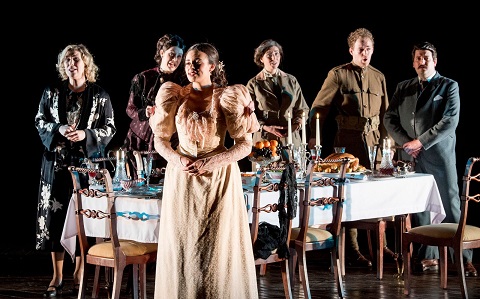 Alexandra Lowe (Lucia), Emily Kyte (Genevieve), Madison Nonoa (Leonora), Carmen Artaza (Mother Bayard).
Alexandra Lowe (Lucia), Emily Kyte (Genevieve), Madison Nonoa (Leonora), Carmen Artaza (Mother Bayard).
The ‘Christmas’ setting indicated by the title is briefly alluded to in the falling snow depicted on the gauze front-cloth, which gathers momentum and weight during the instrumental prelude, but thereafter there is little to suggest a festive mood. A stage direction in Wilder’s play reads: ‘Throughout the play the characters continue eating imaginary food with imaginary knives and forks’; but there is not much indulgence or imbibing in evidence here, apart from the occasional slug from a glass wine goblet.
Instead, births and deaths, marriages and confrontations, financial good fortune and decline, unfold without undue melodrama, as the characters are swept through a panoply of situations and emotions, as is the way with families.
The young singers communicated effectively through Hindemith’s parlando style, each allotted their moment to shine. Of the ‘set pieces’, the love duet, ‘Light is her step on the stair and floor’, between first-generation son Charles (Frederick Jones) and his bride Leonora (Madison Nonoa) sparkled with tenderness. And, when they were joined by mezzo Emily Kyte - who as Charles’s sister, Geneviève - added richness to the vocal textures, there was a beguiling fluidity about the trio ‘How long have we been in this house?’ - the text of which complements the musical motions and motivic recollections of the passing years, and which was deftly interspersed with commonplaces about the children and other family concerns.
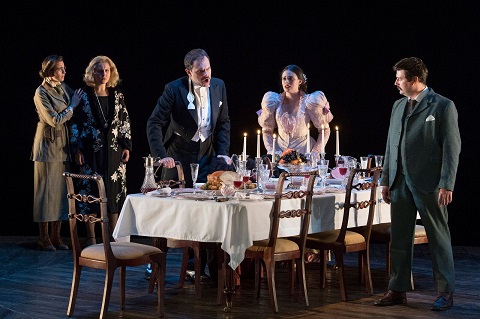 Carmen Artaza (Mother Bayard, Ermengarde), Lucy Anderson (Lucia), Eduard Mas Bacardit (Roderick II).
Carmen Artaza (Mother Bayard, Ermengarde), Lucy Anderson (Lucia), Eduard Mas Bacardit (Roderick II).
Eduard Mas Bacardit provided a welcome dash of conflict, as the rebellious Roderick II who rejects his heritage, scorns his expected assumption of a role in the family business, and resorts to drink to dispel the town’s dullness, eventually departing to seek a ‘town where something happens’. Carmen Artaza summoned a nobility beyond her years as Mother Bayard and touching poignancy in the final reflections of Cousin Ermengarde, whose extinguishing of the table-candles and slow, dignified exit turns off the light of life in the house of Bayard. Bertie Watson was a self-assured cousin Brandon.
Under conductor Dominic Wheeler’s guidance, Hindemith’s wind-based instrumentation chugged and rolled along cleanly and comfortably, and the tempi seemed apt for the unfolding conversational exchanges, though it was a pity that the English text was not uniformly articulated with clarity, given the unfamiliarity of the work and the significance of the minutiae of the dialogue. But, in general, the balance between pit and stage was satisfactory, and aided by Hindemith’s unusual scoring - bass clarinet, double bassoon, and tuba are added to the smallish chamber orchestra - which allows the voices to speak in the registral ‘gaps’.
The climax is a sextet which marks the arrival of World War One, and the departure of young soldier Sam to the battlefield and, we understand, as he traverses the ‘exit’ passageway, to his death. ‘We talk of the weather’ the Bayards sing, for Sam has asked his family to enact a ‘normal’ Christmas Day gathering, so that the family customs and rituals can be implanted in his memory.
I appreciate that the young singers all need their chance to shine, but it seems odd that the creators’ blurring of the distinctions between characters across the generations - which emphasises genealogical linearity, and is supported by musical restatement and recollection - was not respected; in that Alexandra Lowe, who impressed in the role of Lucia, did not then reappear as ‘Lucia II’, her own grand-daughter, subsequently - the latter role being taken by Lucy Anderson. Given that the pair swap roles for two of the four performances, this seems an opportunity missed. In contrast, Lucia I’s husband Roderick - sung with passion by Michael Vickers - also fervently inhabited his grandson Sam’s shoes, fixing his family in his mind with in a soaring avowal, ‘I shall hold this tight! I shall remember you so!’, as Lucy Anderson interruptted his present-memory with her lament, ‘He was only a boy.’
In many ways, Hindemith’s opera is a good choice for a student company as the roles and cameos are of equal weight and presence. But, Ashley Dean’s production feels - unlike Hindemith’s bottom-heavy scoring, which skips with surprising lightness - a little too worthy and solemn; surely the nostalgic reminiscences should be inflected with both joy and pathos? Here the pace and palette were rather uniform.
But, after the heaviness of the first course, Sir Lennox Berkeley’s A Dinner Engagement provided a dessert flavoured with panache and piquancy. Composed for the 1954 Aldeburgh Festival, Berkeley’s satirical comedy of manners - G&S meets P.G. Wodehouse by way of Wilde and Waugh, with a sprinkling of Mitford - is a delightful tale of financial hard times among the aristocracy and mishaps with the Aga, with a dash of acidity to temper the frothy frivolousness.
Both Berkeley’s score and Paul Dehn’s libretto owe much to Britten. The opening trio, ‘Salt, pepper, olive oil’, as the beleaguered delivery boy (an ardently indignant, long-haired Filipe Manu in flares and eye-popping shirt) drops off his wares at the down-at-heel Dunmows’ kitchen, put me in mind of the ‘Cooks’ Duet’ from Paul Bunyan. And, the spirit of Albert Herring looms large - not least because Berkeley’s text-setting is so obviously Britten-inspired, and the orchestration for wind quintet, harp, percussion, string quartet, double bass, and piano recalls those early EOG scores, Lucretia and Herring. But the score is spiced with hints of Stravinsky and Berkeley’s French peers, Honegger, Poulenc, Ravel - and one’s taste-buds are tickled by the gustatory richness.
I have seen this opera performed live only once before, at Wexford in 2012 , but this production immediately reminded me why I had enjoyed it so much on that occasion. It’s an inconsequential bon-bon with a tangy after-taste, presenting the desperate endeavours of an impoverished aristocratic couple to save their financial bacon by using gastronomic guile to lure a European prince to marry their daughter. Chisholm recreates a 1970s kitchen, filling in two sides of the rectangular frame, with gleeful realism: and the Mozartian ensembles tumble by in a spirit of controlled chaos.
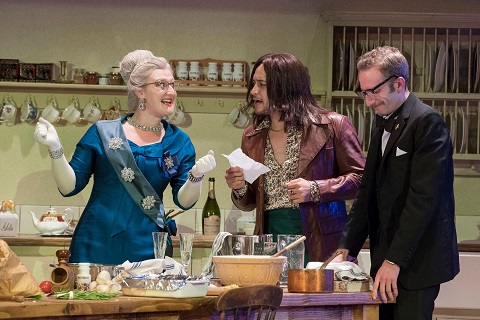 Lucy McAuley (The Grand Duchess), Filipe Manu (An Errand Boy), Samuel Carl (The Earl of Dunmow).
Lucy McAuley (The Grand Duchess), Filipe Manu (An Errand Boy), Samuel Carl (The Earl of Dunmow).
The cast certainly relished the social comedy and caricature. Every time Zoe Drummond’s recalcitrant Susan appeared, dressed in denim dungarees, then lime-green floaty monstrosity, and finally drab brown mini-dress, I could not help but smile. Her soprano floated effortlessly, a souffle of freedom in contrast to the stew of panic around her.
Samuel Carl affirmed his theatrical credentials at the recent Kathleen Ferrier Award Final , and he stepped into the dogged Lord Dunmow’s rather scuffed shoes with aplomb, reminiscing wistfully about former, more prosperous times, when he was Minister Plenipotentiary to the Duchy of Monteblanco, in the opening aria ‘In the Summer of my Time’. Carl and Lucy Anderson (the Countess of Dunmow) made a vocally fetching and dramatically sympathetic pair, singing and acting with confidence and command - even when in ‘Prenez six Belles Tomates’ when they were required to sing and chop vegetables with equal abandon.
Emily Kyle demonstrated terrific comic nous as Mrs Kneebone, the kitchen help who mistakes the front door for the servants’ entrance and who seems more of a hindrance until she, miraculously (how?!), ensures that ‘dinner is served!’. Lucy McAuley’s bejewelled Grand Duchess, entering via the larger back door, was magnificently nonplussed as only the ‘true’ aristocracy can be: how clever the Dunmows are to have decorated their dining room to resemble a twee kitchen! Eduard Mas Bacardit, dapperly attired in military dress, allowed the cookery-obsessed Prince Philippe’s growing interest to burgeon vocally, as he realised that Susan was not at all the sort of society girl he was used to meeting, and was more than ready to debate the required proportions of mustard seed to pickled walnut in a rapturous duet.
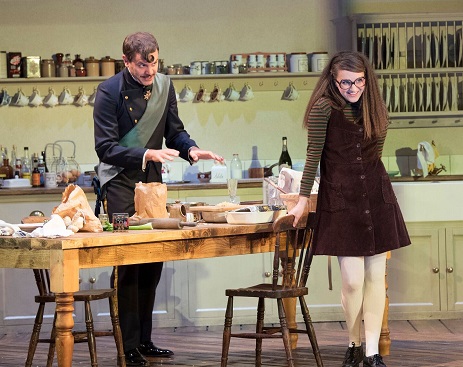 Eduard Mas Bacardit (Prince Philippe), Zoe Drummond (Susan).
Eduard Mas Bacardit (Prince Philippe), Zoe Drummond (Susan).
This was controlled riotousness at its best, but while Mrs Kneebone’s announcement that dinner was on the table brought a sigh of relief, I couldn’t quite suppress a lingering feeling that these talented singers deserved some rather more meaty fare to get their teeth into.
Claire Seymour
Paul Hindemith: The Long Christmas Dinner
Lucia - Alexandra Lowe, Mother Bayard/Ermengarde - Carmen Artaza, Roderick/Sam - Michael Vickers, Brandon - Bertie Watson, Charles - Frederick Jones, Geneviève - Emily Kyte, Leonora - Madison Nonoa, Nurse - Meriel Cunningham, Lucia II - Lucy Anderson, Roderick II - Eduard Mas Bacardit.
Sir Lennox Berkeley: A Dinner Engagement
The Earl of Dunmow - Samuel Carl, Errand Boy - Filipe Manu, Mrs Kneebone - Emily Kyte, The Countess of Dunmow - Lucy Anderson, Susan - Zoe Drummond, Prince Philippe - Eduard Mas Barcardit, the Grand Duchess - Lucy McAuley.
Director - Ashley Dean, Conductor - Dominic Wheeler, Designer - Cordelia Chisholm, Lighting designer - Kevin Treacy, Costume designer - Laura Jane Stanfield, Movement director - Victoria Newlyn, Orchestra of the Guildhall School of Music and Drama.
Silk Street Theatre, Guildhall School of Music and Drama, London; Monday 4 th June 2018.
image=http://www.operatoday.com/Zoe%20Drummond%20%28Susan%29%2C%20Lucy%20Anderson%20%28The%20Countess%20of%20Dunmow%29.jpg image_description=The Long Christmas Dinner and The Dinner Engagement, Guildhall School of Music and DramaRoyal Opera House, Covent Garden product=yes product_title=The Long Christmas Dinner and The Dinner Engagement, Guildhall School of Music and DramaRoyal Opera House, Covent Garden product_by=A review by Claire Seymour product_id=Above: Zoe Drummond (Susan) and Lucy Anderson (The Countess of Dunmow)June 3, 2018
Così fan tutte: Opera Holland Park
Would it not be a typically sentimental coping mechanism adopted to avoid confronting the questions – artificial yet profound, indeed profound through artificiality – it asks of its characters and its audiences alike? If one does not at some level, perhaps the most important level of all, find that Così goes deeper and further than Tristan, then one most likely has not understood either. Given a tragedy without catharsis, a tragedy in the clothes, surpassingly elegant and ravishing, of comedy: sometimes one might ask who needs an opus metaphysicum at all? (We might actually need it in order to recover.)
At any rate, absence had certainly made my heart grow still fonder when it came to Opera Holland Park. Not having been able to visit last summer, I returned to what may well be the most completely successful show I have yet to see and hear there. There is certainly I would put above it, quite a claim, given that we are dealing with Mozart, the most difficult of all composers to perform. There is nowhere to hide, on stage, in the pit, nor indeed in the audience. Nor should there be. Moreover, one had the sense, whether in production or in musical performance – the distinction is far from distinct – that this ambivalent, ambiguous, existentially devastating drama was being enabled, with the lightest of touches, to speak for itself. That does not happen by itself; there is no room for ‘non-interpretation’, for some illusory ‘original’. Yet nor did it ever seem that something was being inflicted on the work. There is room for critique, whether in words or in performance, yet sometimes, as here, the work is so rich that it both offers its own and, perhaps, renders it beside the point.
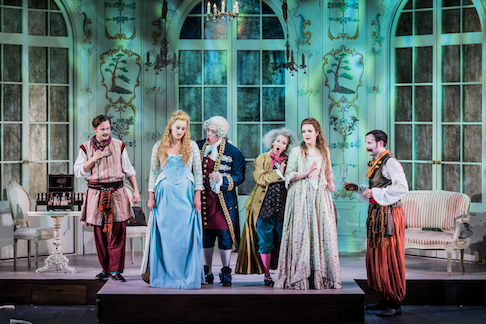 Full cast
Full cast
For what is Così, if it is not a musico-dramatic laboratory, a game whose results we should rather not know, and yet can never quite un-know? We see that in Oliver Platt’s production: not spelled out, ‘in a laboratory’, but actually more or less where it ‘should’ be, in an eighteenth-century setting, in which detail is everything. The more we look at what might seem a straightforward, ‘traditional’ production – and, in a sense, is – the more we see – and hear. The chorus, which like us watches proceedings and occasionally participates, is, from the start, a participant and perhaps a critic. It is not quite the Neapolitan ‘daily passeggio’ of which Leopold Mozart wrote, in a letter quoted by Helen Wallace in the programme, for that was perhaps too obviously theatrical, at any rate too bound to a particular stratum of the social hierarchy: ‘in a few hundred carriages the nobles go out driving in the afternoon until Ave Maria to the Strada Nuova and the Molo.’ These seem largely to be more ‘ordinary’ people, but what is ‘ordinary’? They are like us, perhaps, but they also remind us that we need not be ‘like’, or at least identical to, the principal characters on stage to learn from them. And so, when one looks more closely, one notices an apparently ‘male’ member of the ‘chorus’ in apparently ‘female’ dress. (S)he brings no particular other attention to himself or herself. There is no obvious plotline, no ‘distraction’, as some would have it, rightly or wrongly; there is also no obvious exit strategy for us on heteronormative or other grounds. Così fan tutti/e; or, mutate nomine, de te fabula narratur.
All, however, is not always quite what it seems. For the commedia dell’arte painted faces of Ferrando and Guglielmo are there to start with: visitors, perhaps, from beyond, yet also in need of external transformation – in Tristan, it would be a potion – in order to reveal themselves. Interactions between characters, like those between different chemical elements, are minutely observed, rendering us experimenters of our own, again whether we like it or not. (At least, so long as we watch and listen.) One of the problems some people, not unreasonably, seem to have with this opera is not always appreciating the level of parody, verbal and musical. And so, when Fiordiligi stands on a chair to assume her pose for ‘Come scoglio’, that cruel, loving, and in every sense ravishing seria parody, she initially falters, almost falling (not, I hasten to add, vocally). The watching lovers laugh, and she resumes. All is not quite what it seems, or perhaps it is. That is largely up to us, yet within the framework constructed – or rather within the different, intersecting frameworks constructed, by Alfonso and Despina, by Mozart and Da Ponte, and by production and performers; as well, of course, as that constructed by our own experiences, thoughts, and emotions. We are led to deconstruct that terrifying final ‘moral’ ourselves, Mozart’s brusque neo-Classicism the only possible response to Da Ponte’s seemingly straight hymn to reason. If we do not think about, do not feel its numerous contradictions, we have no one to blame but ourselves – not unlike the characters themselves. Is all perhaps precisely what it seems? Yes and no.
For it is Mozart above all who renders this opera such a necessary agony. And it is the musicians who – with the greatest respect to truly excellent work from everyone else involved, whether in the theatre, behind the scenes, or somewhere in between – who ultimately bring that into life. The City of London Sinfonia offered us gorgeous musical sado-masochism, woodwind one might almost literally have been willing to die for, strings incisive yet far from without warmth of their own. Dane Lam’s tempi began on the quick side, never unreasonably so, yet indicative of an approach one might too readily have taken to be partial. For, as the drama progressed, as the characters achieved greater delineation, so did temporal differentiation. Lam’s was a reading that knew where it was going, and thus could afford to take time on the way – in, for instance, a heartrending ‘Un aura amoroso’.
Not that that would have been heartrending without an estimable Ferrando, of course; that was not, happily, something we needed to put to the test, Nick Pritchard balancing with apparent ease the demands of line and variegation. So too did Nicholas Lester’s Guglielmo, the bitterness of his disillusion moving indeed, his ‘journey’ perhaps the greatest of all. Eleanor Dennis and Kitty Whately likewise proved almost infinitely capable both of sisterly affinity and dramatic disentanglement. So many attributes – sorrow and joy, honour and temptation, simplicity and complexity – were revealed as sides of the same experimental coin. Lines, unadorned or subtly ornamented, exuded both clarity and warmth. We knew them, and yet did not. Sarah Tynan’s Despina was very much the musical catalyst, her cynicism and her sense of fun both vividly portrayed. If Peter Coleman Wright’s pitch was sometimes a little approximate, he brought important dramatic truths to his portrayal of Don Alfonso – perhaps not unlike Francesco Bussani, first in his line. The chorus, well trained, by Richard Harker, could hardly have done more to bring their roles, individual and collective, to life.
There is method in the madness one feels at the close; there has to be. And yet, quite rightly, there remains mystery too. Or, in the ruminations of another operatic character, forced to confront truths of existence he might rather not – at least not too often: ‘Ein Kobold half wohl da:/Ein Glühwurm fand sein Weibchen nicht; der hat den Schaden angericht’t.’ Was Sachs just rephrasing the question? Probably. Are we? Almost certainly. That does not, however, mean that we are not confronting it, that we need not do so. Mozart leads us to Wagner, as well as Wagner to Mozart.
Mark Berry
Cast and production information:
Fiordiligi: Eleanor Dennis; Dorabella: Kitty Whately; Guglielmo: Nicholas Lester; Ferrando: Nick Pritchard; Despina: Sarah Tynan; Don Alfonso: Peter Coleman-Wright. Director: Oliver Platt; Designs: Alyson Cummins; Lighting: Rory Beaton; Opera Holland Park Chorus (chorus master: Richard Harker)/City of London Sinfonia/Dane Lam (conductor). Opera Holland Park, London, Thursday 31 May 2018
image=http://www.operatoday.com/Robert%20Workman%2014.png image_description=Nick Pritchard as Ferrando, Kitty Whately as Dorabella, Sarah Tynan as Despina, Eleanor Dennis as Fiordiligi and Nicholas Lester as Guglielmo in Così fan tutte © Robert Workman product=yes product_title=Così fan tutte: Opera Holland Park product_by=A review by Mark Berry product_id=Above: Nick Pritchard as Ferrando, Kitty Whately as Dorabella, Sarah Tynan as Despina, Eleanor Dennis as Fiordiligi and Nicholas Lester as Guglielmo[Photos © Robert Workman]
The poignancy of triviality: Garsington Opera's Capriccio
In fact, she herself has provided the ‘answer’ to the opera’s dilemma, and this beautiful production by Tim Albery for Garsington Opera - a co-production first seen at Santa Fe in 2016 - which is by turns flippant and serious, frivolous and serene, confirms the truth of the Countess’s earlier words: “denn hier zu wählen, hiesse verlieren.” To make a choice, would result only in loss.
The opera is set in 1777, when Marie Antoinette has just been crowned Queen of France and Gluck is undertaking his ‘reform’ of opera. In a luxurious chateau near Paris, the Countess is worshipped by a composer, Flamand, and the poet, Olivier, who dispute the relative importance of words and music, and ask the Countess, whom they both love, to choose between their respective arts - and, by implication, between them. This love triangle takes place within a salon populated by other artists: a renowned actress, Clairon; an impresario, La Roche (a Straussian alter ego, based also on theatre director Max Reinhardt); the Count (the Countess’s wealthy brother), an amateur actor who is more interested in rehearsing romantic scenes with Clairon than in debating aesthetic theories; two Italian singers; and Monsieur Taupe, a prompter.
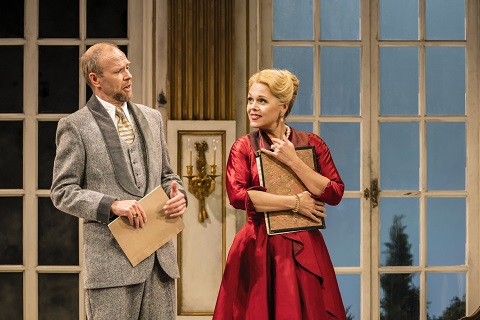 William Dazeley (Count), Miah Persson (Countess). Photo credit: Johan Persson.
William Dazeley (Count), Miah Persson (Countess). Photo credit: Johan Persson.
Pianist Glenn Gould admired Capriccio for its ‘gallant poise and serene literacy’, but others have found it more difficult to experience the work without considering the circumstances in which it was composed. As Alex Ross noted in The Rest is Noise, ‘On August 3, 1941, the day that Capriccio was finished, 682 Jews were killed in Chernovtsy, Romania; 1,500 in Jelgava, Latvia; and several hundred in Stanisławów, Ukraine. On October 28, 1942, the day of the opera’s premiere in Munich, the first convoy of Jews from Theresienstadt arrived at Auschwitz-Birkenau, and 90 percent of them went to the gas chamber.’
Some have condemned the opera as a piece of Kunstegoismus, and declared Strauss guilty of solipsistic indifference to, or at best naïve unawareness of, the political implications of art, even during war. One such was Paul Hindemith, whose music was condemned as degenerate by the Nazis and whom Bertolt Brecht had warned, ‘music is not a Noah’s ark, in which one can escape the flood’.
Director Robert Carsen, in his 2004 production for the Palais Garnier in Paris, set the drama in Occupied France at the time of the opera’s composition. At the Edinburgh Festival in 2007, Christian von Götz’s production for Opera Cologne confronted the audience with a drop curtain depicting German troops marching down the Champs Elysées.
Is Capriccio an escapist fantasy? If so, perhaps one might forgive the elderly Strauss for this active reminiscence on and review of a life’s work in which he deliberately casts his gaze inwards, retreating to an ivory tower of aesthetic theorising, rather than facing outwards to acknowledge the unpleasant reality of the present. But, it’s worth remembering that the opera’s origins began to grow eight years before the Munich premiere in 1942. When Stefan Zweig, the librettist of Die schweigsame Frau, was urged by Strauss to come up with another libretto, he wrote, at the end of January 1934 to say that the following month he would be in London to undertake research in the British Library on ‘all the libretti that the Abbe Casti wrote for Pergolesi who, second-class musician that he was, could not do justice to the great charm and the perfect comedy style of these texts’. In August that year, he mentioned Casti’s libretto for Pergolesi’s ‘Prima la musica e poi le parole’, and the seeds of Capriccio were sown.
Moreover, the original setting similarly preceded the turbulent and bloody years of the French Revolution and the Terror. Who’s to say that in Vienna 1942, in the midst of destruction and horror, art might not have seemed the only way to remind the world of its own humanity? Might Capriccio be not irresponsibly apolitical but rather ‘political’ in the broadest sense?
Director Tim Albery and conductor Douglas Boyd certainly think so, as Boyd explained to me in a recent interview. Albery and his designer, Tobias Hoheisel, have updated the action to the years just after World War II, locating the action in a wealthy philanthropist-patron’s modernist house, the rectilinear regularity, pure colours and clean lines of which recall the architectural aesthetic of Mies van der Rohe. Servants in livery, both modern and traditional, stand erect in spacious vestibules left and right which frame an exquisite replica rococo drawing-room - an exuberance of gilt, glass and ornament, the folly of the hostess who reveres the eighteenth-century.
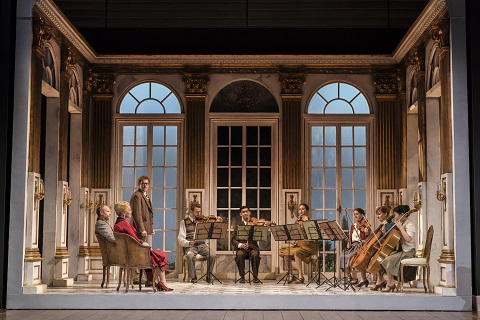 Photo credit: Johan Persson.
Photo credit: Johan Persson.
In the light of Albery’s theatrical conceit, it seems both fitting and ironic that Mies van der Rohe’s fundamental aesthetic principle was that a building should be an expression of its era and materials: ‘I am not interested in the history of civilization. I am interested in our civilization. We are living it. Because I really believe, after a long time of working and thinking and studying that architecture ... can only express this civilization we are in and nothing else.’
On the opening night at Garsington, the enchantment which magically merges two historical epochs began with the first notes of the opening Sextet, performed by two members of the Garsington Opera Orchestra and four students from the Royal Academy of Music, and climaxed in the closing moments, when this interior oasis slid imperceptibly to the front of the stage, bathed in glorious green and blue by lighting designer Malcolm Rippeth, carrying us beyond ‘history’ and into timelessness.
There is no gesture or bustle during the Sextet: the characters, like us, take their seats and listen to the music and the questions that it poses, suggesting that the opera is not so much a denial of reality but a renewal of essential human dilemmas and values.
Albery’s drama is not all abstract theorising, however; there is plenty of self-referential eye-brow raising as the characters complain that it’s fortunate that the music obscures the words in opera, for it saves one having to fathom out nonsensical plots, and in any case the words are banal. The vigorous conversations are companionable and invigorating, and should vehemence risk escalating into violence, civility - and the Countess’s diplomacy - is there to pull things back from the brink, something that modern politicians would do well to heed.
The conversational ease was complemented and enhanced by Boyd, who captured the transparency of the densely motivic score, allowing both the words to be heard without undue effort and the multitude of instrumental motifs to make their mark lightly but lucidly. At moments where Strauss’s own voice in the debate seems to slip to the fore, the music seamlessly blossomed with sumptuously impassioned emotion, but elsewhere the gracious dance forms of the eighteenth-century which seem to underpin the musical discourse carried the drama forward charmingly.
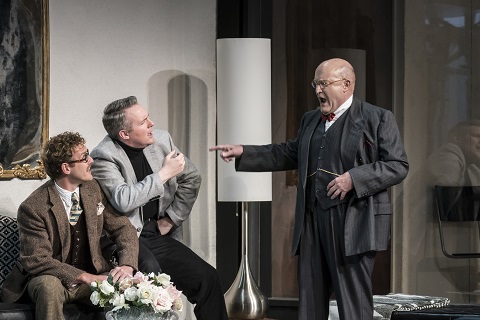 Sam Furness (Flamand), Gavan Ring (Olivier), Andrew Shore (La Roche). Photo credit: Johan Persson.
Sam Furness (Flamand), Gavan Ring (Olivier), Andrew Shore (La Roche). Photo credit: Johan Persson.
The temperature on stage does rise, when La Roche’s plans to stage flamboyantly theatrical productions of the myths of the birth of Pallas Athene and the Fall of Carthage are rudely abused, before the impresario lambasts the pale, young aesthetes, ‘blasse Ästheten’, with a persuasive panegyric against those who condemn the old ways but create nothing new.
No one knows better than Andrew Shore how to exploit the power of ‘theatre’. His La Roche made a nonchalant entrance, a suave riposte to Flamand’s vanity: as the Sextet spun its silken web, La Roche, sipping champagne, strolled breezily across the drawing-room, in search of a leather couch upon which he subsequently took a snooze. But, this does not mean that Shore does not value or articulate musical or dramatic concerns. He sang with vigour, directness and dignity, and La Roche’s arguments communicated with conviction and cogency.
Albery’s choreographic details are engaging. Both suitors have charisma, and they are neatly opposed. While the Sextet rhapsodises, Olivier flicks through his poetry, making annotation; during Olivier’s eulogising, Flamand browses through his score, conducting the music in his mind. Tenor Sam Furness’s sweet-voiced Flamand is delightfully boyish and ardent, lost in his music, inflamed in voice and heart by his passion for his dual muses, music and the Countess. Baritone Gavan Ring effectively conveys the more mature and worldly Olivier’s frustration - and despair, when he decries Flamand’s setting of his sonnet which destroys the rhyme and metre - resonantly surmounting Strauss’s high-lying lines with focus and conviction.
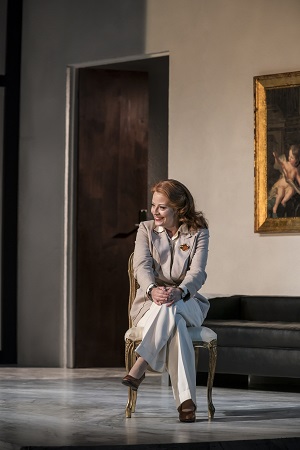 Hanna Hipp (Clairon). Photo credit: Johan Persson.
Hanna Hipp (Clairon). Photo credit: Johan Persson.
William Dazeley’s Count is a heartier baritone, blunt and confident, communicating his aristocratic assurance with vigour. As Clairon, Hanna Hipp wears her tailored cream trouser-suit with style; always in character, she acted superbly and her rich mezzo added plushness and passion to the conversational ensembles.
The Italian singers, Nika Gorič (soprano) and Caspar Singh (tenor) relished the straight-faced parody of their bel canto divertissement, and offered a playful counterpart to the company’s philosophising, as Singh tried to stop Gorič quaffing too much champagne and eating all the cake. Further fun was offered by a diverting interruption by the servants who, taking their seats at the front of the stage during a work-break, reflected wryly on their masters’ theorising - ‘I suppose now they will even want servants to appear in their operas’. They, like Graham Clark’s Monsieur Taupe - the prompter who’s gone to sleep on the job but who is the ‘the invisible ruler of a magical world’ - know what goes on ‘backstage’. Counter-balancing decorum was provided by Lowri Shone’s expressive ballet and by Benjamin Bevan’s self-composed Major Domo.
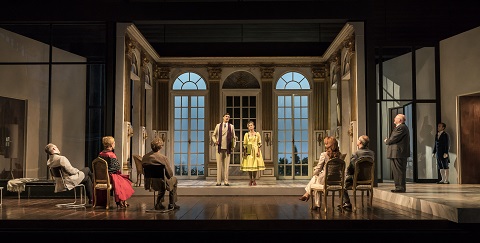 Caspar Singh (Italian Tenor), Nika Gorič (Italian Soprano). Photo credit: Johan Persson.
Caspar Singh (Italian Tenor), Nika Gorič (Italian Soprano). Photo credit: Johan Persson.
But, it is the Countess herself who presides in this opera, which she commissions, inspires, judges and embodies. Miah Persson was the perfect hostess: regal of bearing and manner, tactful but teasing. She sailed sweetly and swiftly through the conversational snatches and soared through Strauss’s expansive arcs with a blend of silvery limpidity and golden gleam - matching the opulence of her own rococo recreation. When she declared, of music, ‘It awakens dark dreams - ineffable/ A sea of awareness - entrancingly beautiful!’, it was as if Strauss himself both spoke and sang.
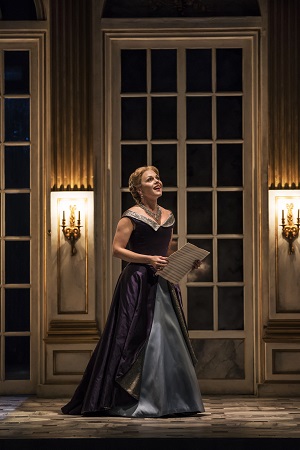 Miah Persson (Countess). Photo credit: Johan Persson.
Miah Persson (Countess). Photo credit: Johan Persson.
At the close the Countess’s sonnet declares the ‘truth’; the dilemma cannot be resolved. We need both music and poetry, in opposition and in harmony, and what is truly essential is, as the sonnet tells, love. And, so, Capriccio must end with a question mark, for the Countess can find no answer ‘that is not trivial’.
The war threatened ‘humanity’ and also destroyed the manifest forms that such humanity took - human culture; when the Munich Nationaltheater was struck during an Allied bombing raid, Strauss wrote, ‘There is no consolation, and, at my age, no hope.” In this regard, the ‘triviality’ of Capriccio is not apathetic, but redolent with pathos - a Romantic cry for beauty and truth in a world of deceit, destruction and dread. Capriccio may, superficially, seem negligently inconsequential but, as Tim Albery and Douglas Boyd show, it gives us hope.
Claire Seymour
Countess - Miah Persson, Flamand - Sam Furness, Olivier - Gavan Ring, La Roche - Andrew Shore, Count - William Dazeley, Clairon - Hanna Hipp, Monsieur Taupe - Graham Clark, Italian Soprano -Nika Gorič, Italian Tenor - Caspar Singh, The Major-Domo - Benjamin Bevan, A young dancer (silent) - Lowri Shone, Servant - Richard Bignall, Servant - Dominic Bowe, Servant - Robert Forrest, Servant - Andrew Hamilton, Servant - Emanuel Heitz, Servant - Jack Lawrence-Jones, Servant - David Lynn, Servant - Kieran Rayner; Director - Tim Albery, Conductor - Douglas Boyd, Designer - Tobias Hoheisel, Lighting Designer - Malcolm Rippeth, Choreographer - Laïla Diallo, Garsington Opera Orchestra/Onstage string sextet, in association with the Royal Academy of Music.
Garsington Opera, Wormsley; Friday 1st June 2018.
Image=http://www.operatoday.com/Cap%20final%20scene.jpg image_description=Capriccio, Garsington Opera 2018 product=yes product_title=Capriccio, Garsington Opera 2018 product_by=A review by Claire Seymour product_id= Above: Miah Persson (Countess)Photo credit: Johan Persson
June 1, 2018
Netia Jones' new Die Zauberflöte opens Garsington Opera's 2018 season
The white Palladian façade is adorned with intersecting etchings of the sacred geometry of Freemasonry - the divine proportions of the Golden Rectangle, the Pythagorean triangles which embody Euclid’s 47th proposition, Fibonacci spirals whose circles represent the spiritual realm, and algebraic letters and numerals in a gracious font. We can have little doubt that in her new production of Die Zauberflöte for Garsington Opera, Jones intends to dabble playfully and portentously with the heraldry and rituals of Freemasonry. As the spritely overture scampers through its paces, bookended by noble orchestral pillars, Masonic brothers stride solemnly across the chequer-board terrace, circling the ornamental hedges and camera obscura, clutching clipboards upon which they scribble architectural notes and calculations; or climb ladders to make measurements and markings on the towering walls; or ‘square up’ a design perched on an easel.
Jones’ beautiful set brings the Garsington garden into the Pavilion. The mathematical symmetries of topiary, sun-dial, and triangular folly-frames recall Peter Greenaway’s The Draughtsman’s Contract with its exaggerated artificiality, numerical and iconographic games, excessive wigs, costume colour-coding and obsession with optical devices. But, there’s a dash of Alice in Wonderland, too, in the formal decorum from which topsy-turvy confusion and troubling ambiguity threaten to break free.
And, there is indeed plentiful darkness in Jones’ conception; the surveillance cameras atop the façade are a sinister ornamentation, and as events unfold a surreptitious camera-man monitors proceedings which are relayed to the CCTV units installed in the Hallowed Hall.
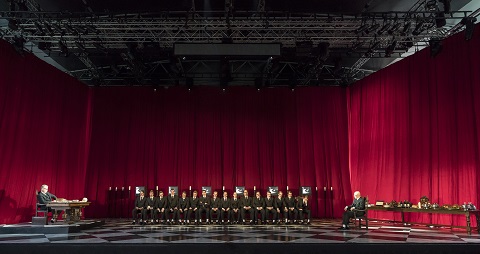 James Creswell (Sarastro), Richard Burkhard (Speaker) with Garsington Opera Chorus. Photo credit: Johan Persson.
James Creswell (Sarastro), Richard Burkhard (Speaker) with Garsington Opera Chorus. Photo credit: Johan Persson.
Act 2 takes us into the latter - framed with luxurious curtains of crimson-velvet and equipped with high altar and table of epicurean victuals. Behind the high-backed, dark-wood chairs, interspersed between mounted candles, six pedestalled television screens project the Masonic ‘G’ - in Hebrew called Gheemel (or Gimel), and associated with the numerical value of 3 - which stand for the God who is Great Architect of Universe and for Geometry, the fifth science (and also allude perhaps to Garsington itself) upon which architecture and Freemasonry were founded. The Masonic Eye, too, stares unblinkingly from the screens, a symbol of the watchful Eye of God and of the Eygptian deity, Osiris, whose hieroglyphic gaze oversaw the ancient temples.
In Jones’ production, however, such motifs take on the sinister omnipresence of an Orwellian telescreen. Sarastro is not known for his feminist liberalism - he warns Tamino against the ‘arrogant’ Pamina: ‘A man must guide your heart,/for without that, every woman/tends to overstep her natural sphere’ - and here Freemasonry is more than an esoteric men’s club. Its Gnostic philosophy, rituals and colour symbolism are overlain with echoes of and imagery from Margaret Atwood’s The Handmaid’s Tale: such as the face-obscuring bonnets worn by the hooded women whose labouring - clearing away wine goblets, wiping the marbled floor, polishing the imposing wood - sustains masculine privilege and power. A deliberate impediment, these ‘wings’ act as blinders on the female vision and restrict communication - a silent seclusion foreshadowed by the scold’s bridle within which the Three Ladies imprison the indignant, garrulous Papageno.
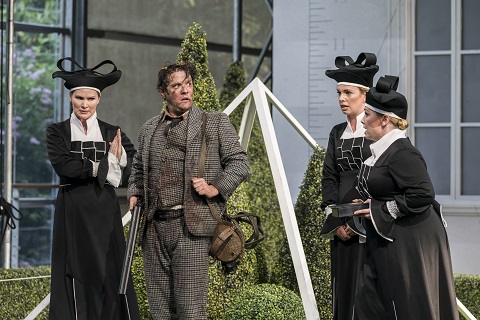 Marta Fontanals-Simmons (2nd Lady), Jonathan McGovern (Papageno), Katie Stevenson (3rd Lady), Katherine Crompton (1st Lady). Photo credit: Johan Persson.
Marta Fontanals-Simmons (2nd Lady), Jonathan McGovern (Papageno), Katie Stevenson (3rd Lady), Katherine Crompton (1st Lady). Photo credit: Johan Persson.
For, darkness and light, good and evil, enlightened and repressed are not black-and-white categories in Jones’ production. She taps into the historical conflict between the Masons and the Catholics, drawing upon the real-life history of one of Wormsley Hall’s former inhabitants, Colonel Adrian Scrope, who played a pivotal role in the conflict that saw an English king beheaded, and Jacobite subversion intertwine with papal condemnation of Freemasonry.
So, the Queen of the Night - bent over an ebony cane and shrouded in black lace, like a mourning Queen Victoria marred with distorted Pierrot-tears - clutches a silver chain from which dangles a crucifix and is accompanied by a red-cloaked Inquisitorial Priest who rudely mis-handles the Holy Books and Masonic gavel resting on the altar, in defiance of the Master of the Lodge’s assumption and exercise of power.
Jones largely eschews the pantomime elements of Schikaneder’s conception: there is no fantastical serpent, rather a salmon-pink pipe which threatens to drown Tamino in his metal-bath when a hydro-electric initiation rite is sabotaged by one of the Three Ladies’ mischievous messengers. Similarly, Papageno is no folksy fall-guy: he arrives, wearing a grubby checked-suit, clutching a rifle and a cage of dead birds, and during ‘Der Vogelfänger bin ich ja’ skins a rabbit, only breaking off to pounce on an unfortunate blackbird that lands on the pristine lawn and wring its neck.
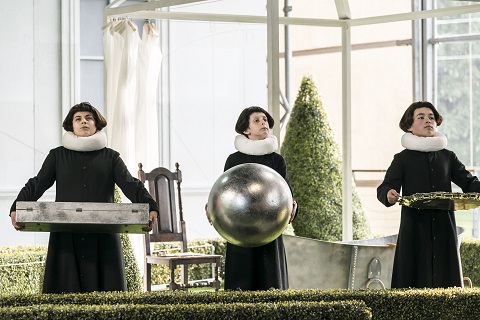 Three Boys (Dionysios Sevastakis, Frederick Jemison, Lucas Rebato). Photo credit: Johan Persson.
Three Boys (Dionysios Sevastakis, Frederick Jemison, Lucas Rebato). Photo credit: Johan Persson.
But, there remains a sense of fun and fantasy. The Three Boys, sporting brutal page-boy hair-cuts and white ruffs, glide elegantly on white roller-skates amid the maze; the Three ladies whip out an I-pad, rather than a formal miniature, so that Tamino can admire the Queen’s beautiful daughter as she frolics with delicate grace.
Jones balances danger and daftness: Pamina’s reddened wrists speak of suffering, while Monostasos dons a butcher’s apron and is accompanied by a team of tattooed heavies clutching cleavers and meat-hooks from which dangle dripping joints of meat. But, through the darkness shine chinks of light. There are hints of liberation to come when the dulcet strains of Tamino’s ‘pipes’ - a prototype gramophone replacing the conventional magic flute - do not charm the feral beast but ‘digitally’ open the windows of Sarastro’s Lodge and temporarily release the hooded women from bondage, permitting them a few moments of communion and conversation. The ‘hand-maidens’ sneakily peer at the rituals in the Hall and giggle over the handsome prince, and at the close Papagena escapes by climbing through a window to stand astride in hunting boots and orange jodhpurs which match her gloriously tumbling red locks, flinging a dead bird aside as she points a hunting gun at Papageno whom she has firmly in her romantic sight-lines.
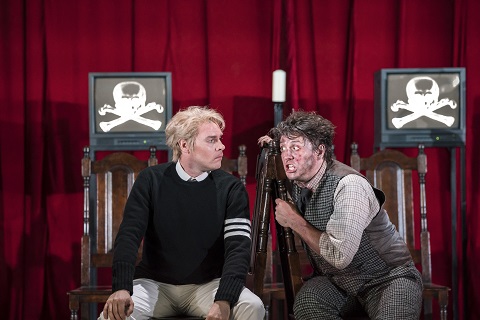 Benjamin Hulett (Tamino), Jonathan McGovern (Papageno). Photo credit: Johan Persson.
Benjamin Hulett (Tamino), Jonathan McGovern (Papageno). Photo credit: Johan Persson.
If this all sounds like too many concepts and convergences, then the strands may well be too numerous and coincidental to cohere with clarity. But, Jones is aided by a superb cast. Benjamin Hulett’s prince exudes confidence and poise from the first; ‘Dies Bildnis ist bezaubernd schön’ is suavely shaped with earnestness and purpose, and this Tamino is every inch the hero. Indeed, he needs every ounce of resolution and reason, for his be-trousered Pamina, Louise Alder, is no passive heroine. The shining gleam of Alder’s soprano is complemented by the forthrightness of feisty self-determination. When Monostatos threatens to drag her back to captivity, Pamina grabs Papageno’s gun to ward off her abusive assailant and his mindless gang - a more effective deterrent than the bird-catcher’s chimes. ‘Ach, ich fühl’s’ aches with beautiful limpidity and real anguish, the falling phrases dropping exquisitely, like delicate gasps of suffering.
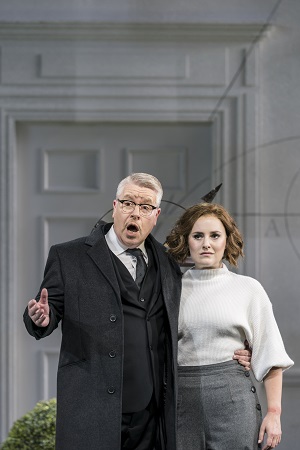 James Creswell (Sarastro), Louise Alder (Pamina). Photo credit: Johan Persson.
James Creswell (Sarastro), Louise Alder (Pamina). Photo credit: Johan Persson.
Jonathan McGovern uses his rich, rounded baritone to inject beguiling character-colour into a Papageno deprived of his customary bumpkin appeal; this bird-catcher is no fairy-tale huntsman but is full of genuine and changing emotions. In ‘Bei Männern welche Liebe fühlen’, he and Pamina reflect on the duties of marital love - “higher purpose is our guide,/ and nothing is nobler than Wife and Man./ Man and Wife, and Wife and Man,/ attain divinity”, a potent contradiction to Sarastro’s misogyny - as Pamina smartens Papageno up in readiness for romance, picking the dirt and dust from his jacket, and tidying his hair. And, her make-over does the trick: at the close, Papageno and his longed-fore Papagena (a sparklingly vivacious Lara Marie Müller) gleefully anticipate the multiplying brood they will spawn as they stumble out of their clothes with comic enthusiasm and affection.
As the Queen, Sen Guo impressed with the beautiful fullness of her stratospheric ascents, more than compensation for an occasional lack of glinting edge. Her Three Ladies - Katherine Crompton, Marta Fontanals-Simmons and Katie Stevenson - formed a particular mellifluous trio, the individual voices distinctly characterised and sweetly blended. Adrian Thompson’s Monostatos was, if rude of manner, sufficiently eloquent vocally to win at least a little of our sympathy. James Creswell was stentorian but warm of tone as Sarastro, balancing menace with benevolence. Any threat that the former might preside was undercut by Jones’ deft and wry direction: ‘O Isis und Osiris’ was punctuated by voting rounds, signalled by the orchestra’s ‘three knocks’, in which the brotherhood were gradually cajoled into their raising hands in agreement, before the soporific effects of wine and Sarastro’s wordiness led heads to nod. This was typical of the detailed choreography which characterised the production, and the Three Boys were as deft at rescuing first Pamina and then Papageno from their suicidal miseries as they were wicked on wheels.
In the pit, Christian Curnyn largely ignored the weightiness of the accumulating concepts on stage and allowed the score to run lightly and fleetly. The weavings of the oboe and clarinet, the enlightened singing of the flute, the propulsion driven by the bassoon, elegant strings and noble horns all lifted the spirits. The overture was pacy and though Curnyn allowed for a little spaciousness at the start, he did not let the spoken dialogue and sequence of slow-ish arias in Act 2 create a lull.
In this visually enchanting and intellectually thought-provoking production, Jones interweaves copious ideas into a multifarious concept which has the sophisticated unfathomability of a calculus equation. But, that seems to be her point: counter-voices and compromise are the antidote to oppressive totalitarianism. The ‘cleverness’ never excludes human warmth and love. And, at the close, the azure blue skies and cotton wool clouds which beam from the Masonic telescreens push aside the Queen’s nocturnal thunderstorms - and those cumulonimbus that threatened to deluge the first night of this summer’s festival - as characters and audience alike emerge from Alice’s nightmare to return to a more enlightened reality.
Claire Seymour
Mozart: Die Zauberflöte
Pamina - Louise Alder, Tamino - Benjamin Hulett, Papageno - Jonathan McGovern, Sarastro - James Creswell, Queen of the Night - Sen Guo, First Lady - Katherine Crompton, Second Lady - Marta Fontanals-Simmons, Third Lady - Katie Stevenson, Monostatos - Adrian Thompson, Speaker - Richard Burkhard, Papagena - Lara Marie Müller, Elder - Adam Temple-Smith, Elder - James Ioelu, First Boy - Aman de Silva, Second Boy - Lucas Rebato, Third Boy - Frederick Jemison, Red Priest (silent) - Stuart Thorn; Director/Designer - Netia Jones, Conductor - Christian Curnyn, Lighting Designer - Mark Jonathan, Garsington Opera Orchestra & Chorus.
Garsington Opera, Wormsley; Thursday 31st May 2018.
Image=http://www.operatoday.com/Zauberflote%20Act%201%20Snelling.jpg image_description=Die Zauberflöte, Garsington Opera 2018 product=yes product_title=Die Zauberflöte, Garsington Opera 2018 product_by=A review by Claire Seymour product_id= Above: Garsington Opera Chorus, Katie Stevenson (Third Lady), Marta Fontanals-Simmons (Second Lady), Katherine Crompton (First Lady), Sen Guo (Queen of the Night), Benjamin Hulett (Tamino), Stuart Thorn (Red Priest)Photo credit: John Snelling